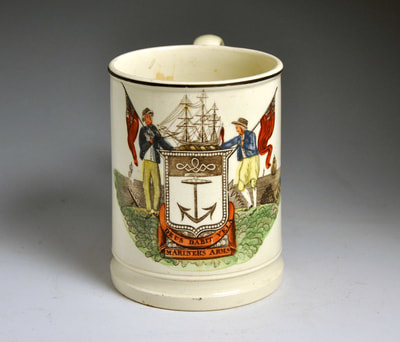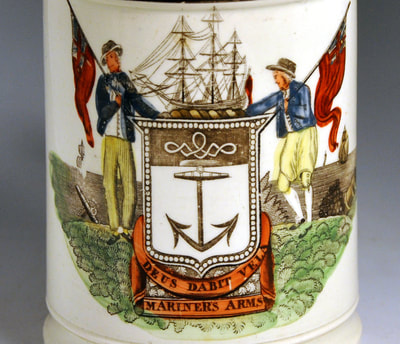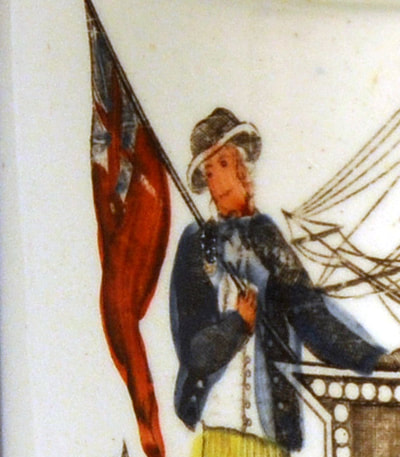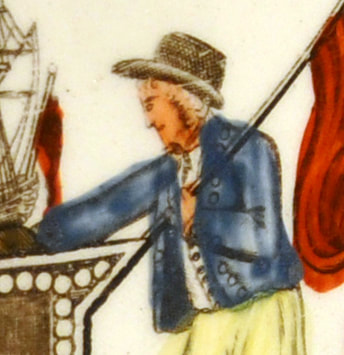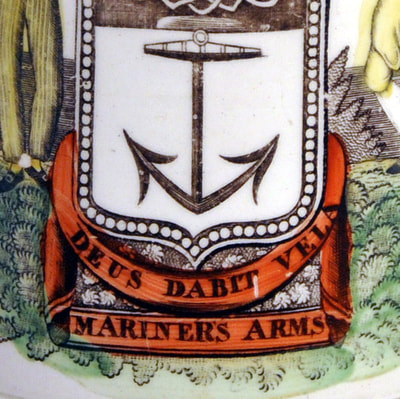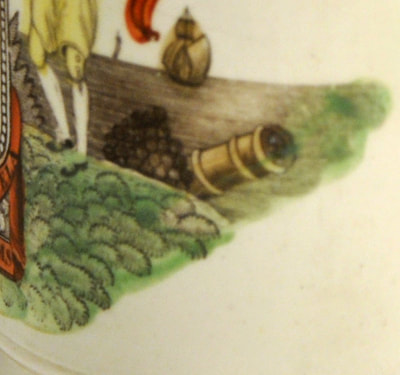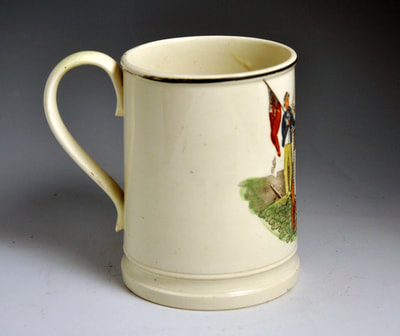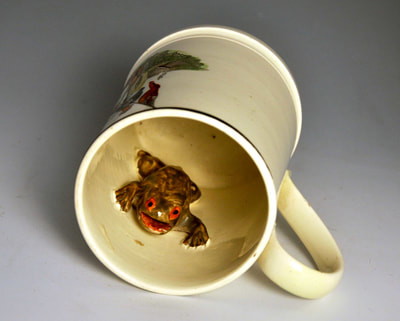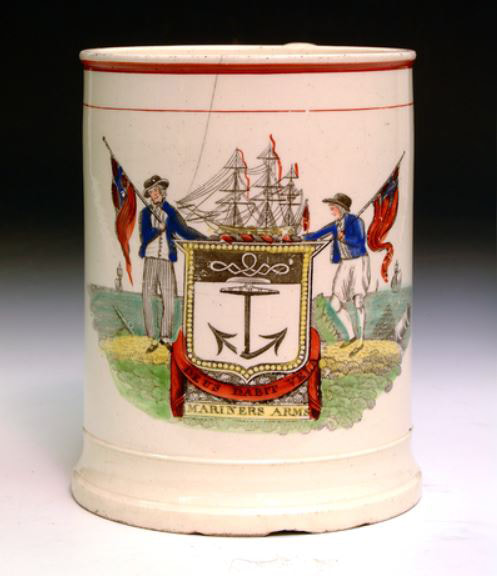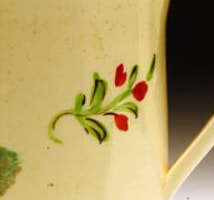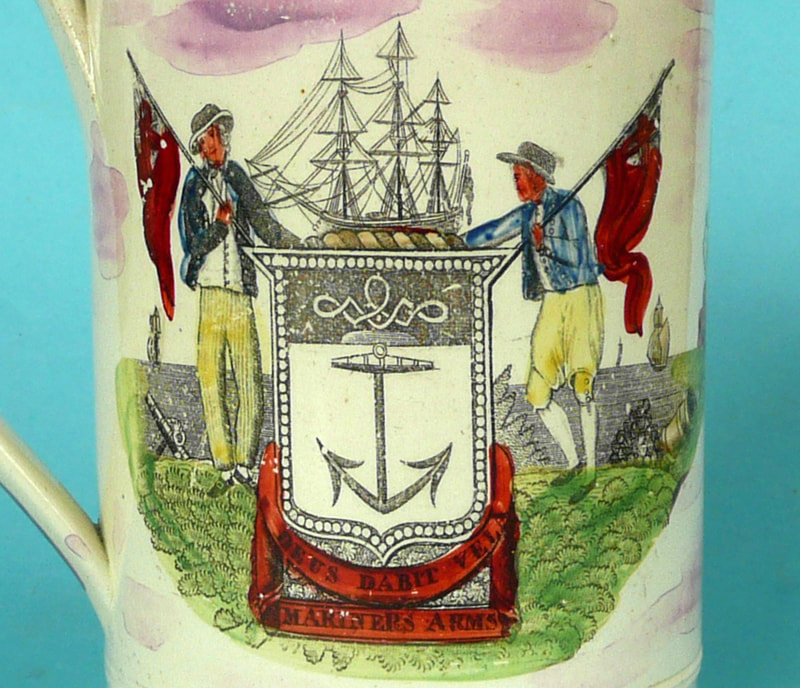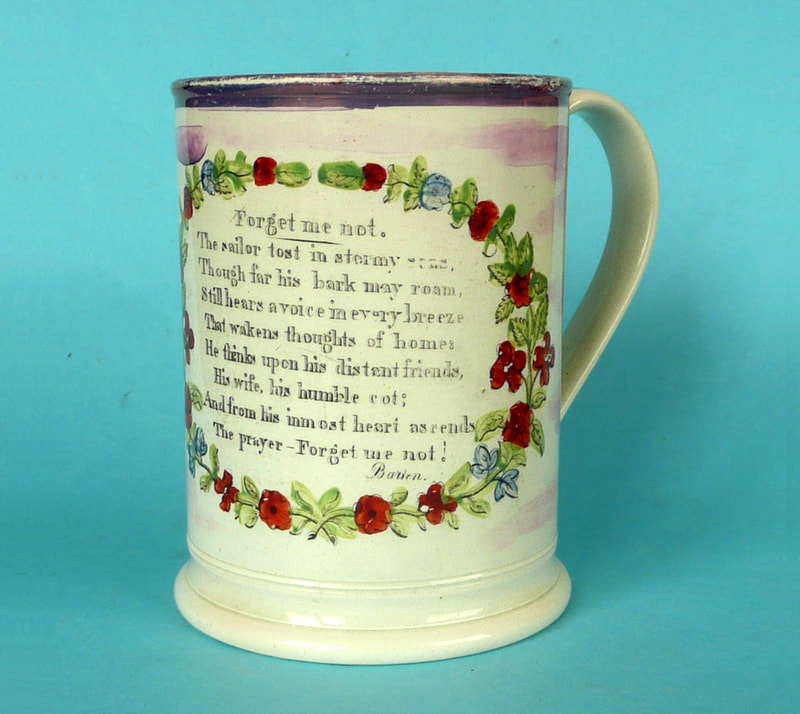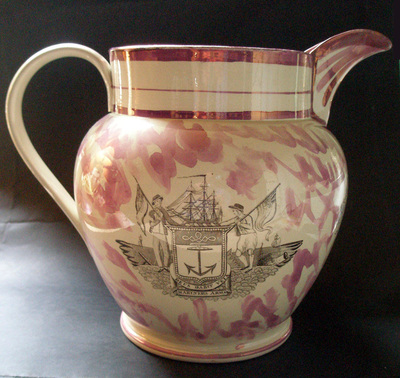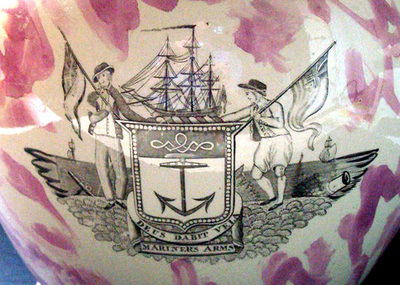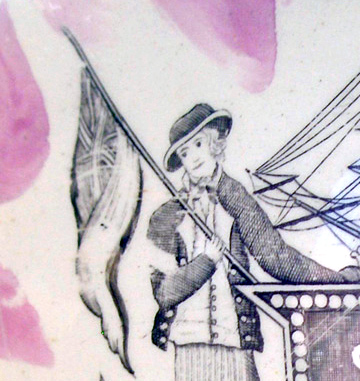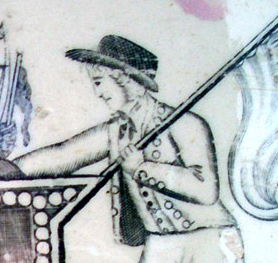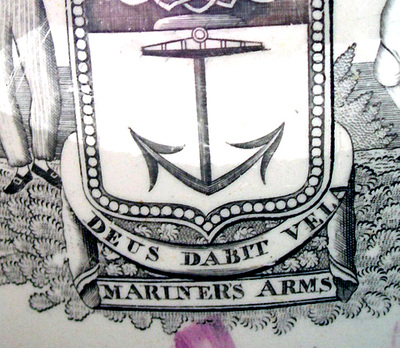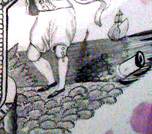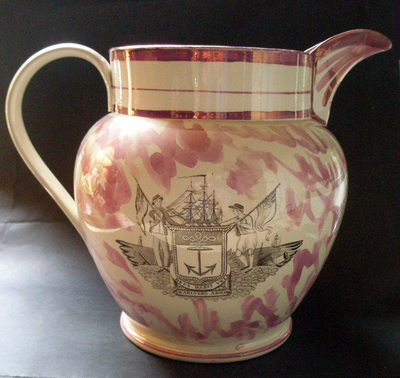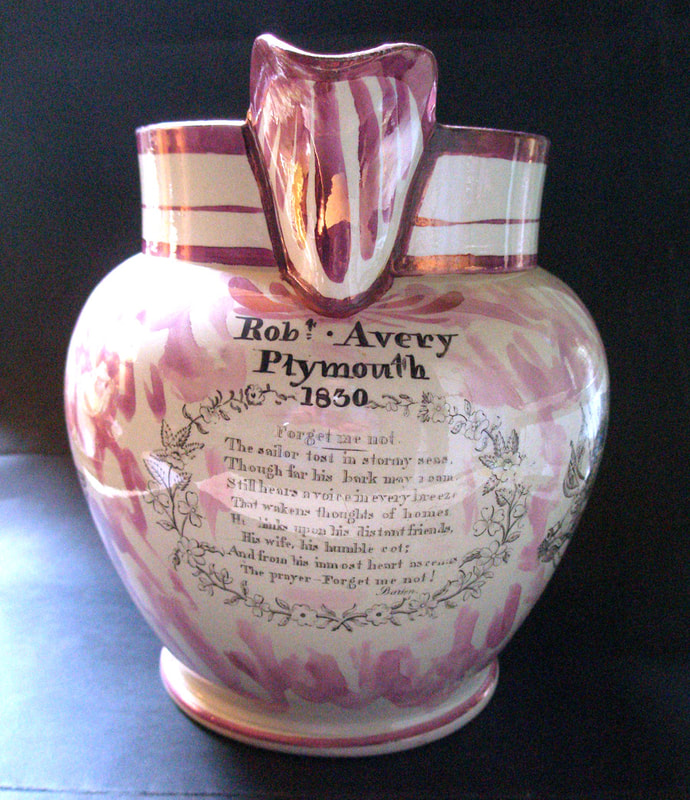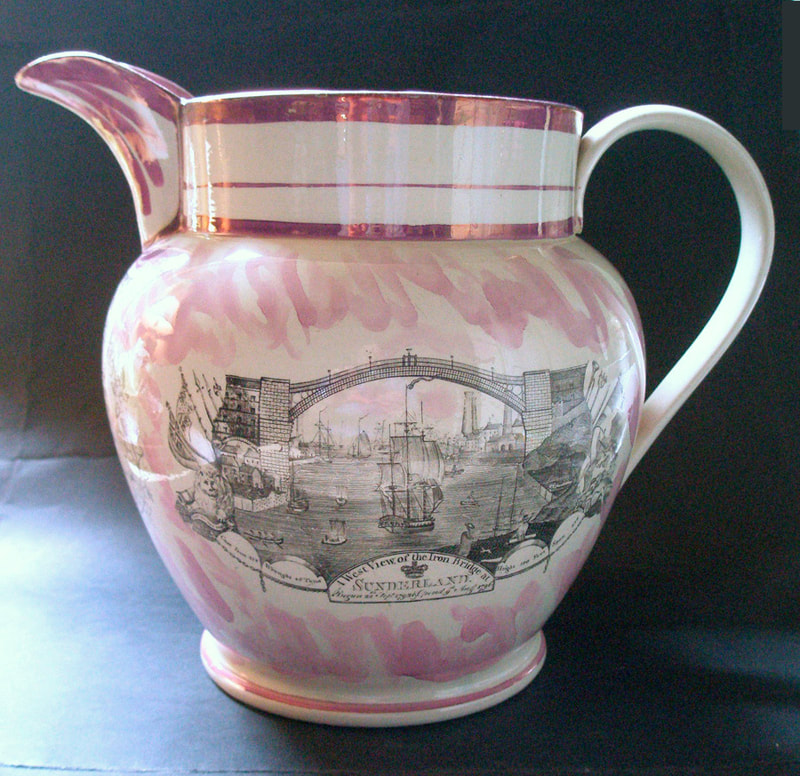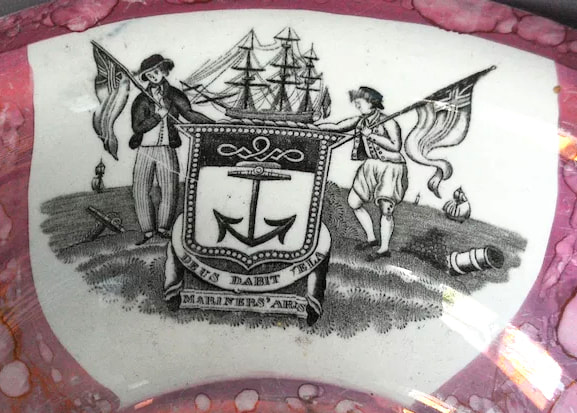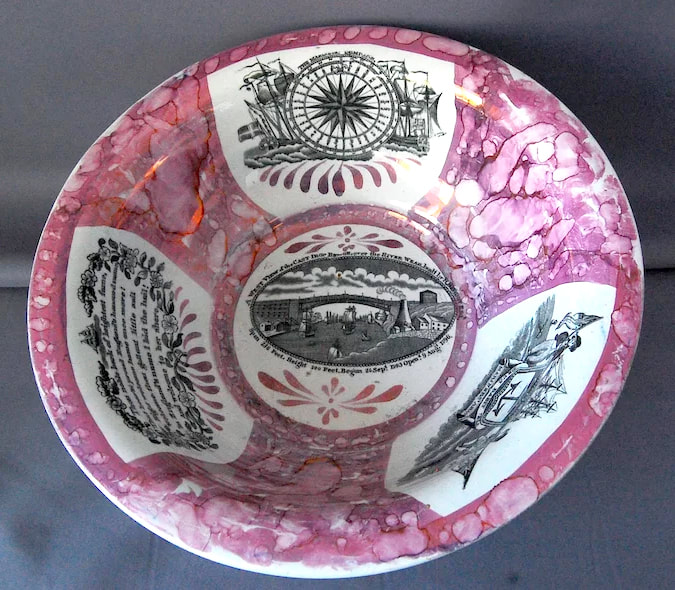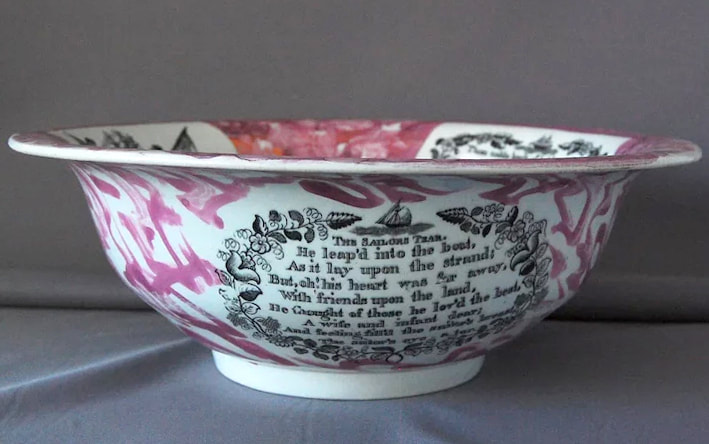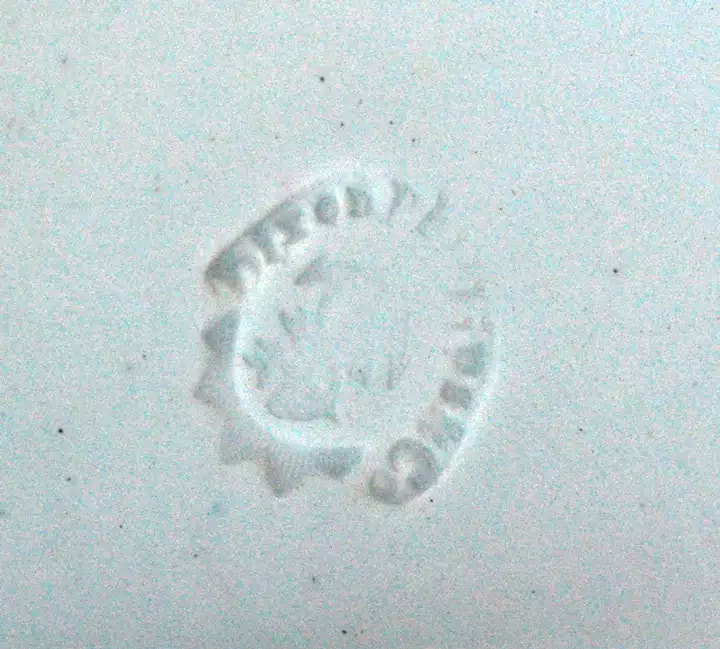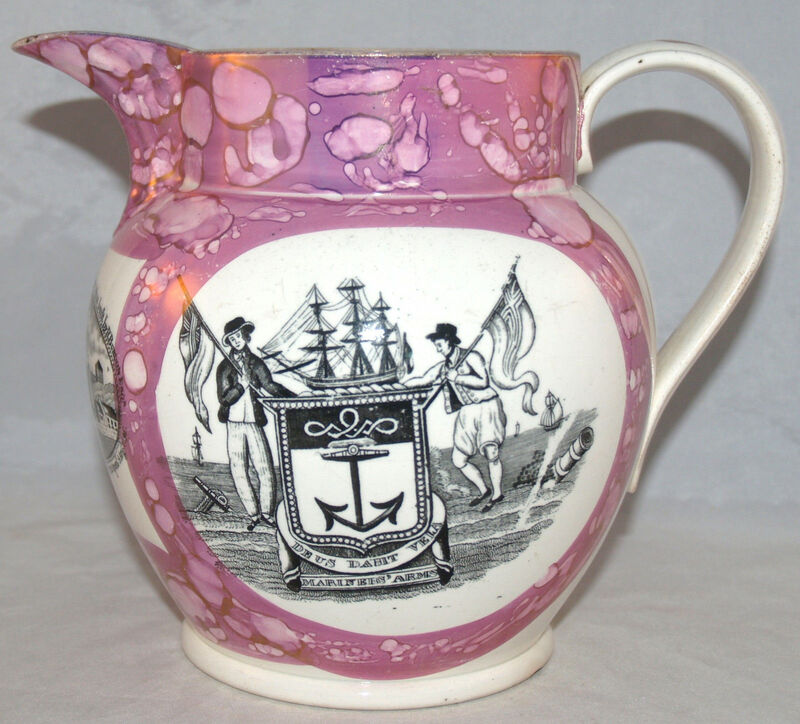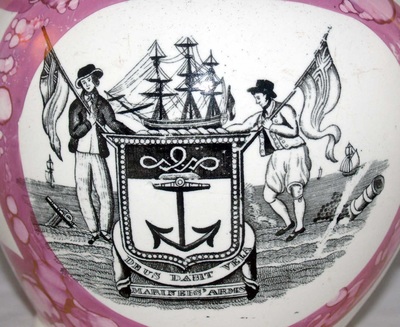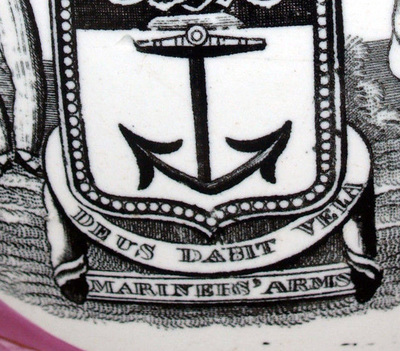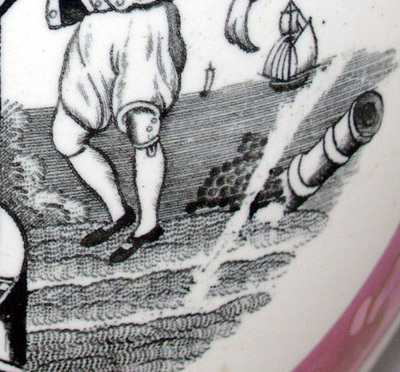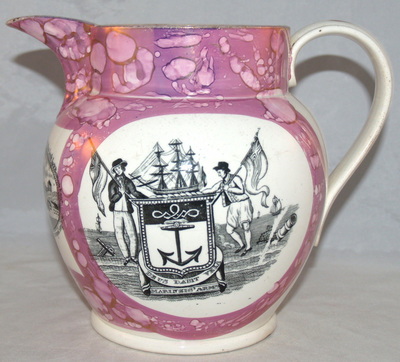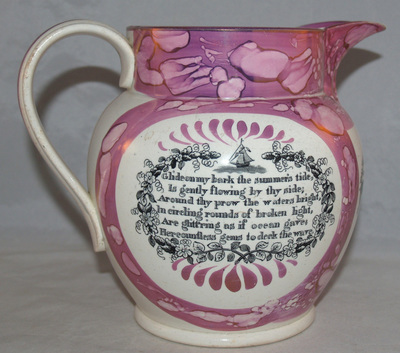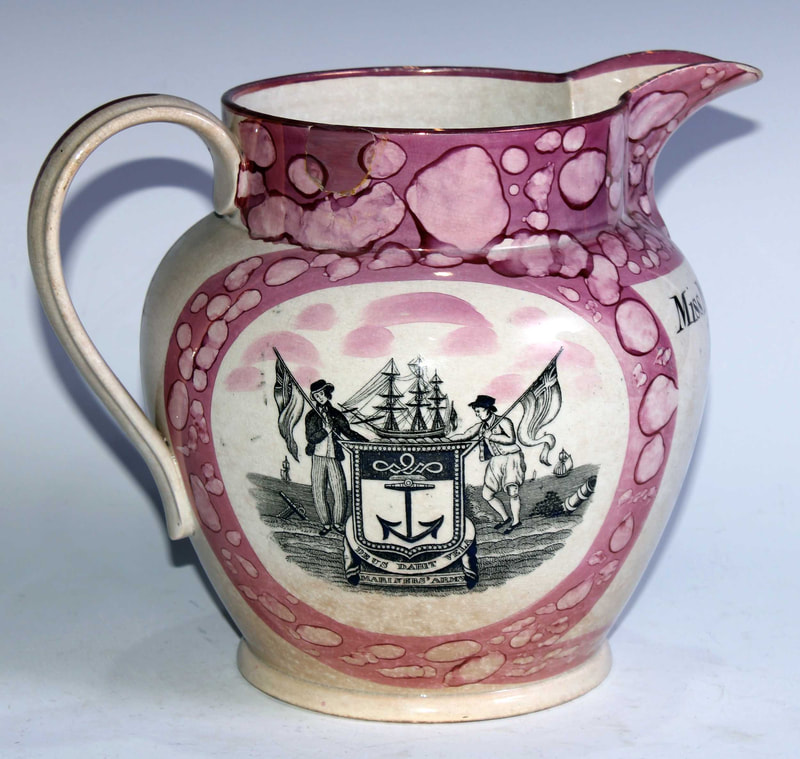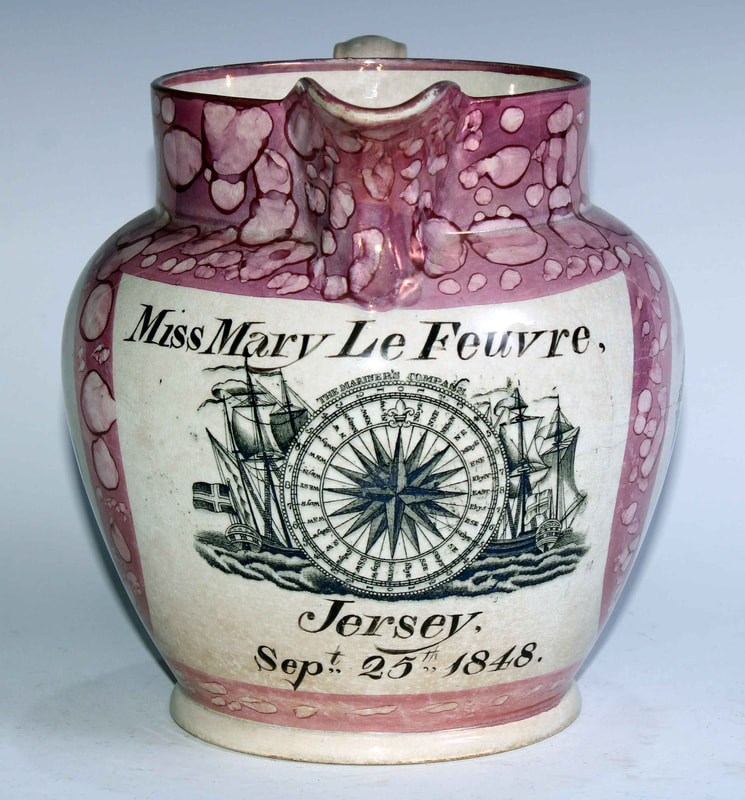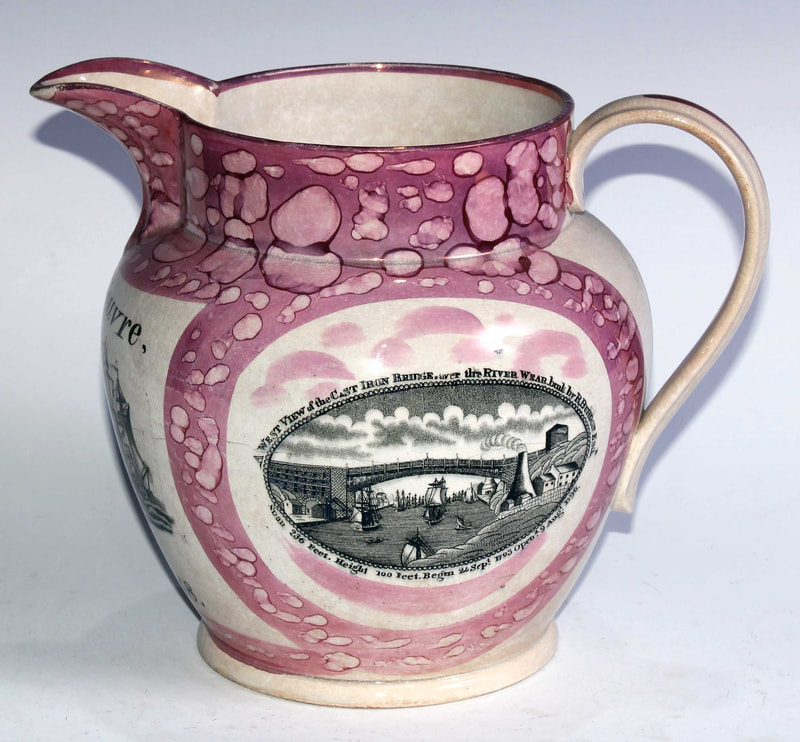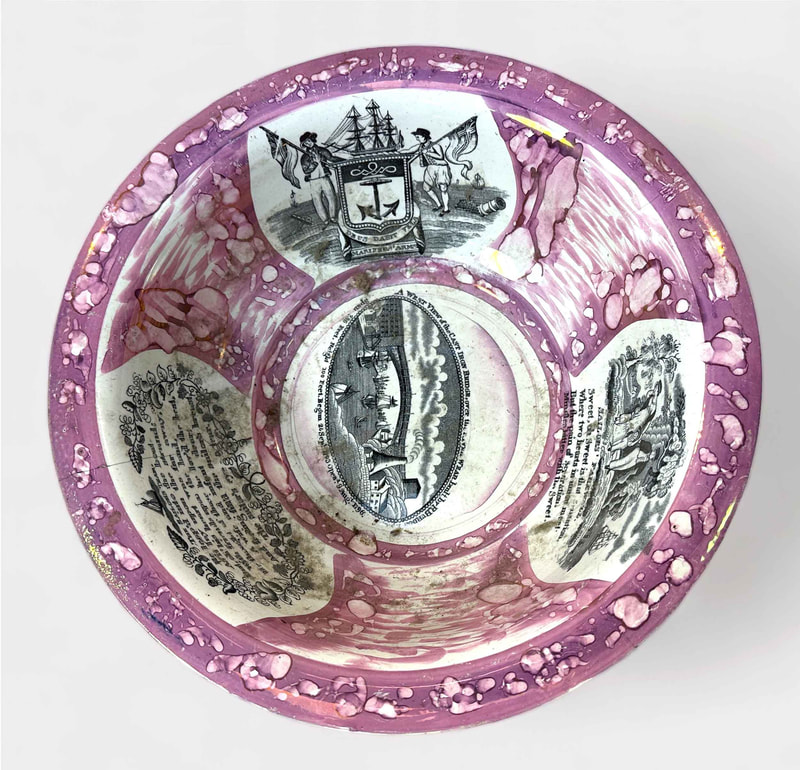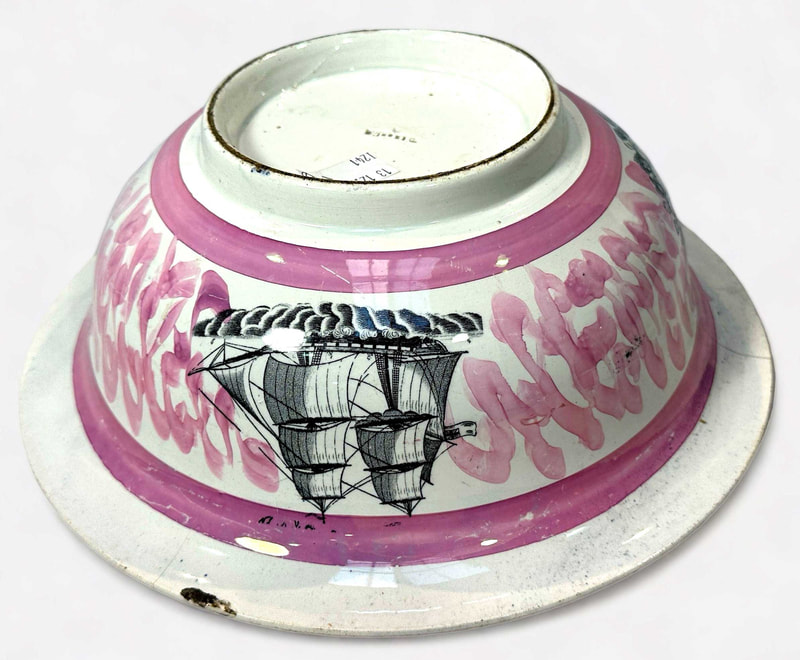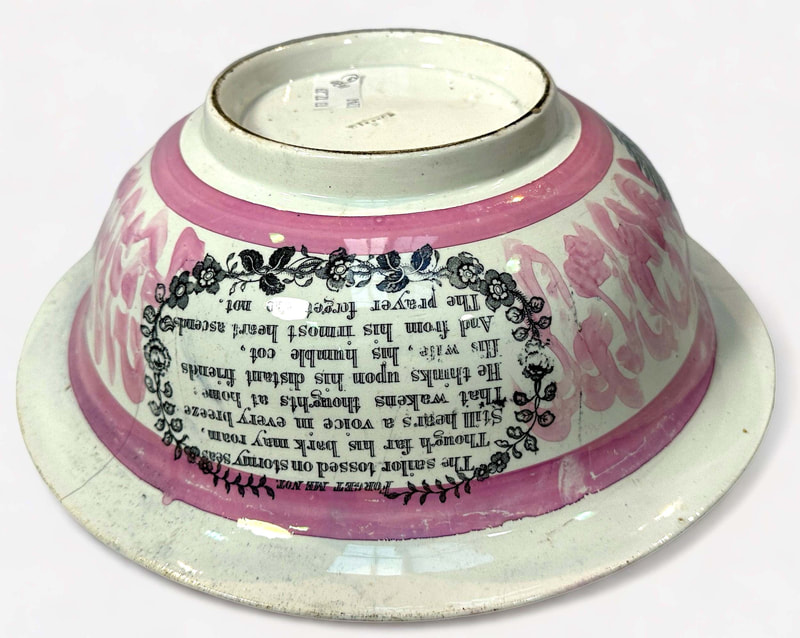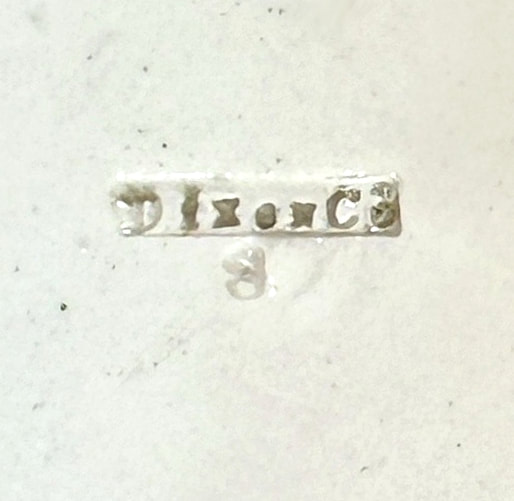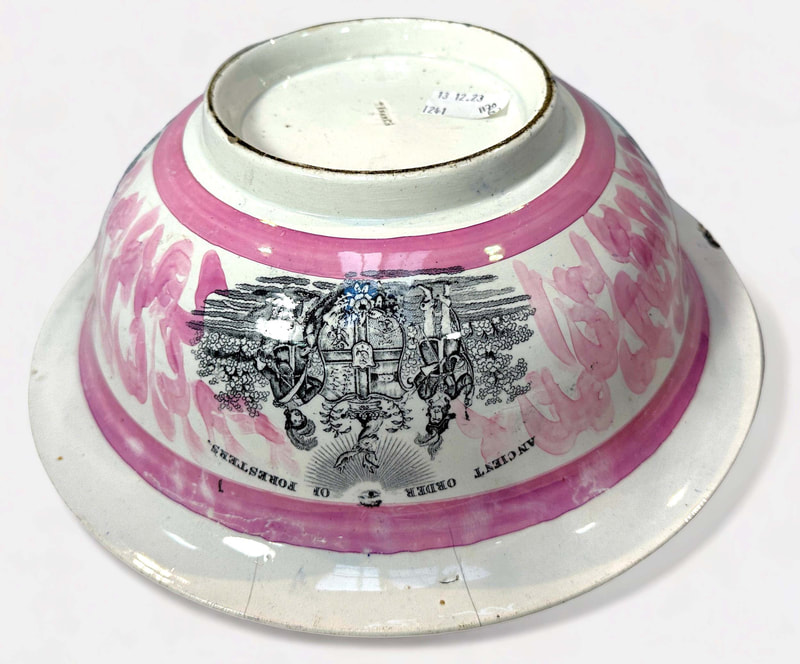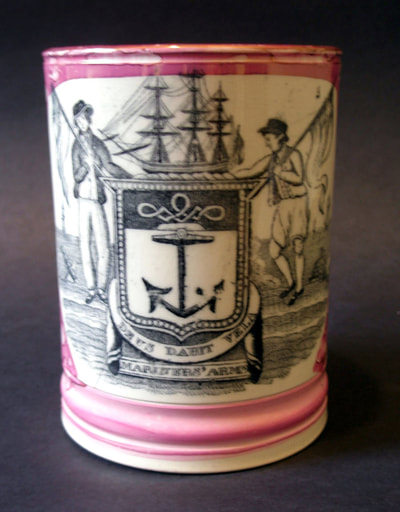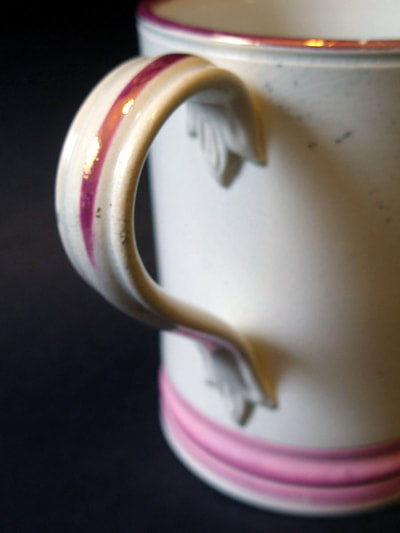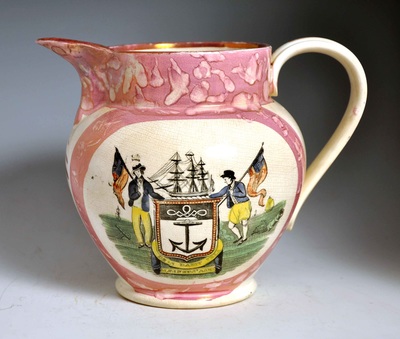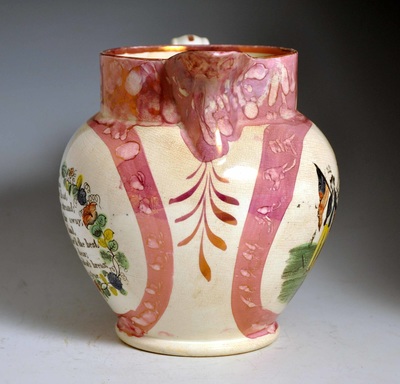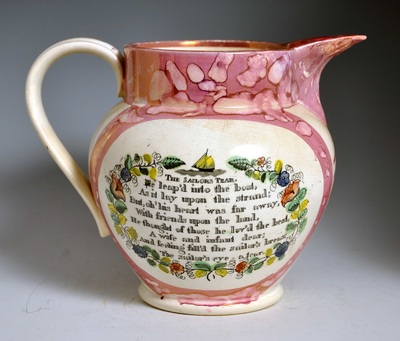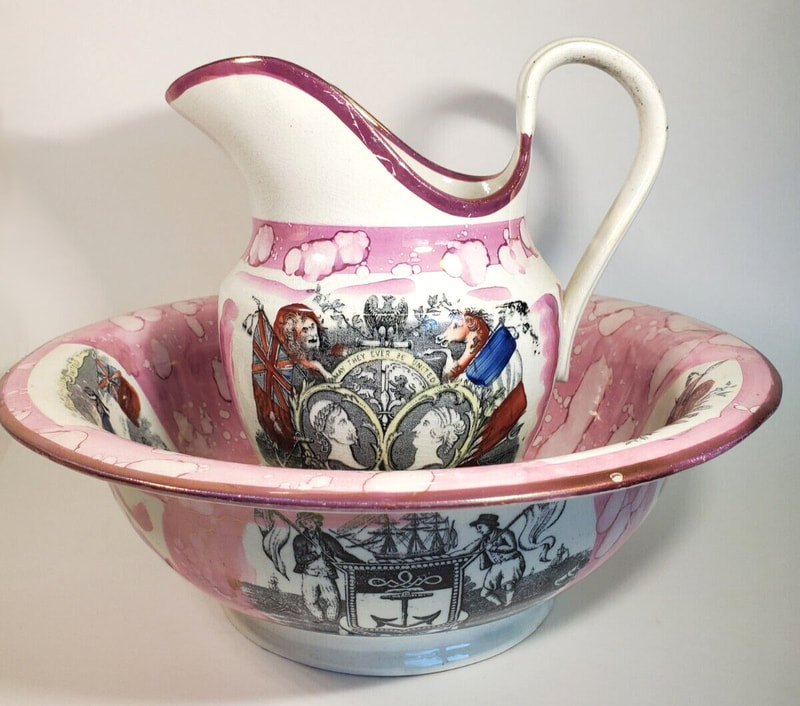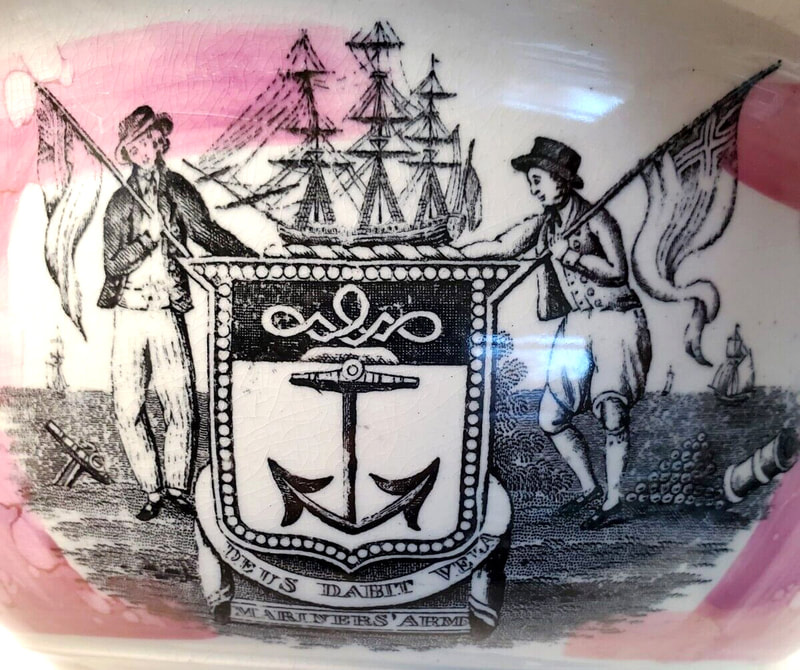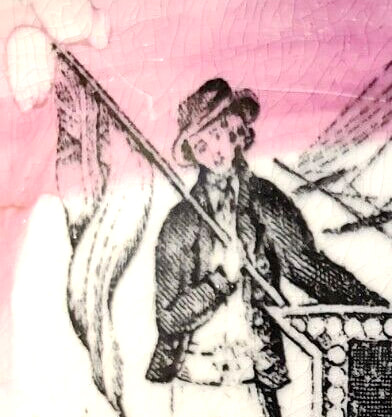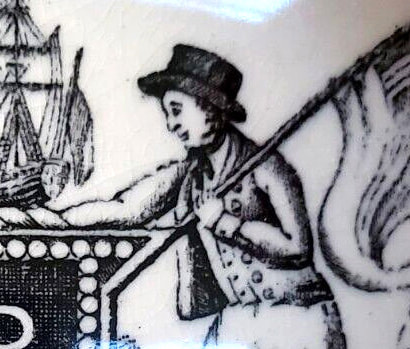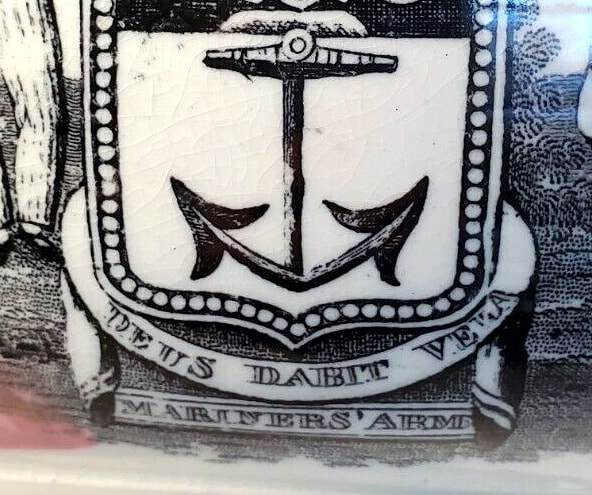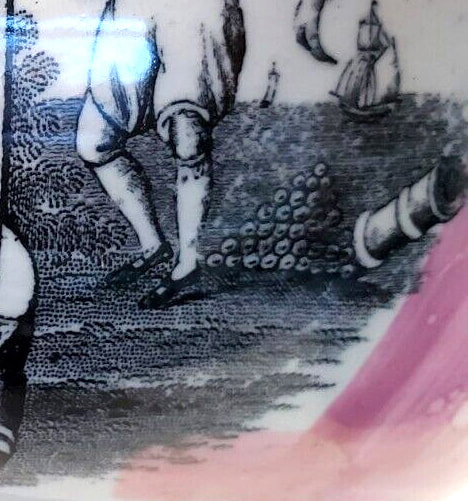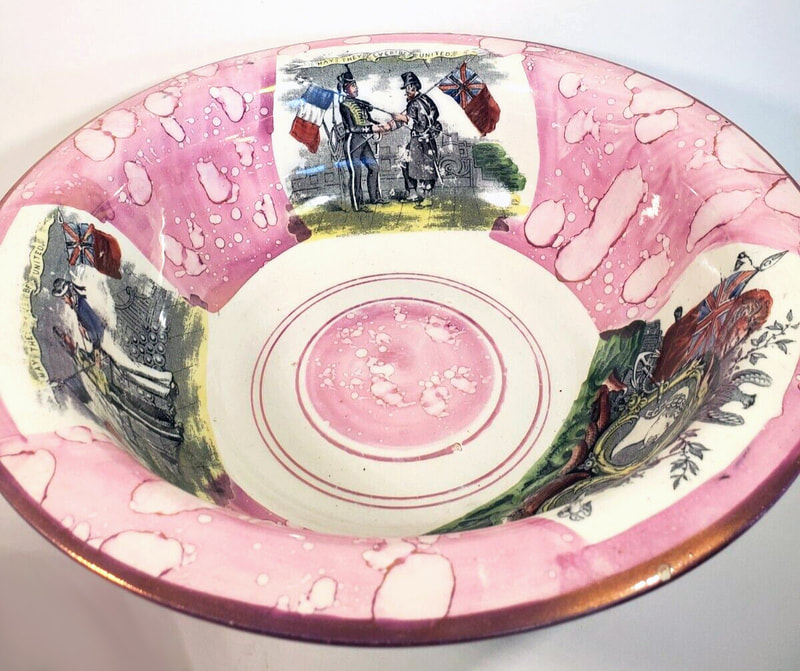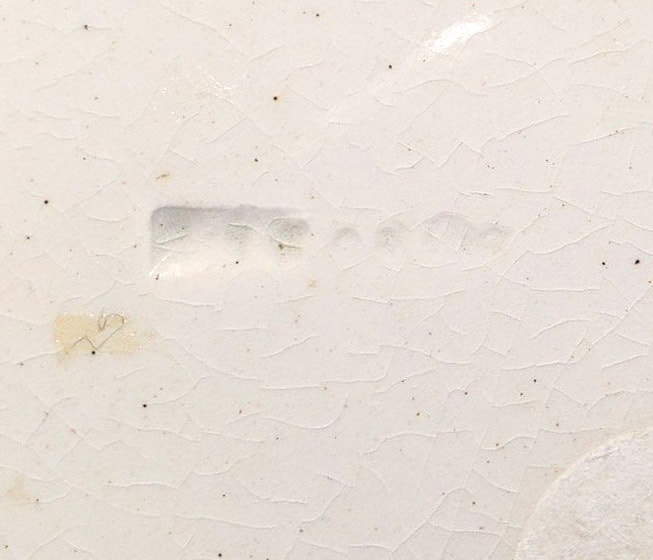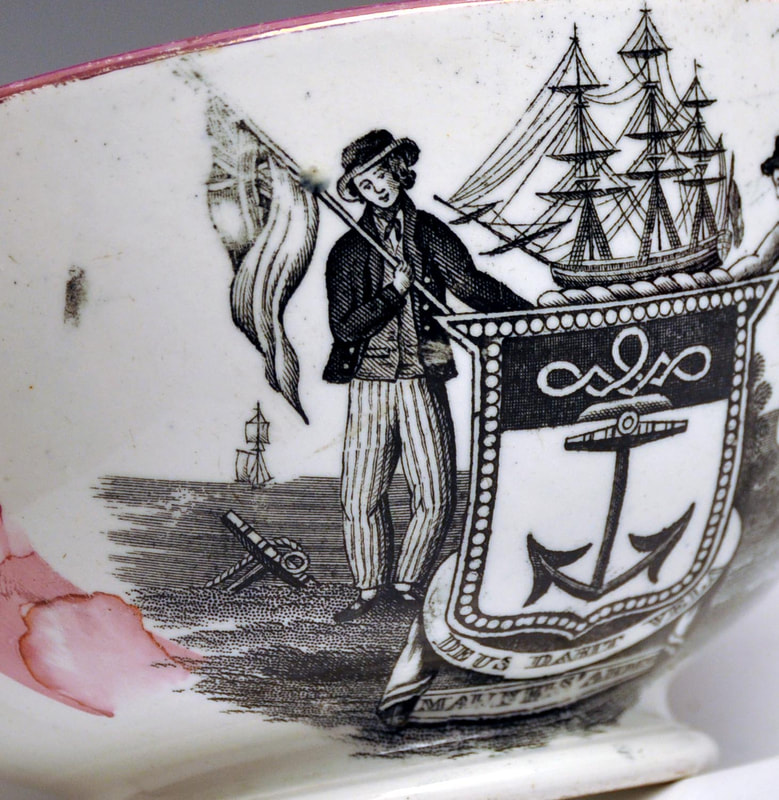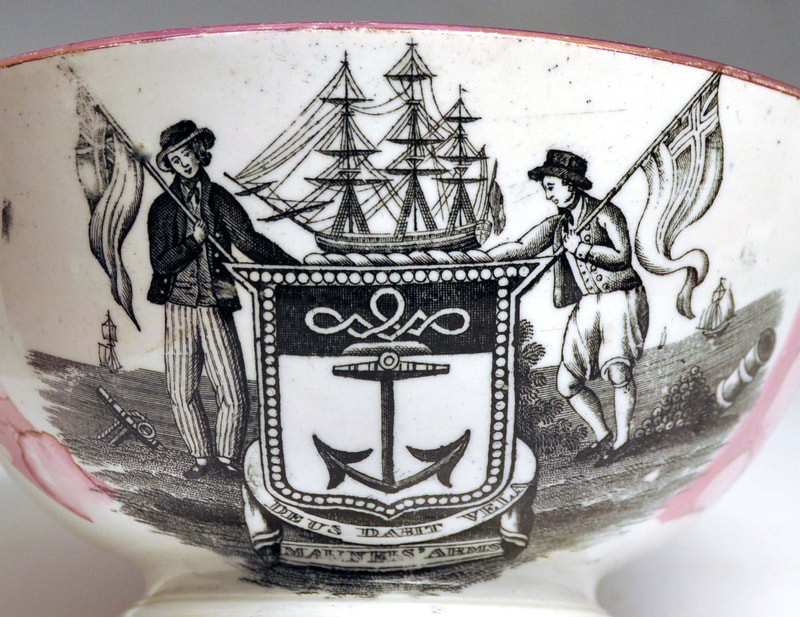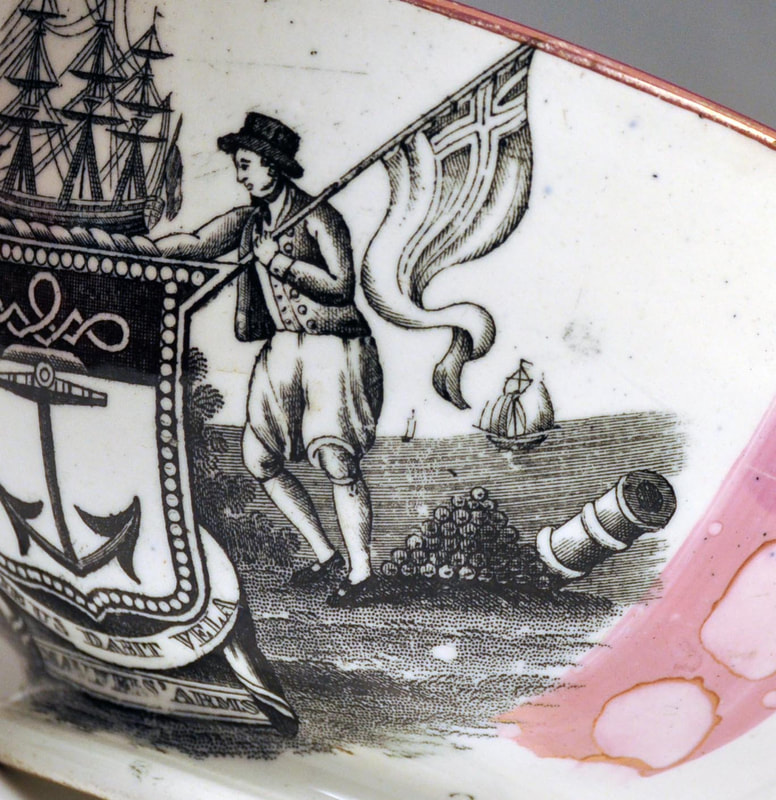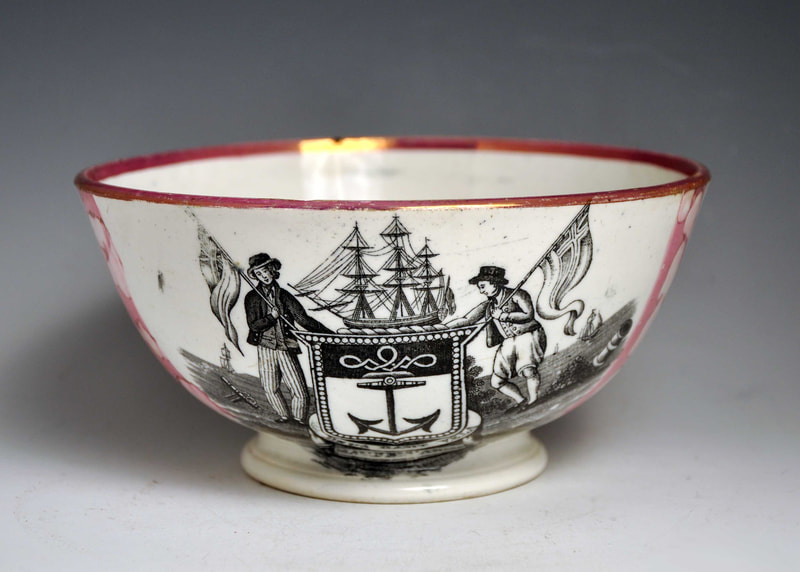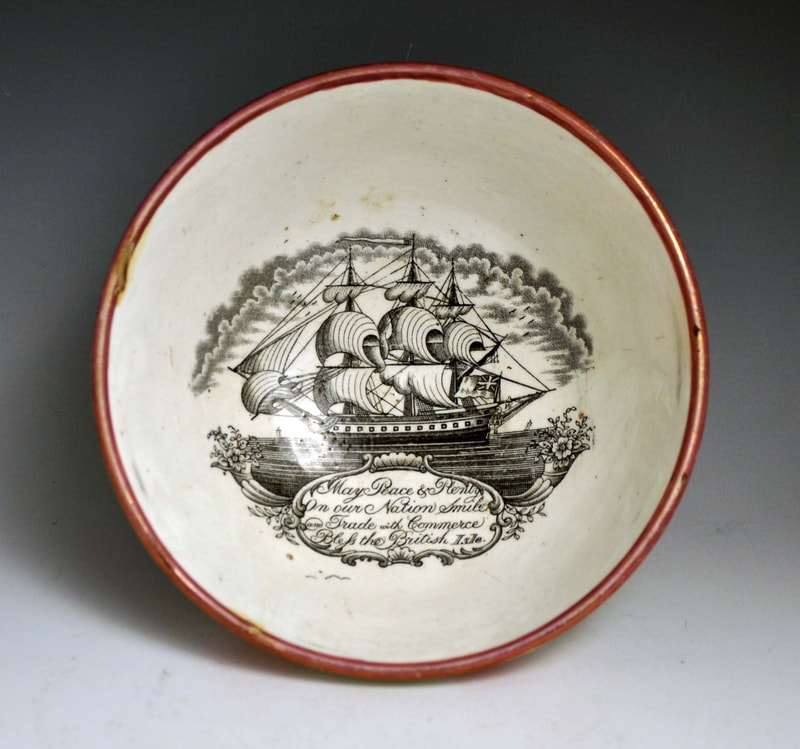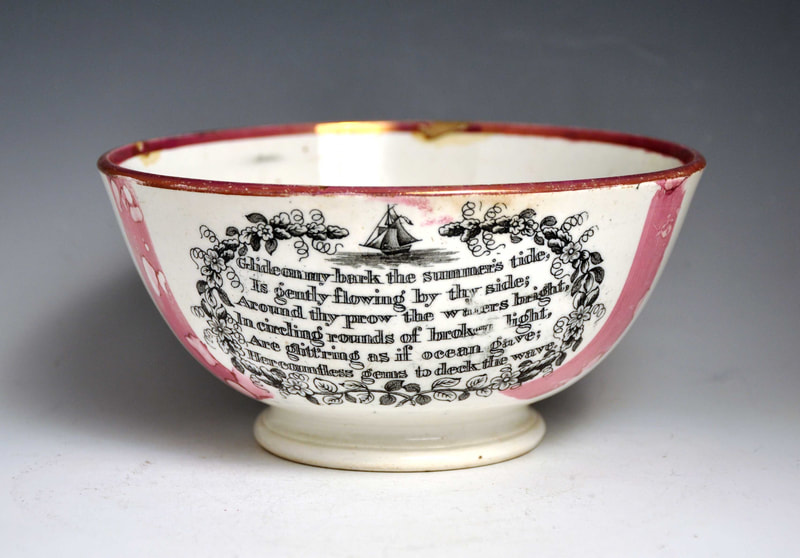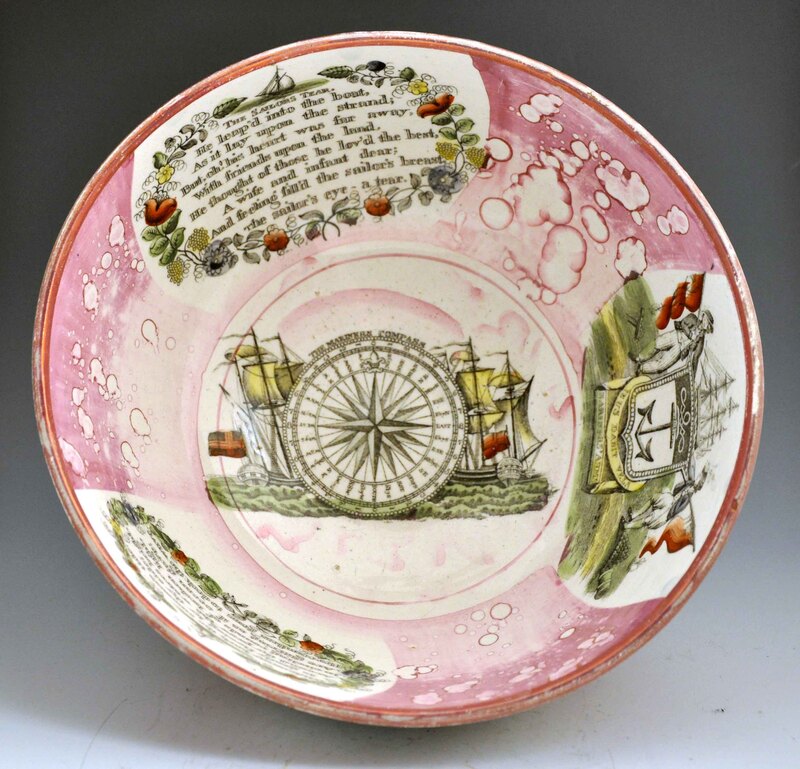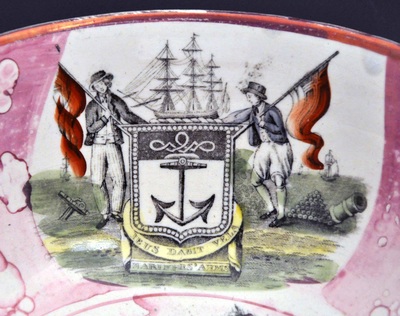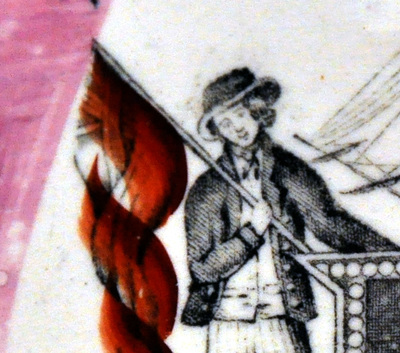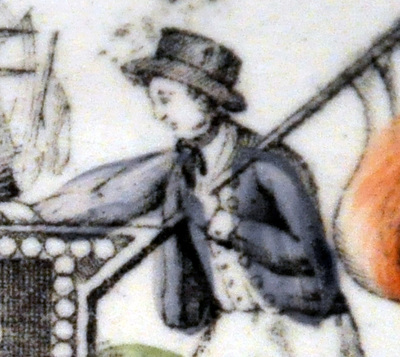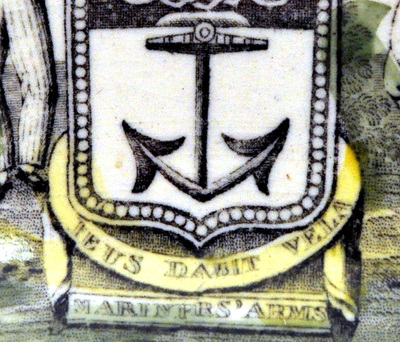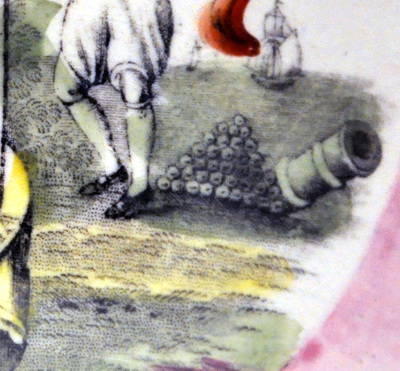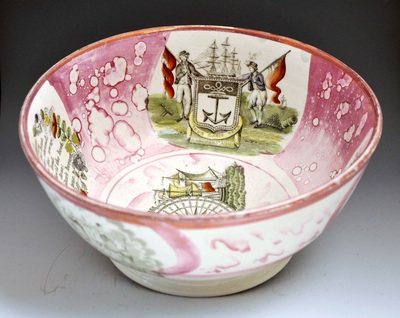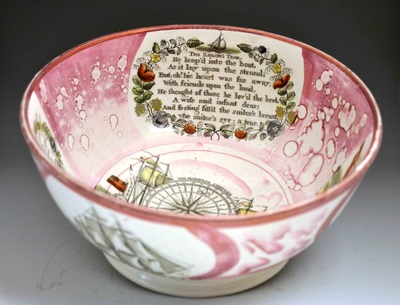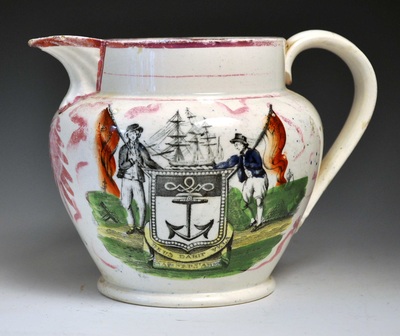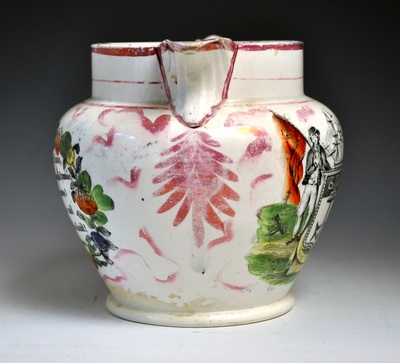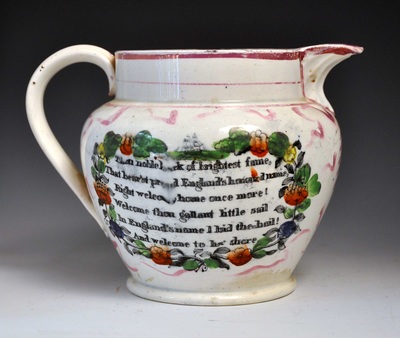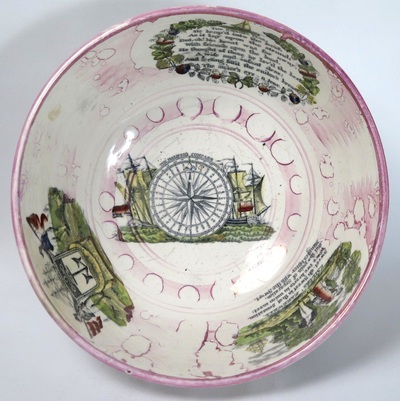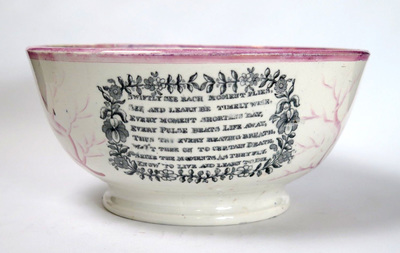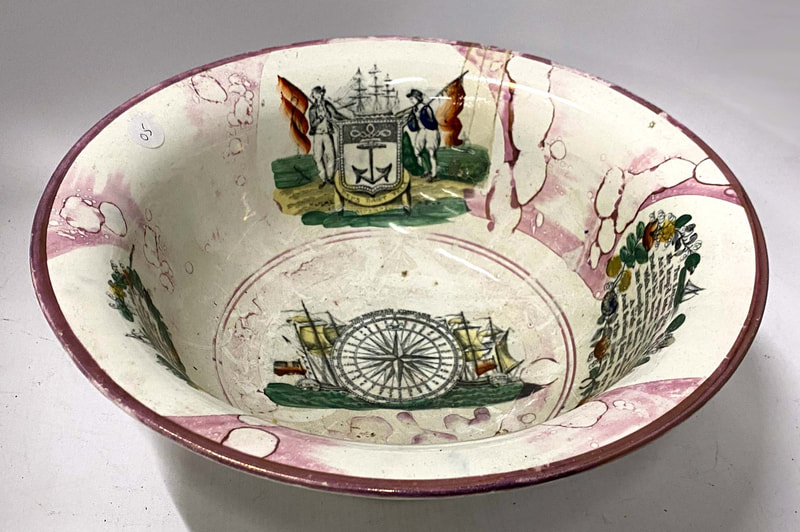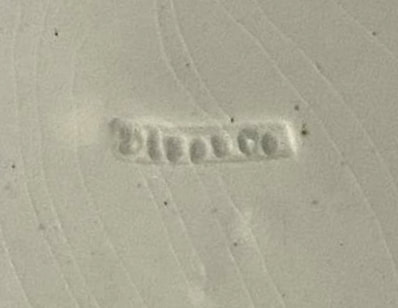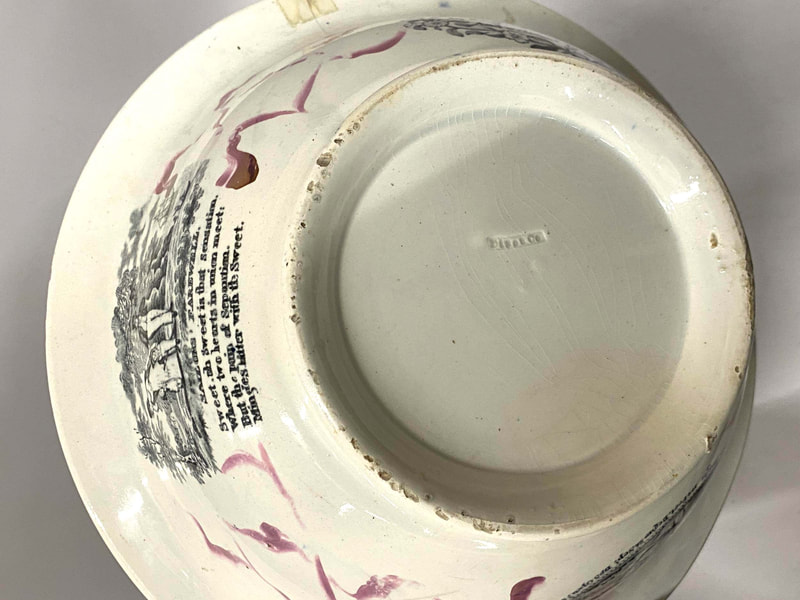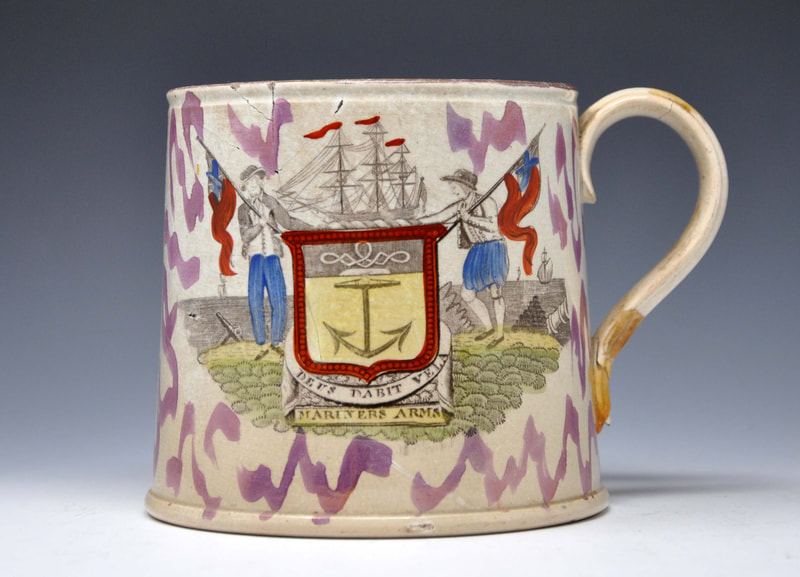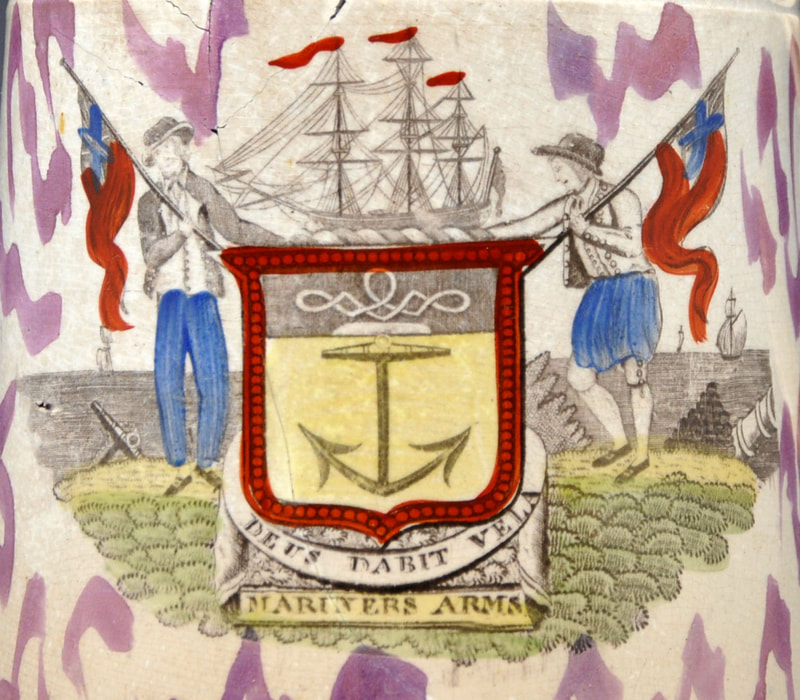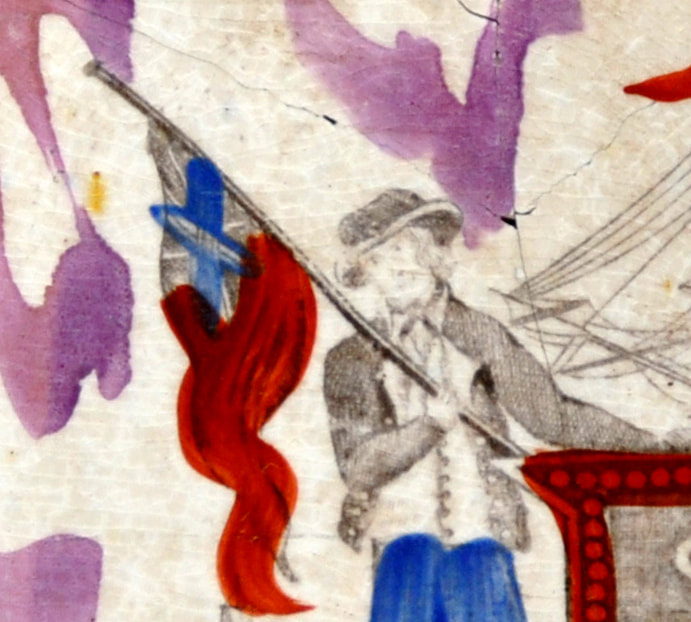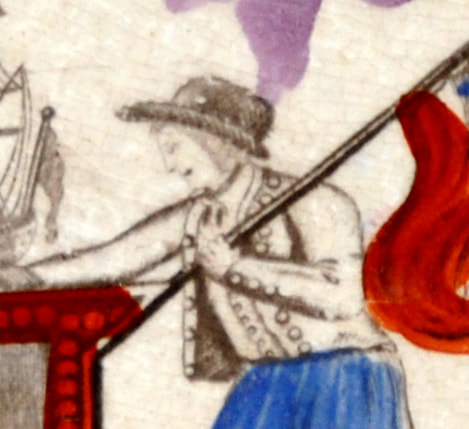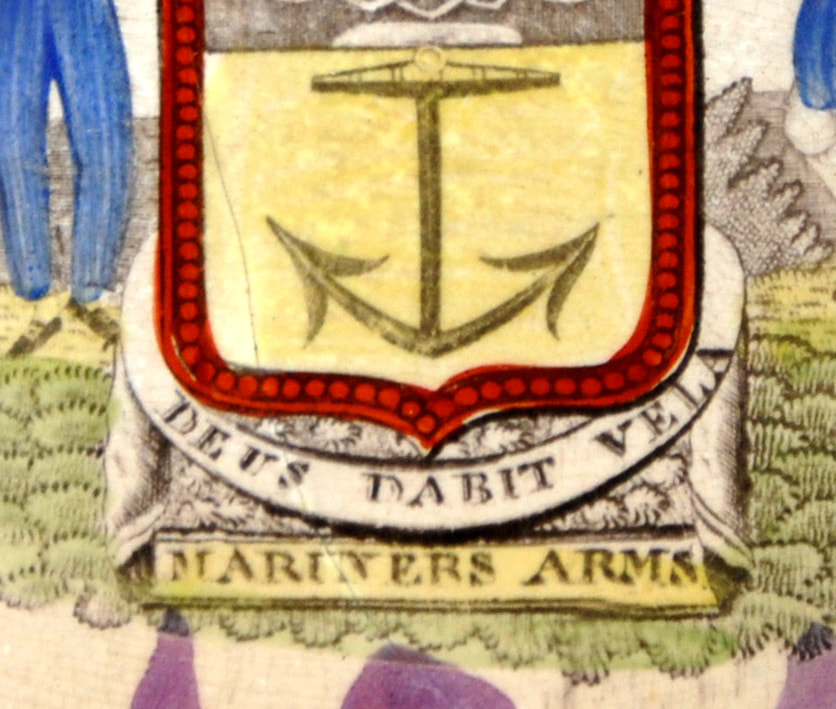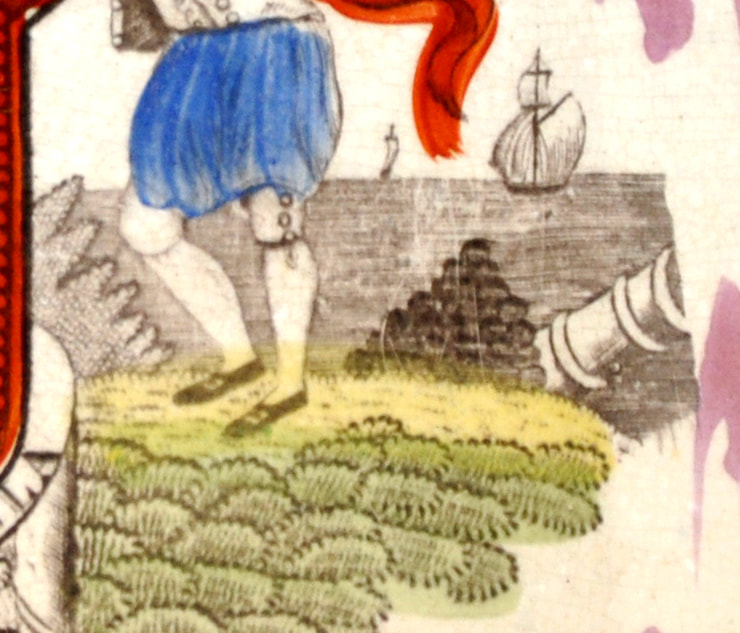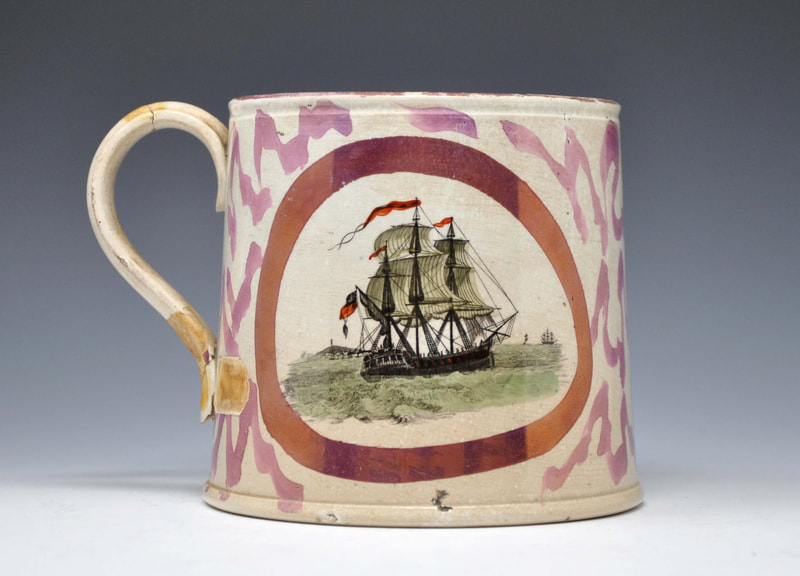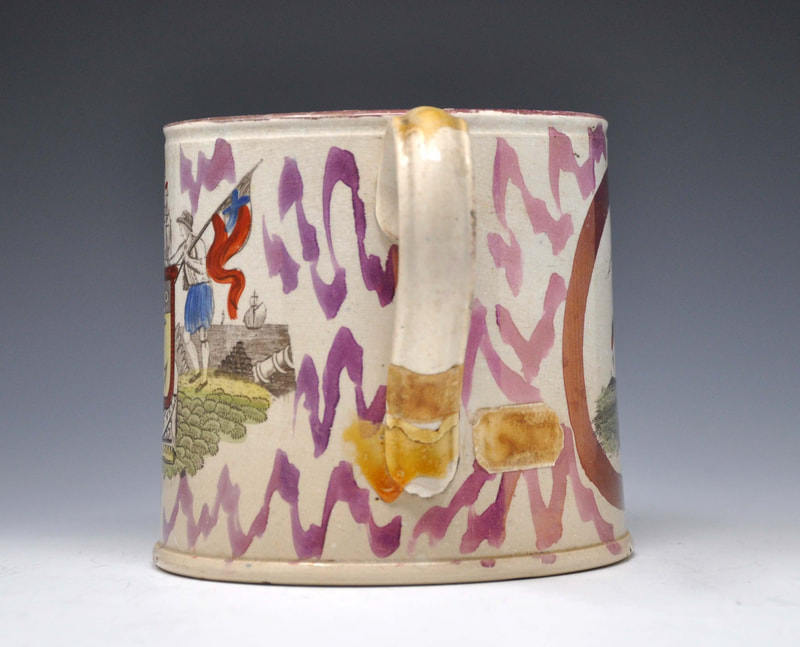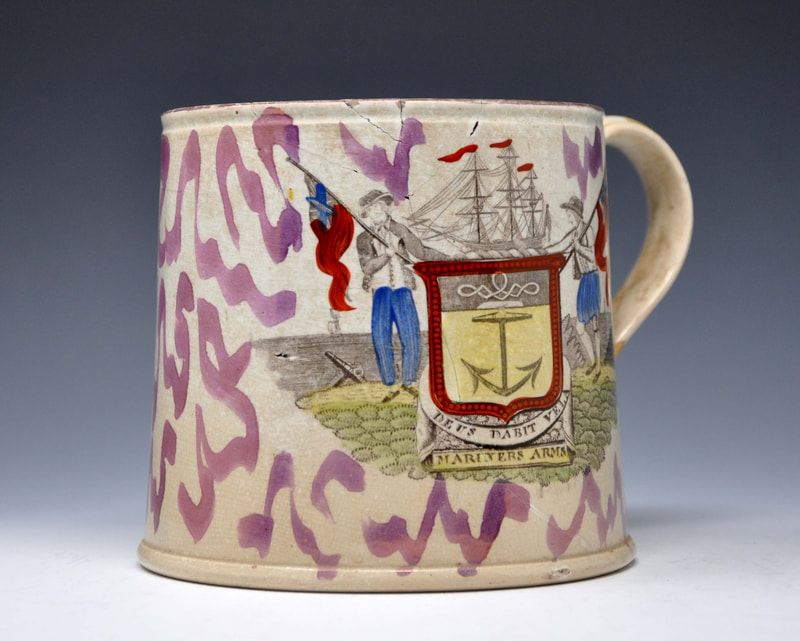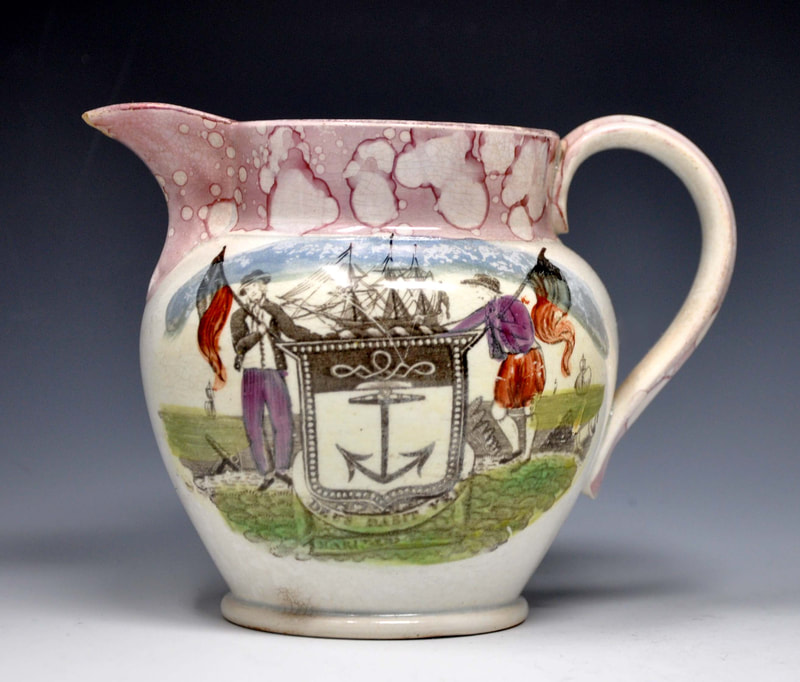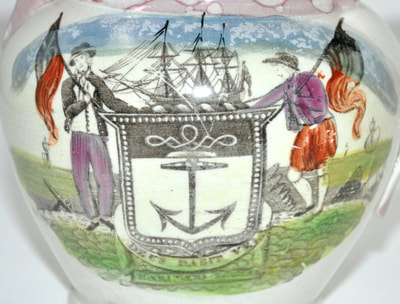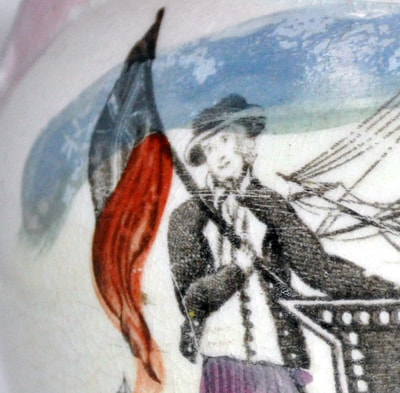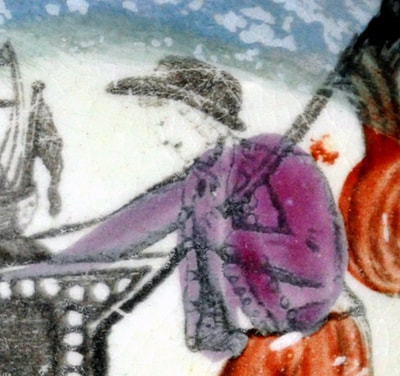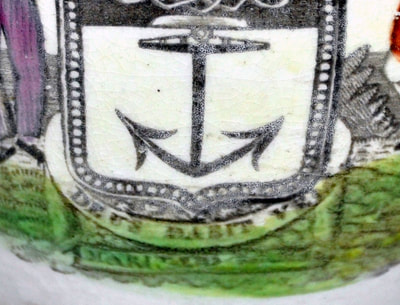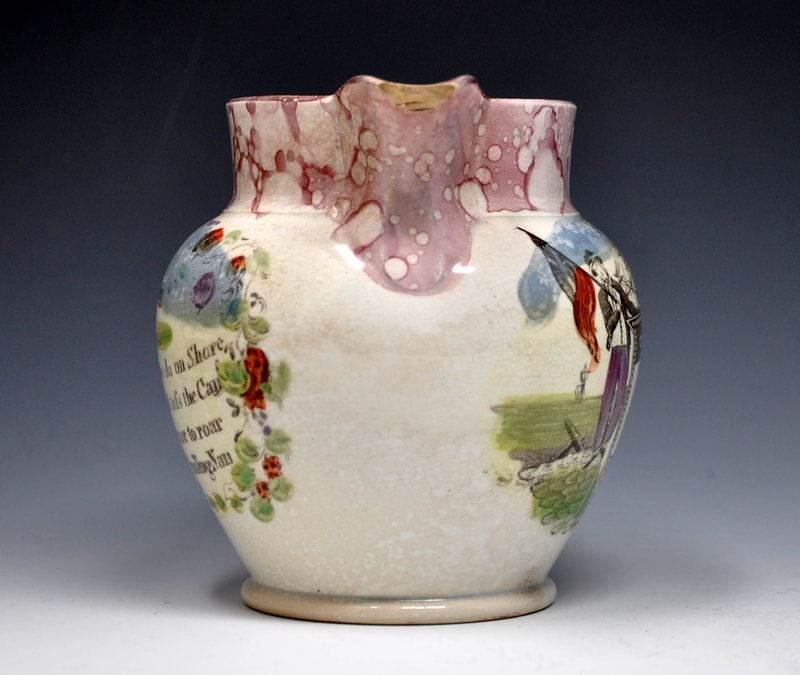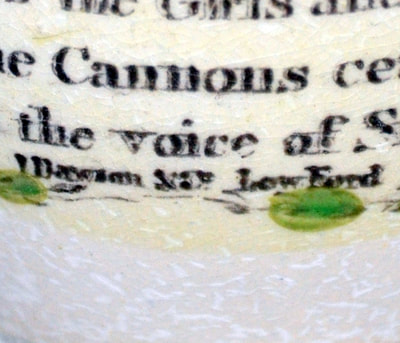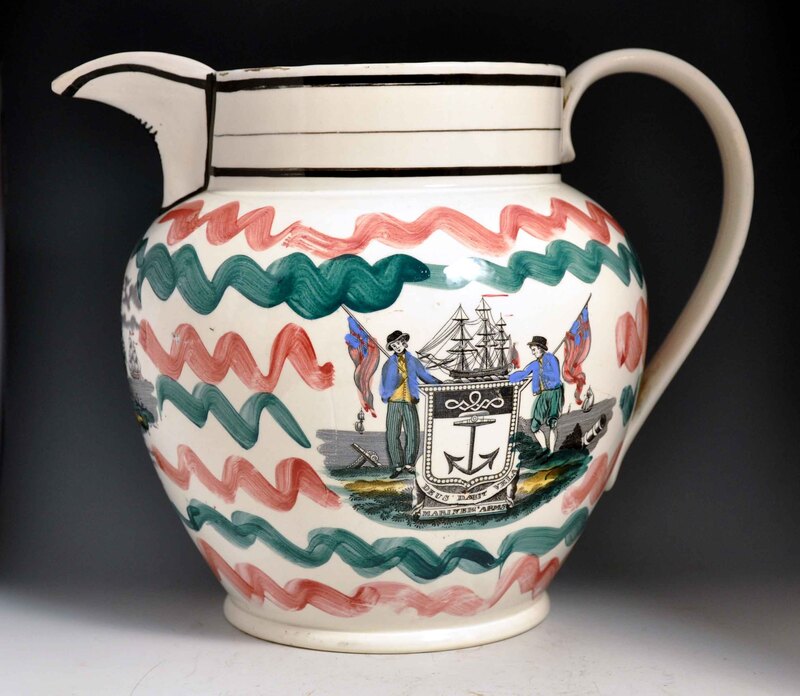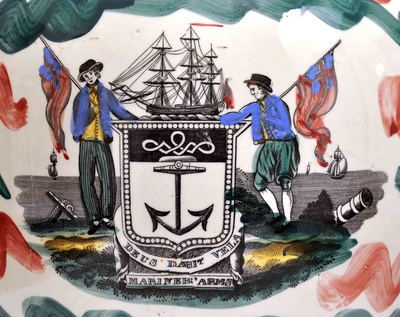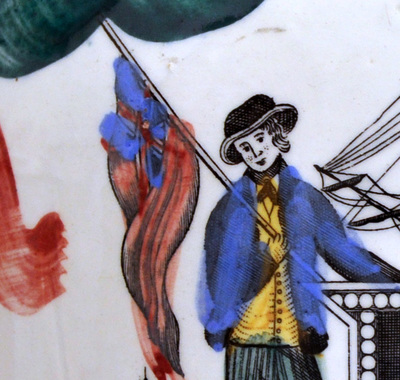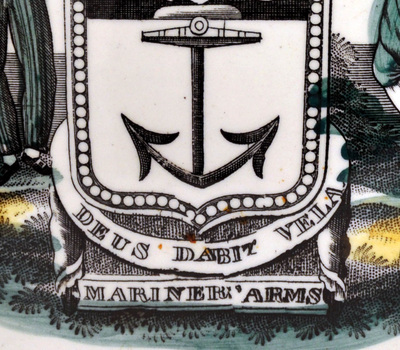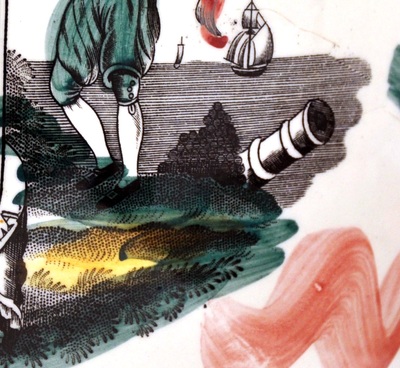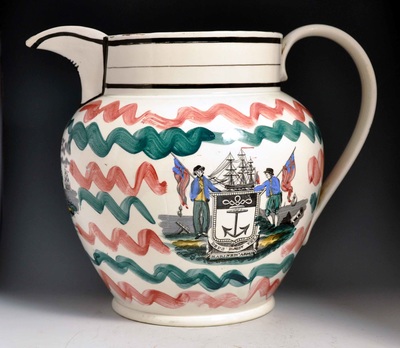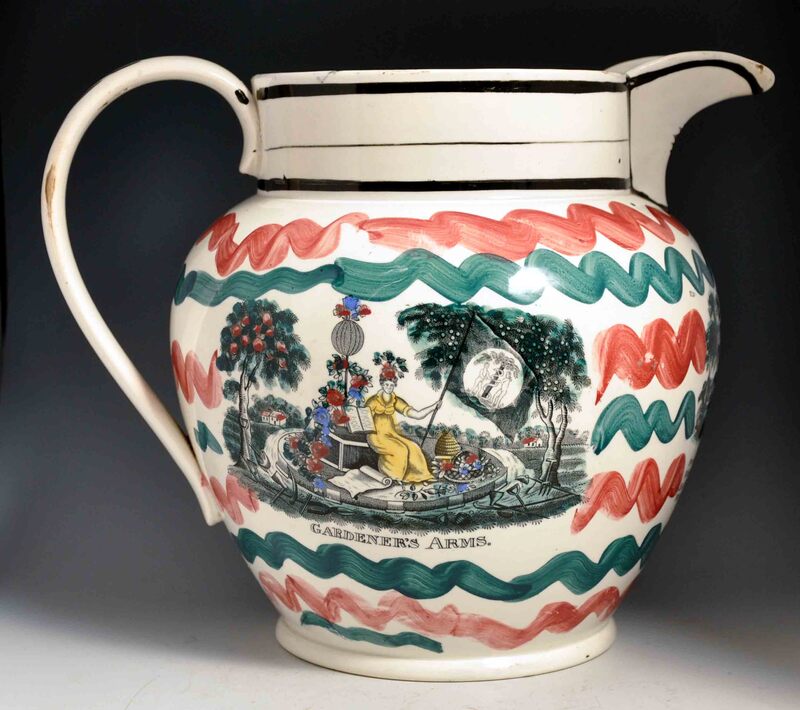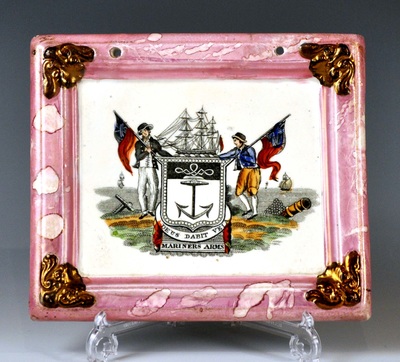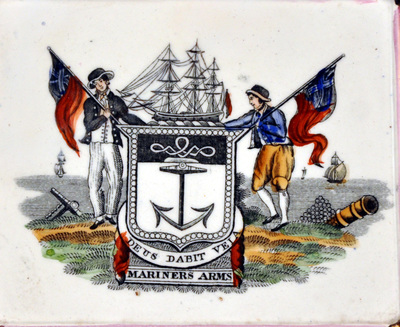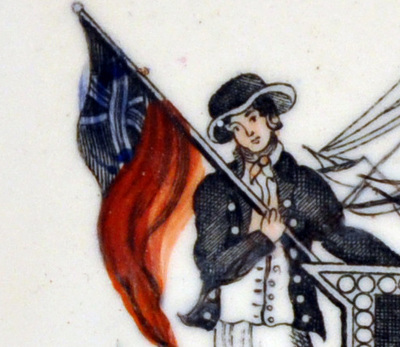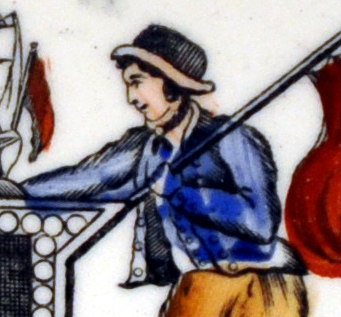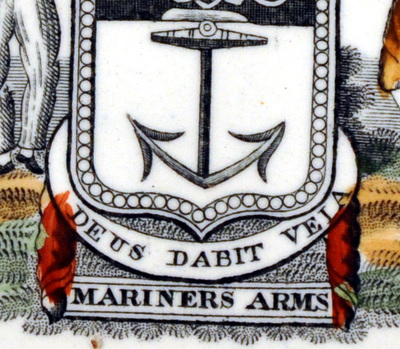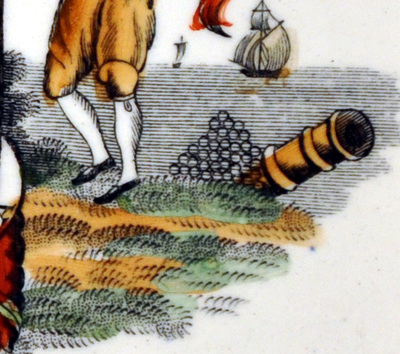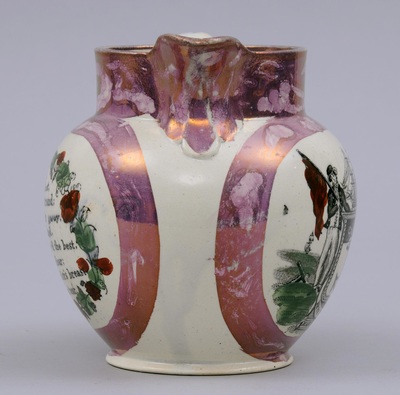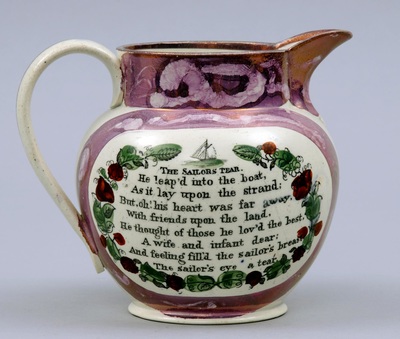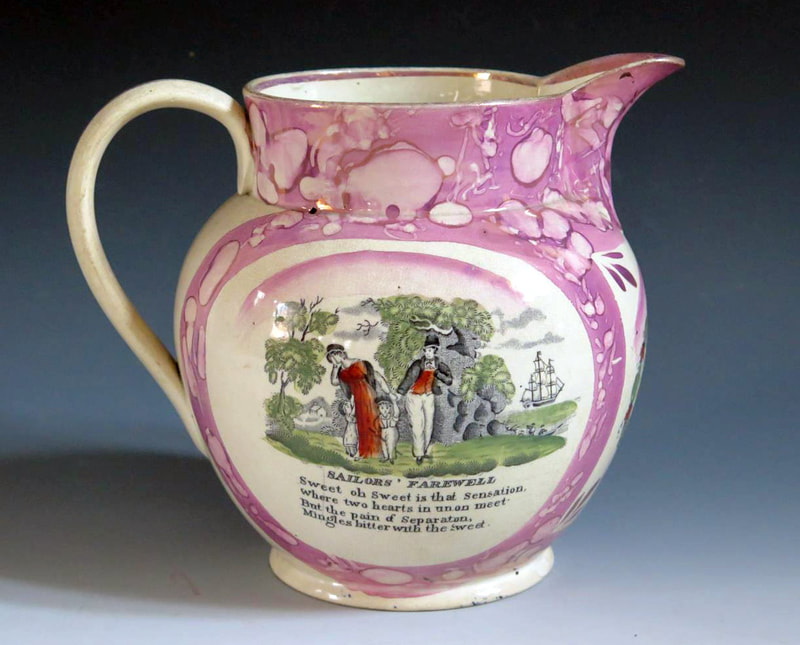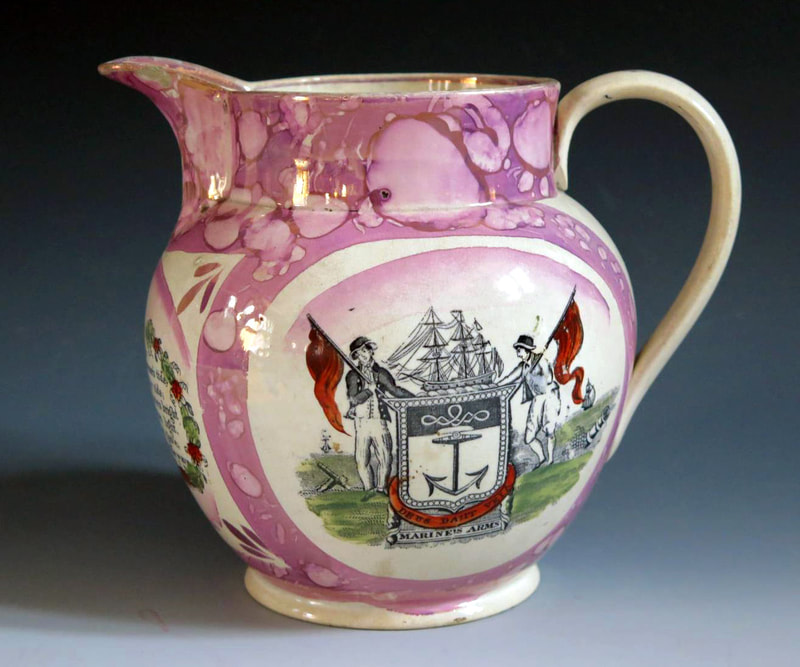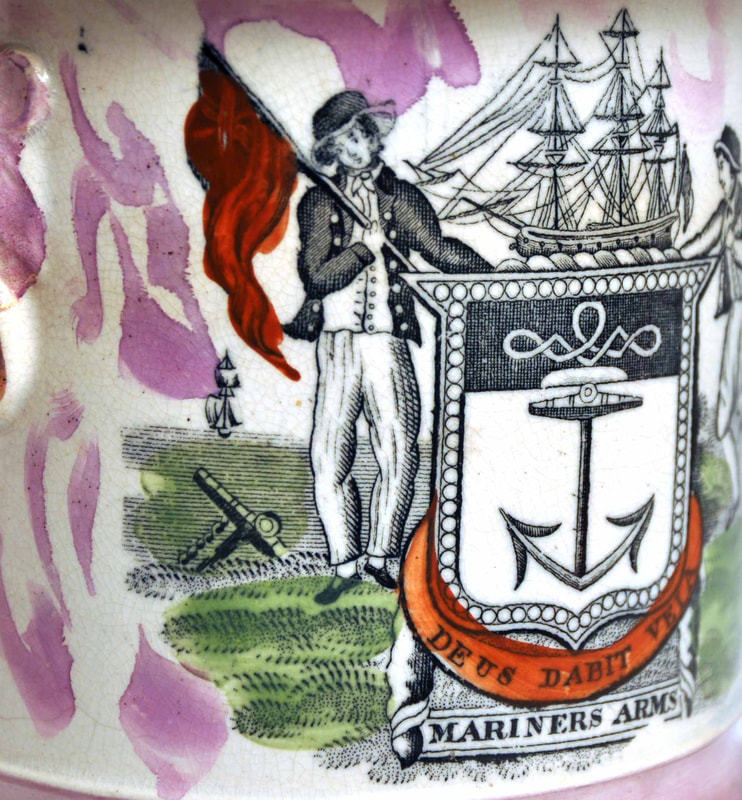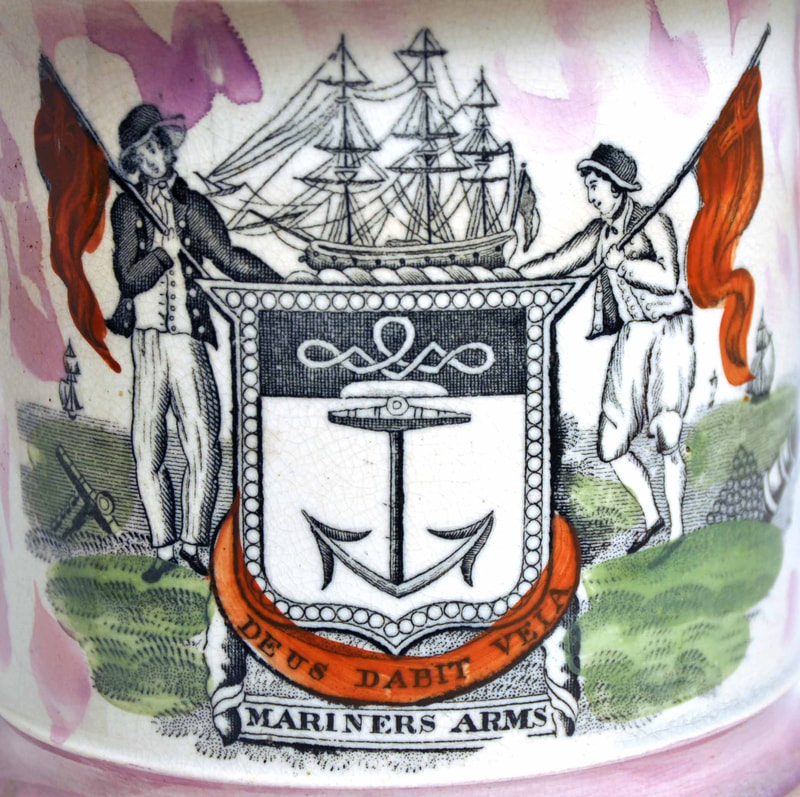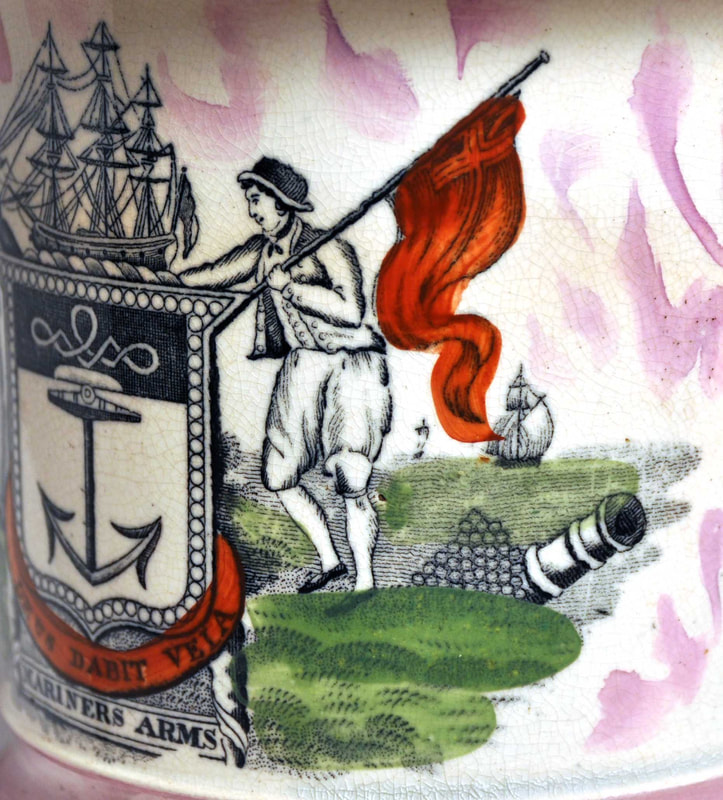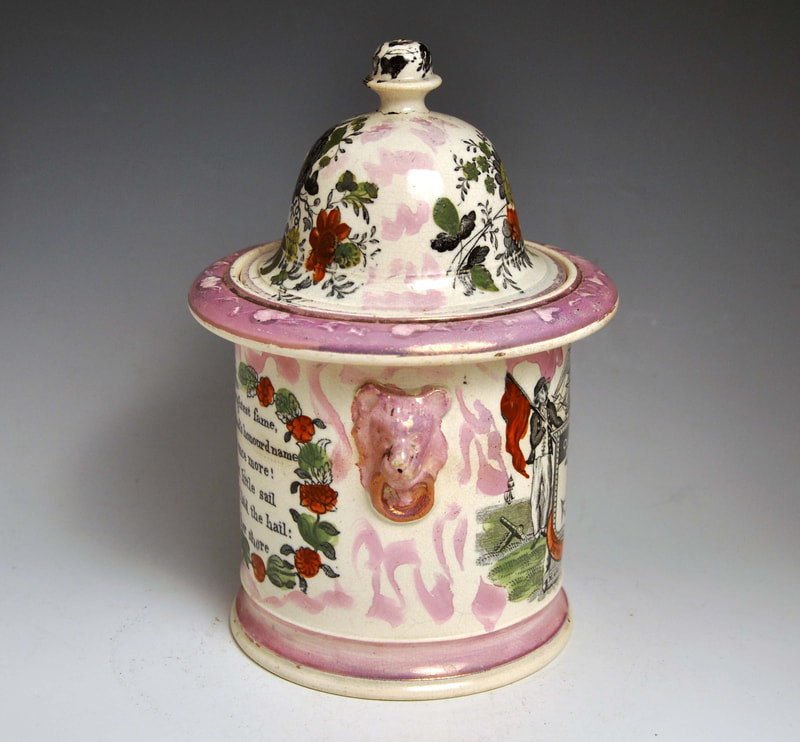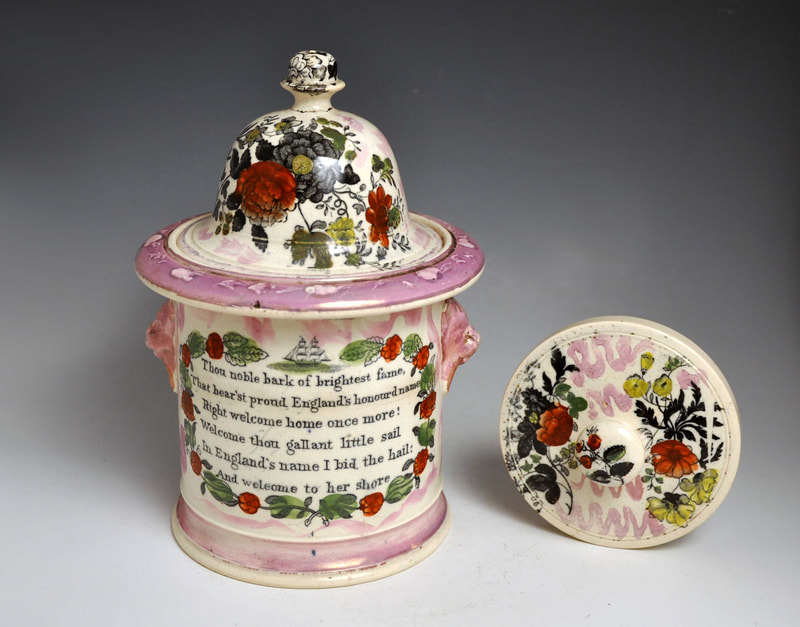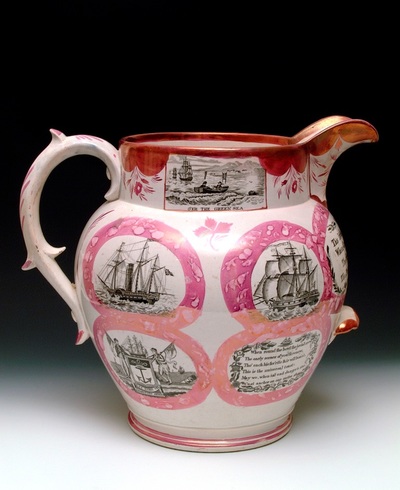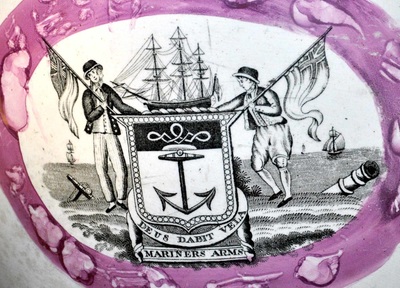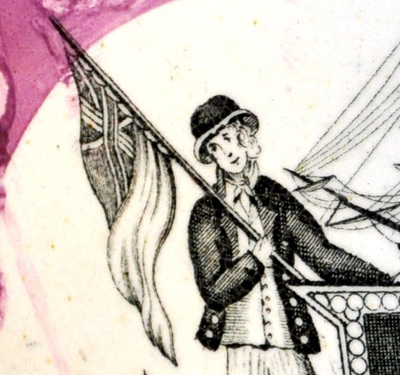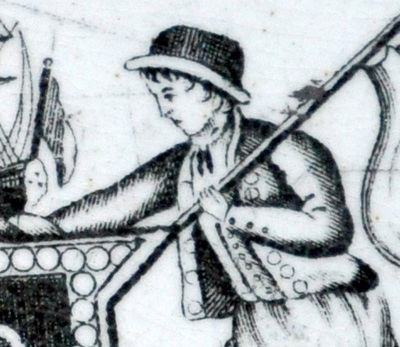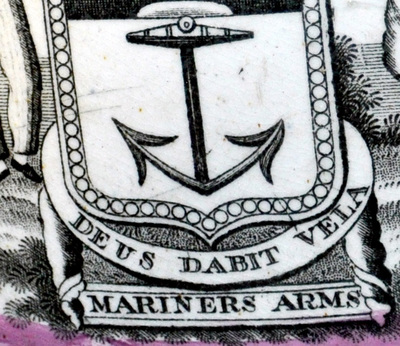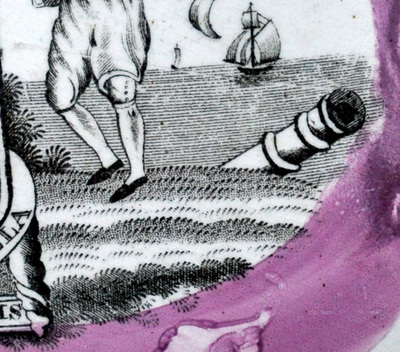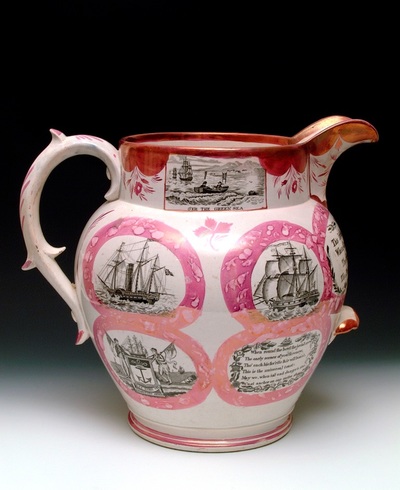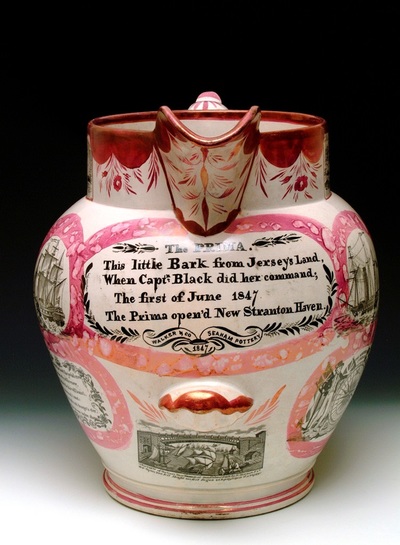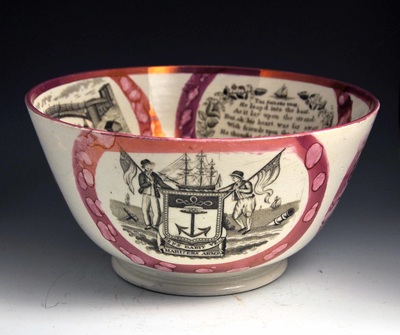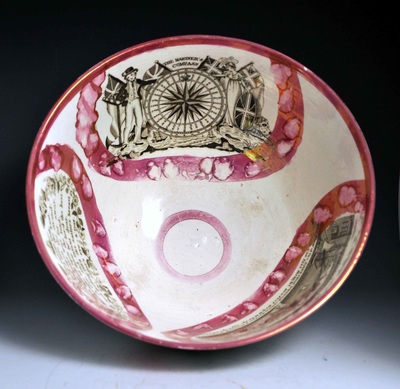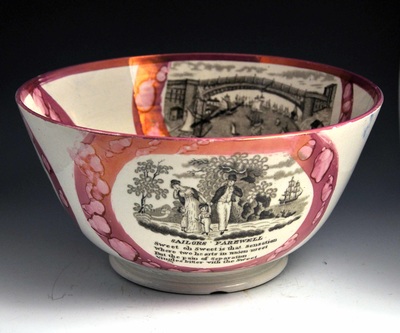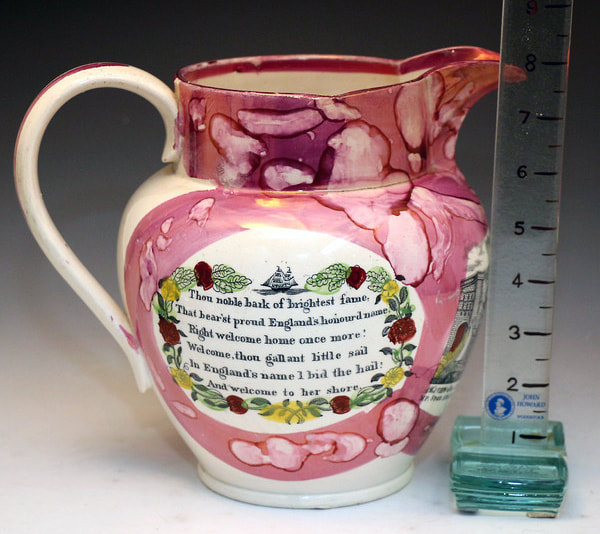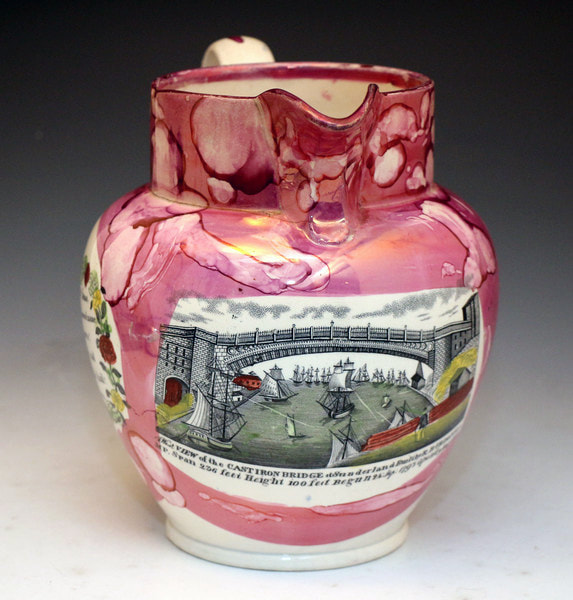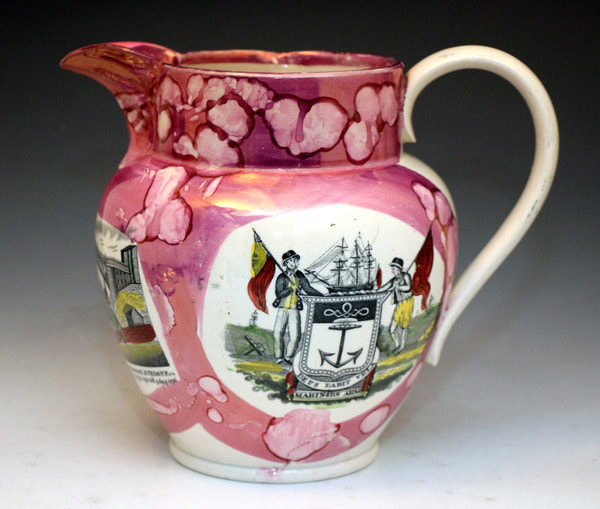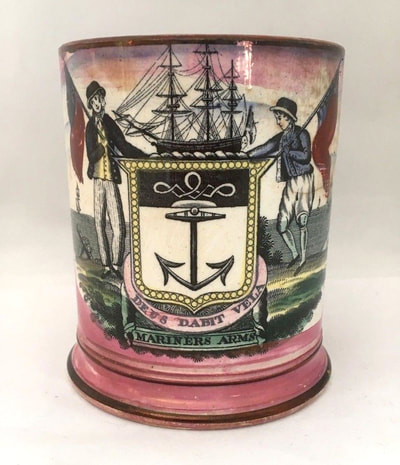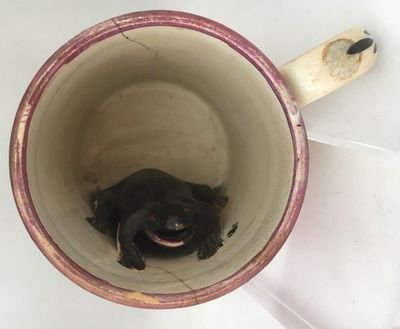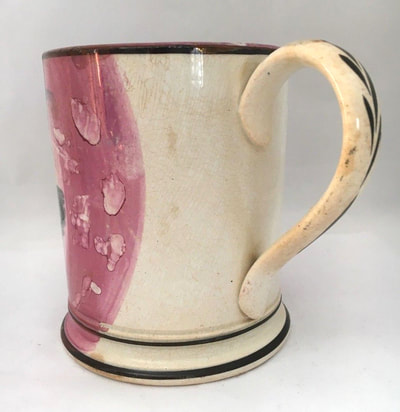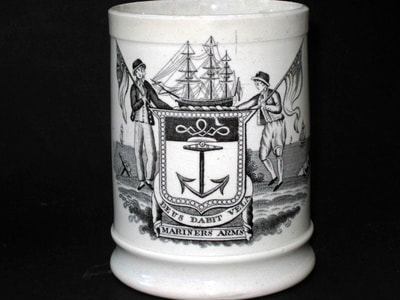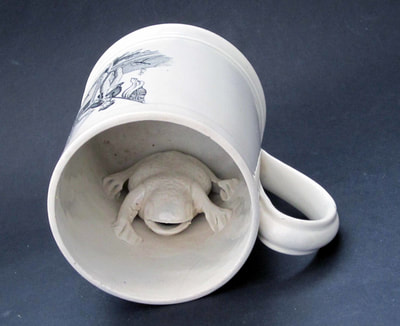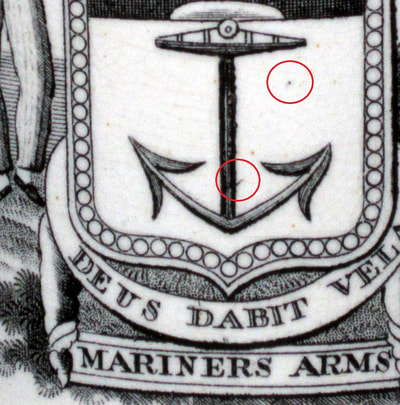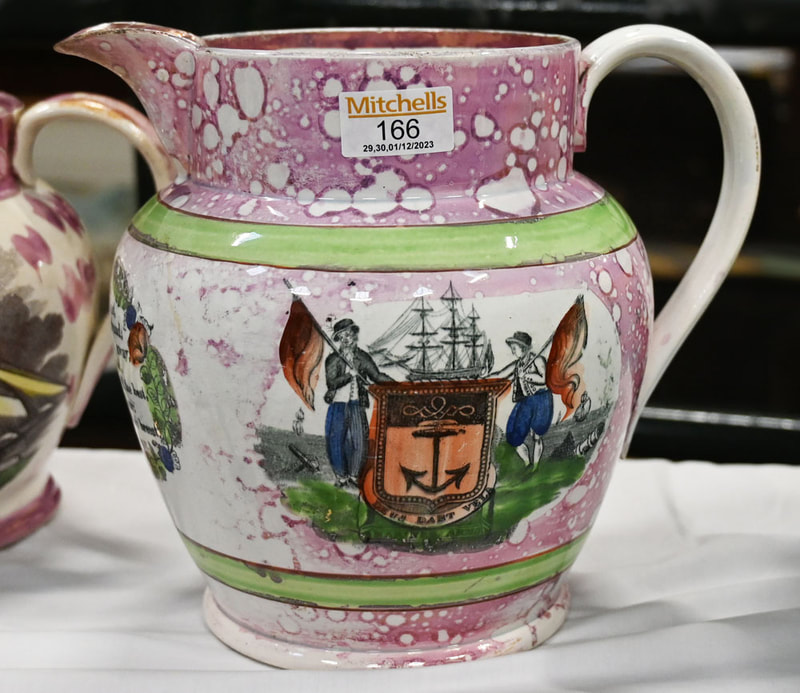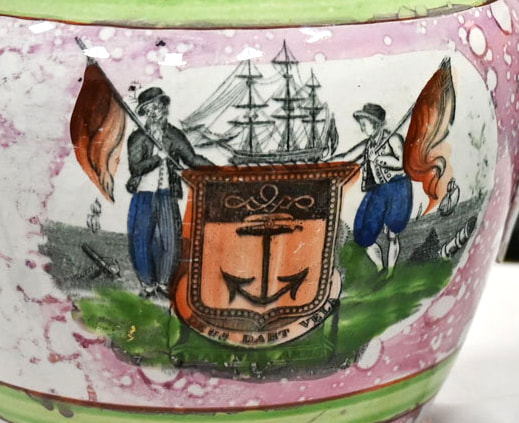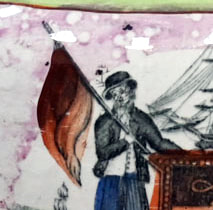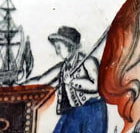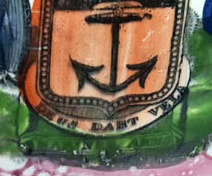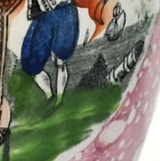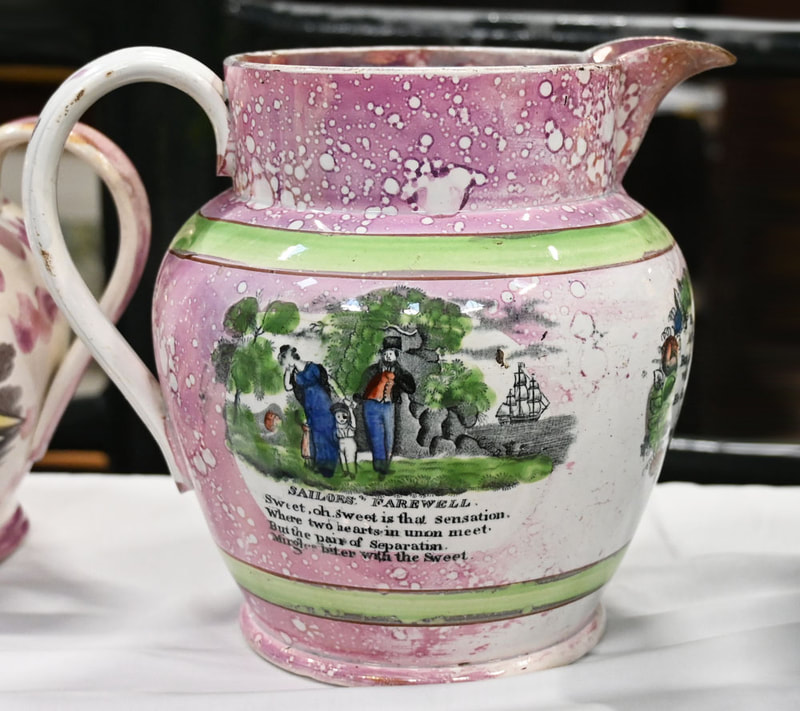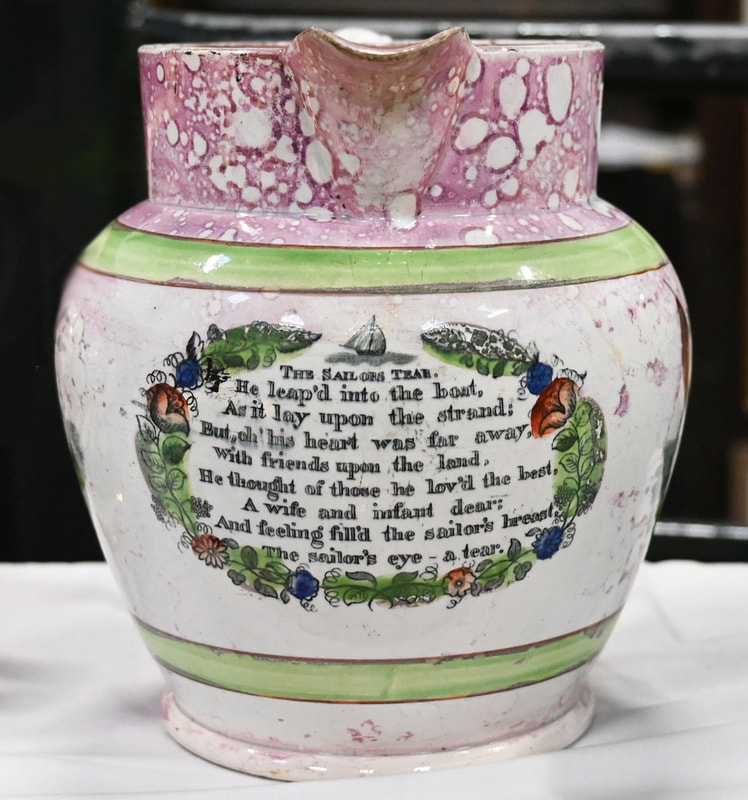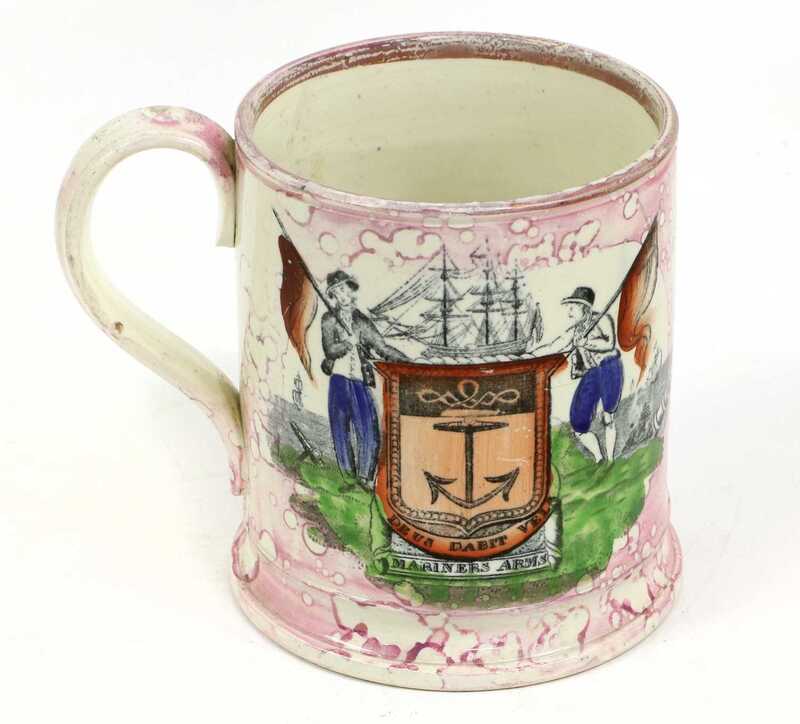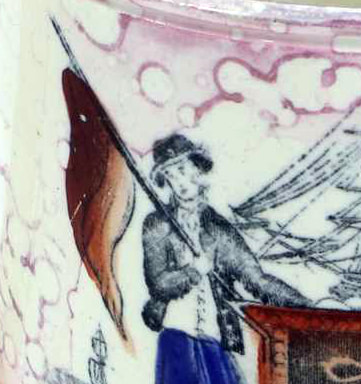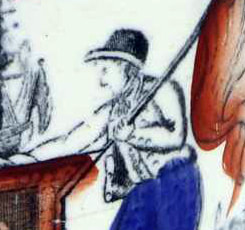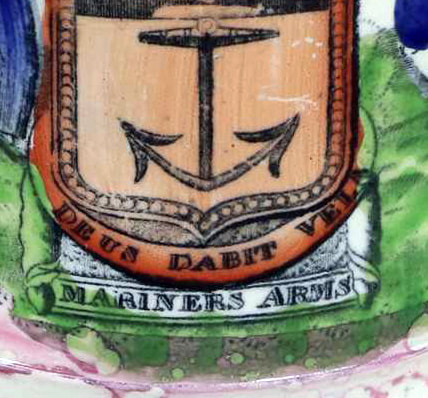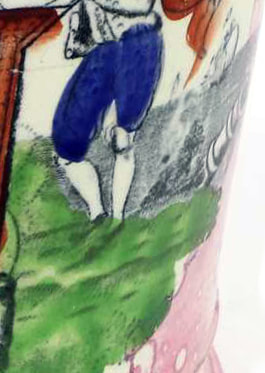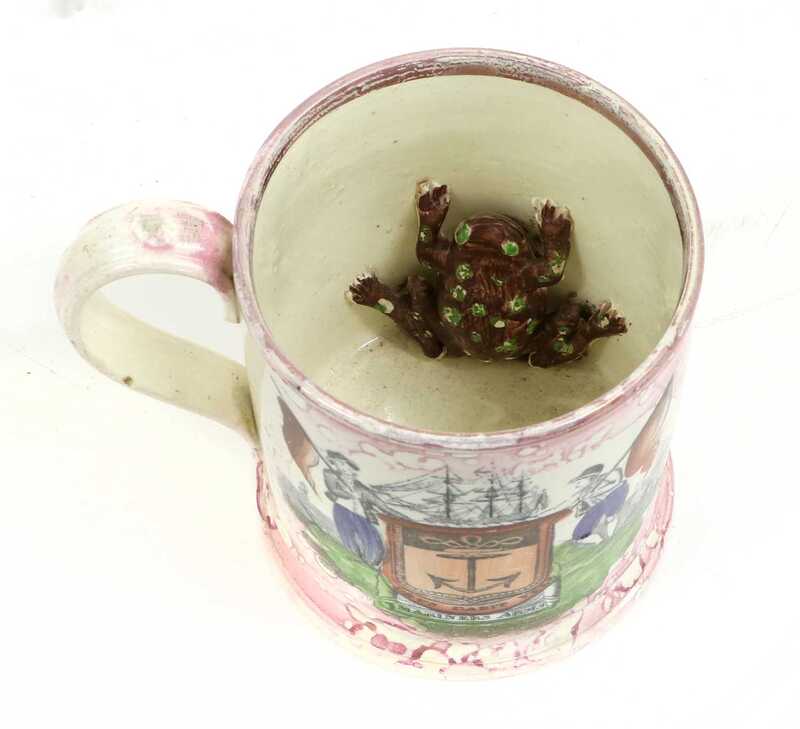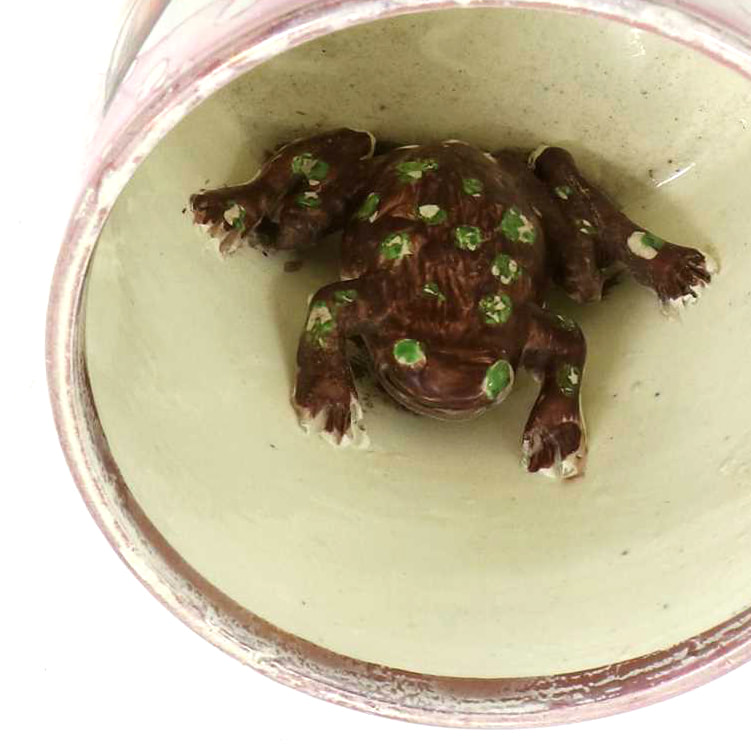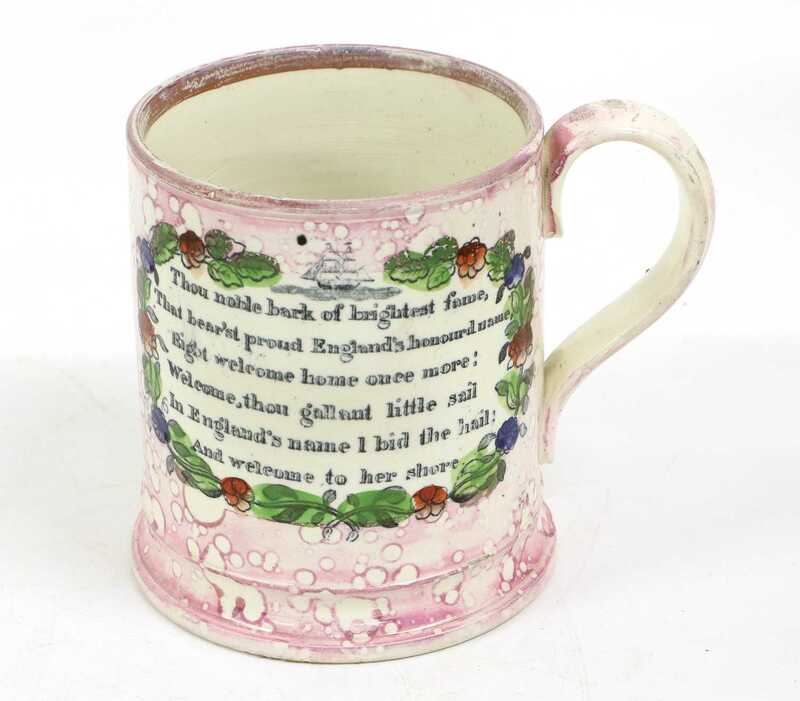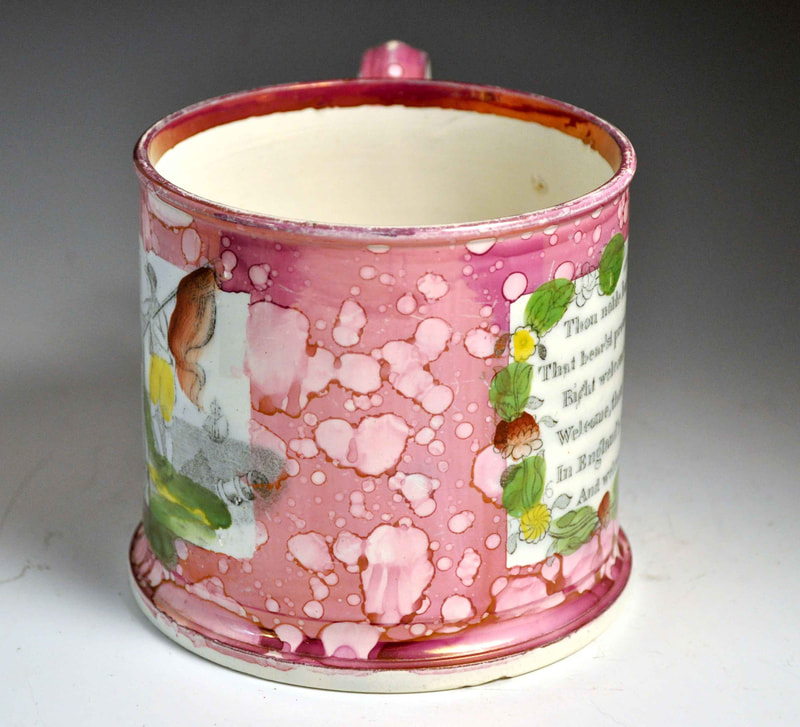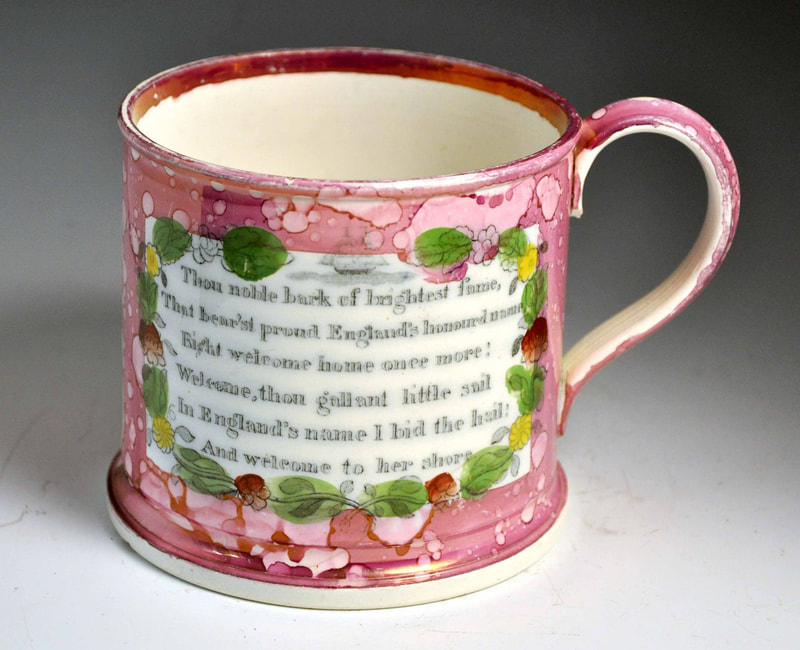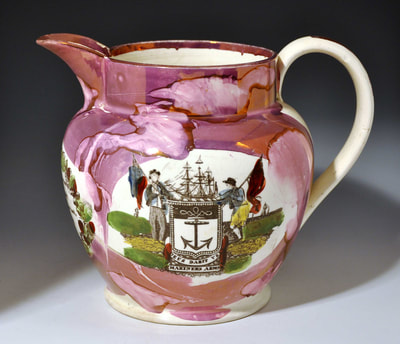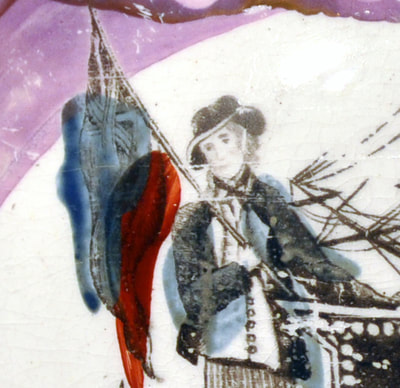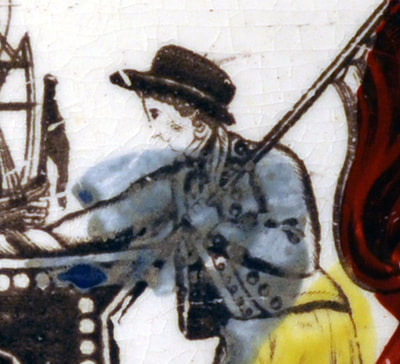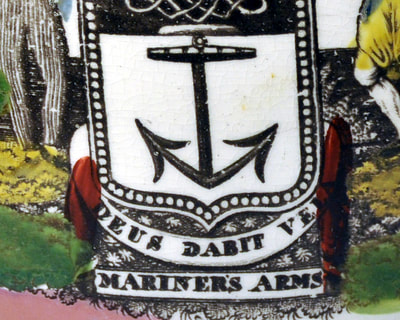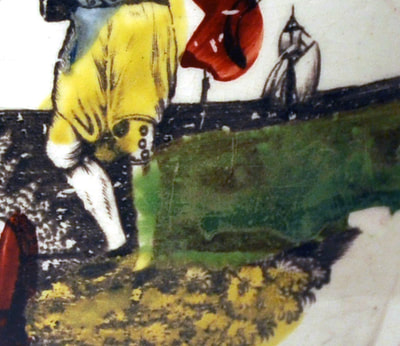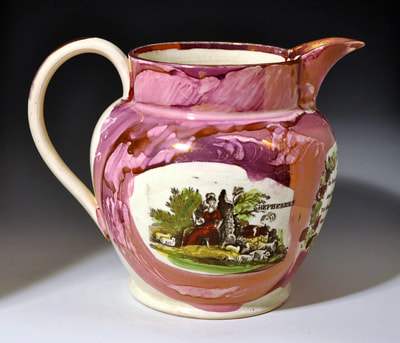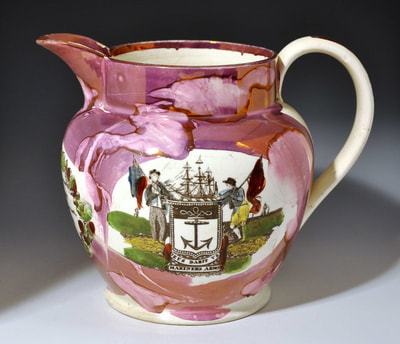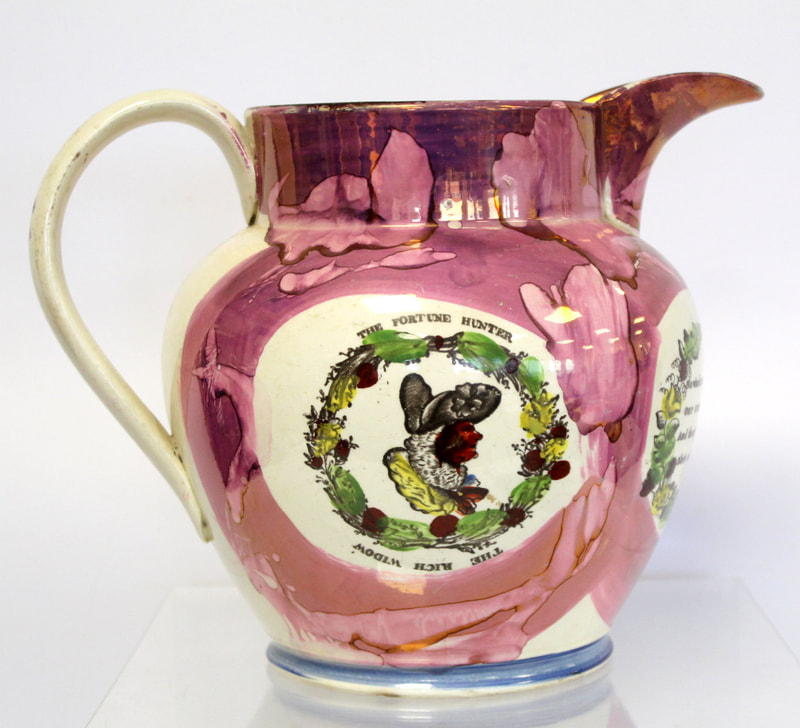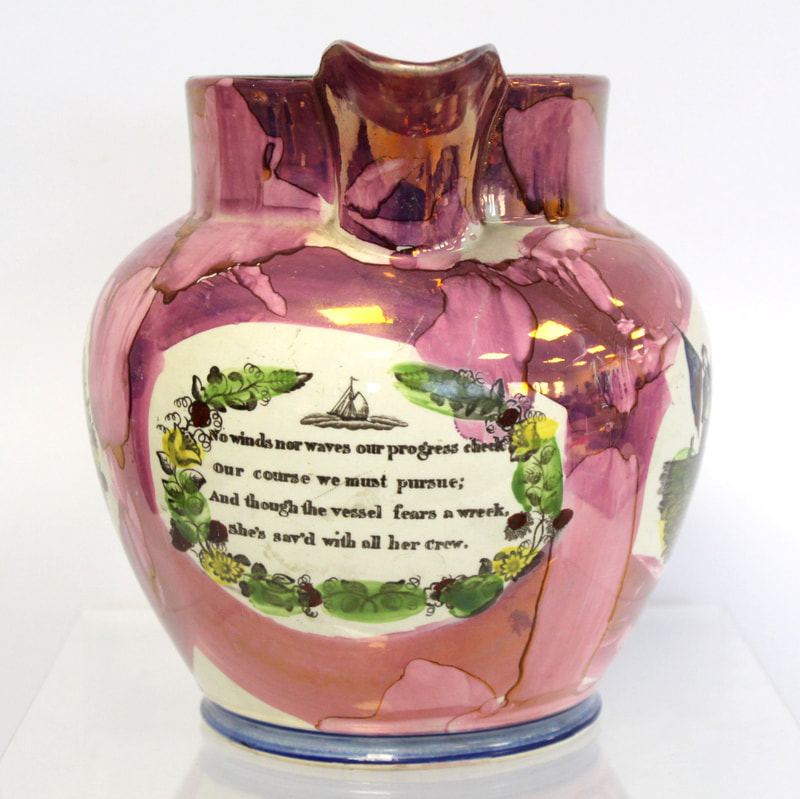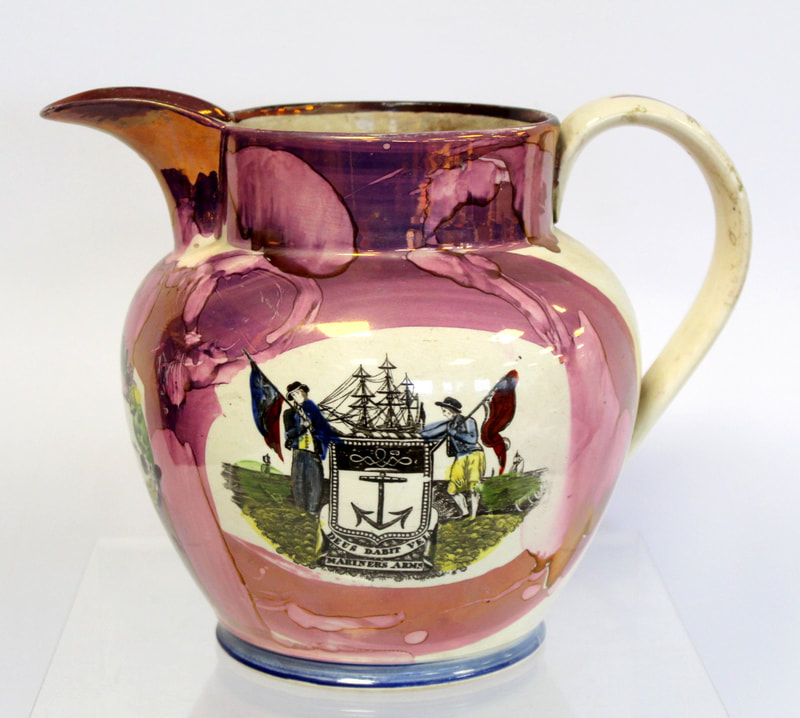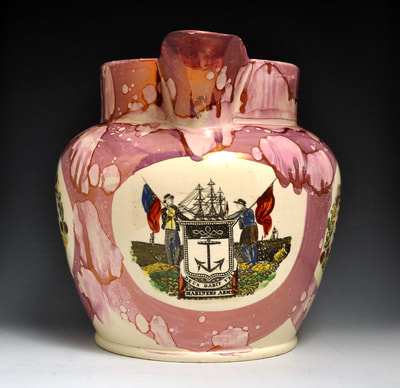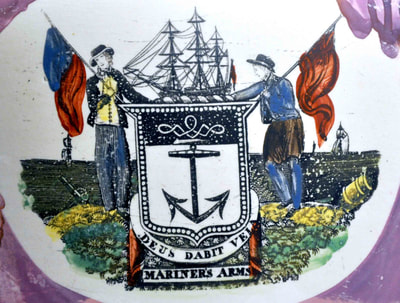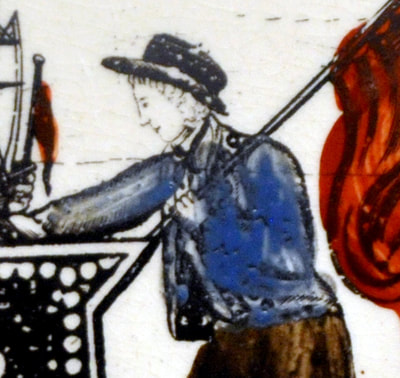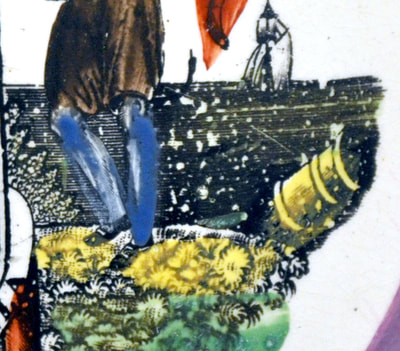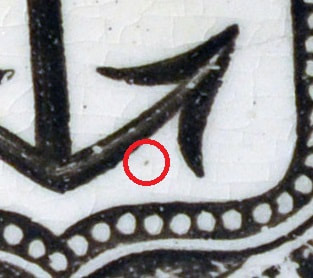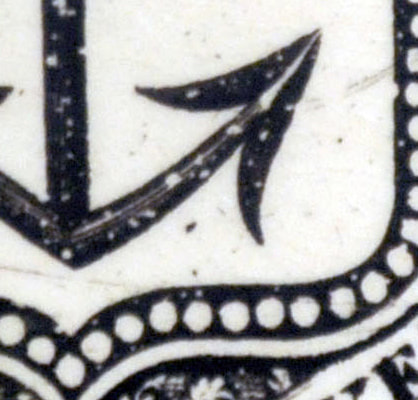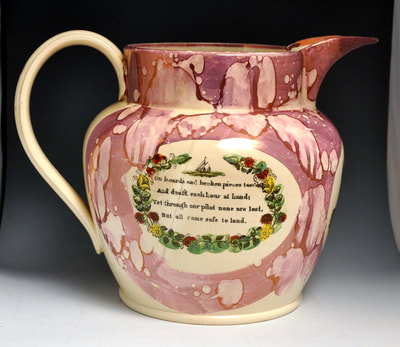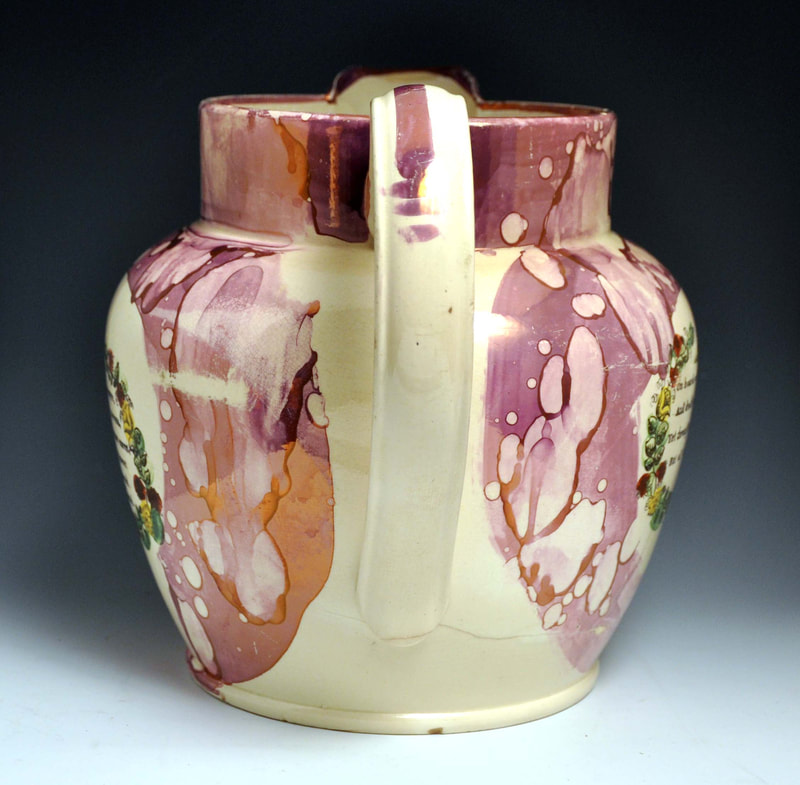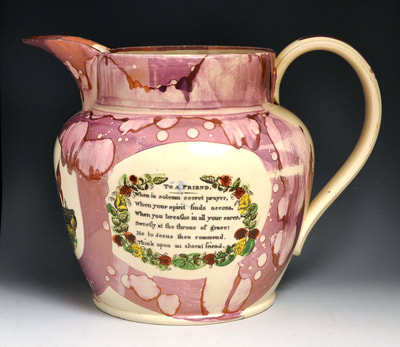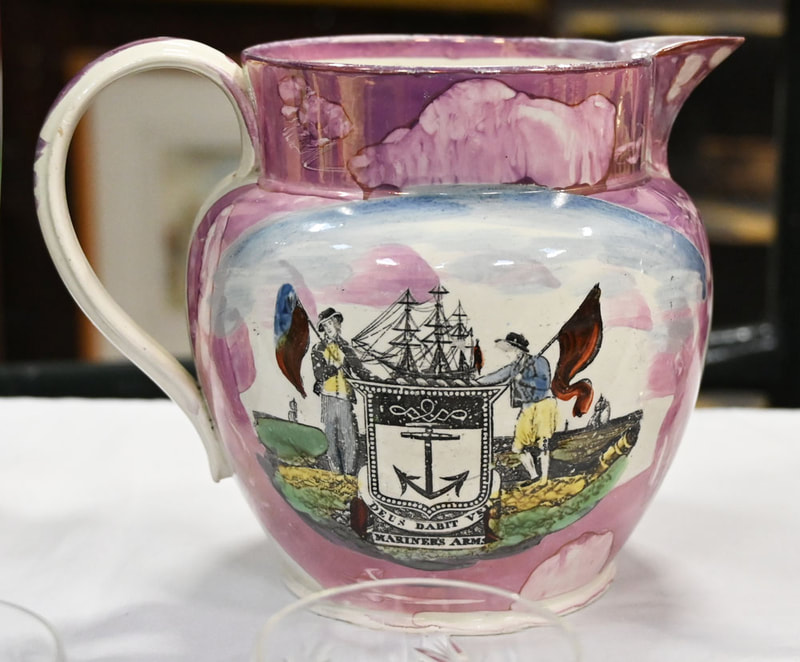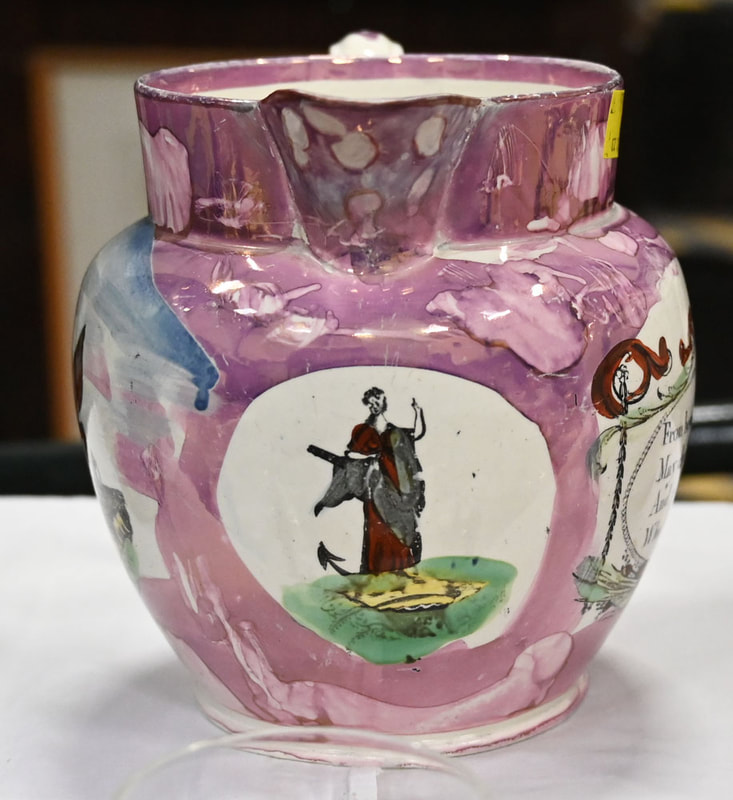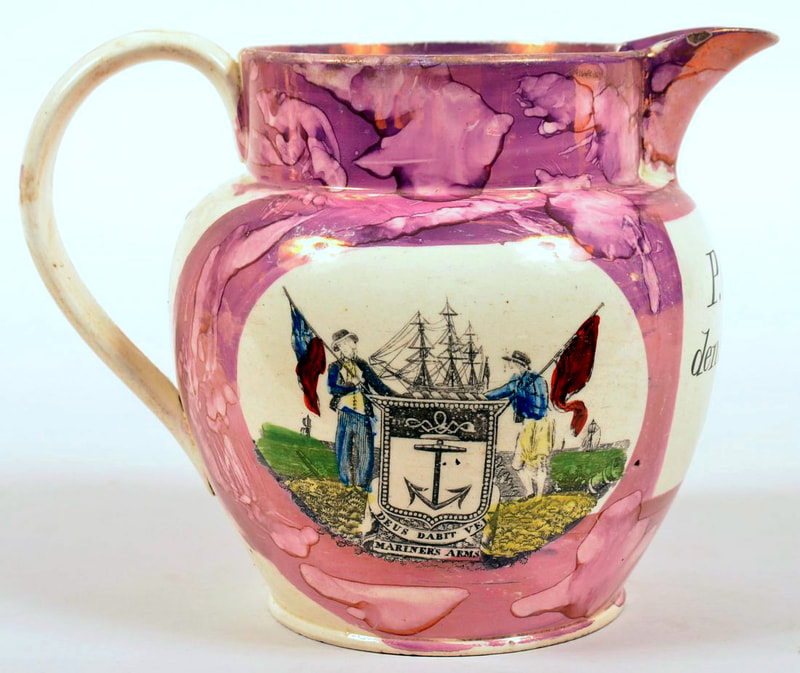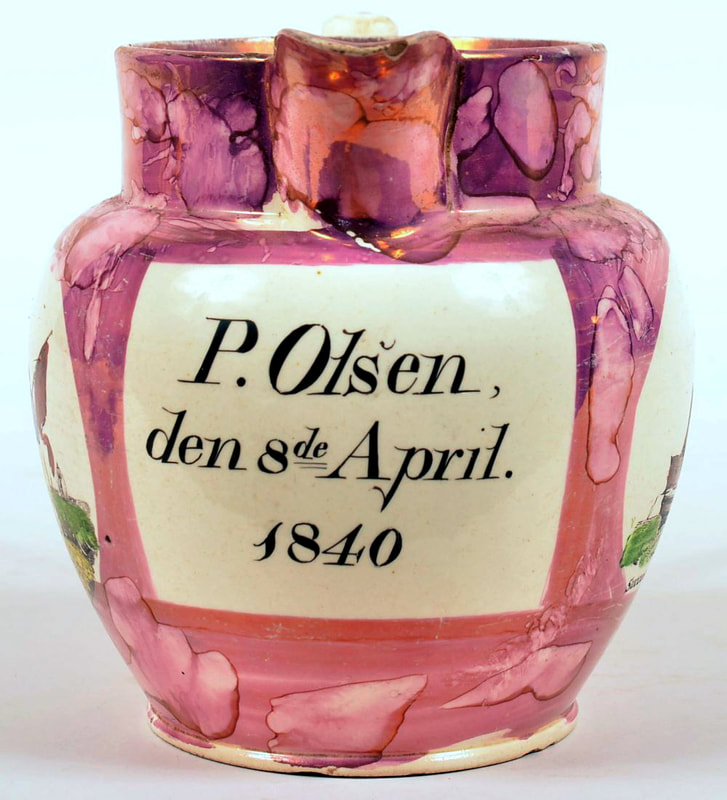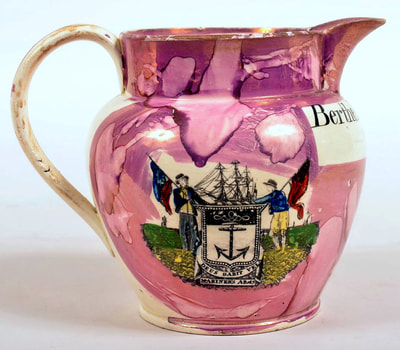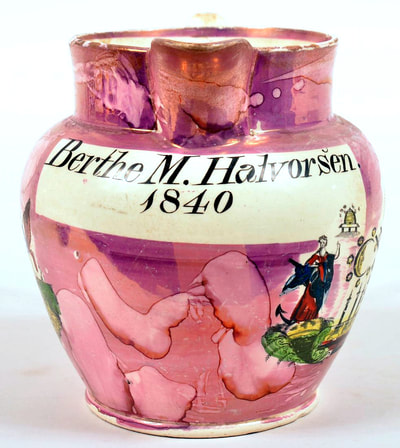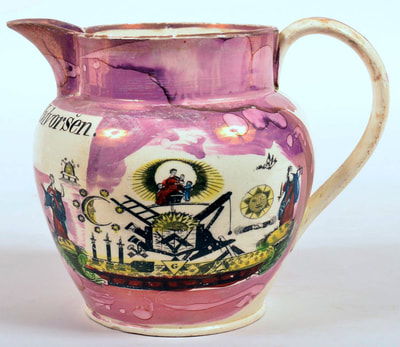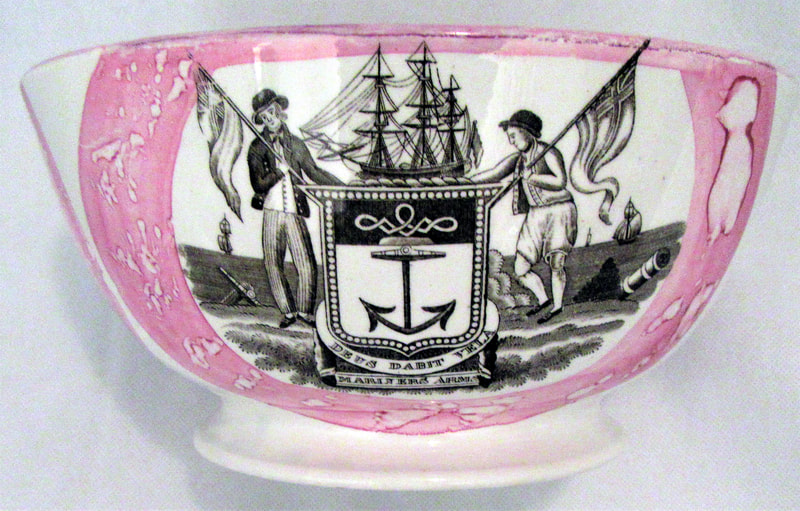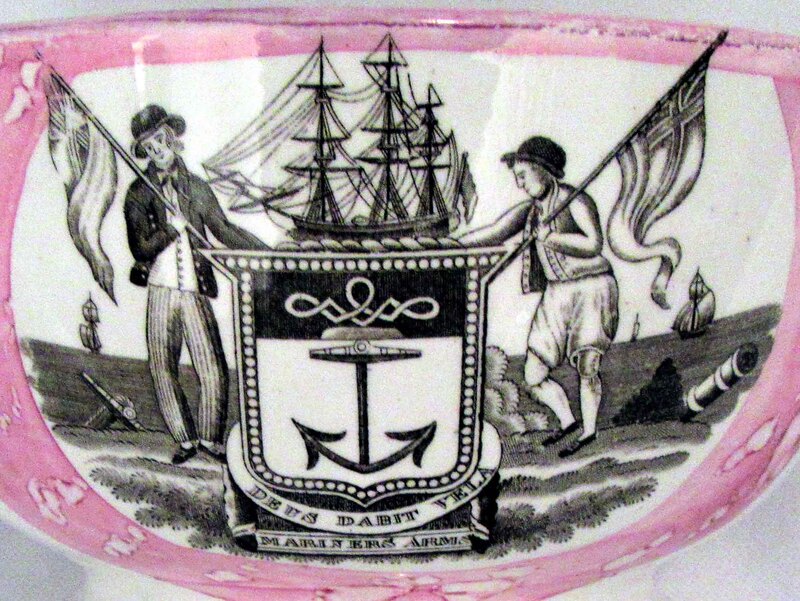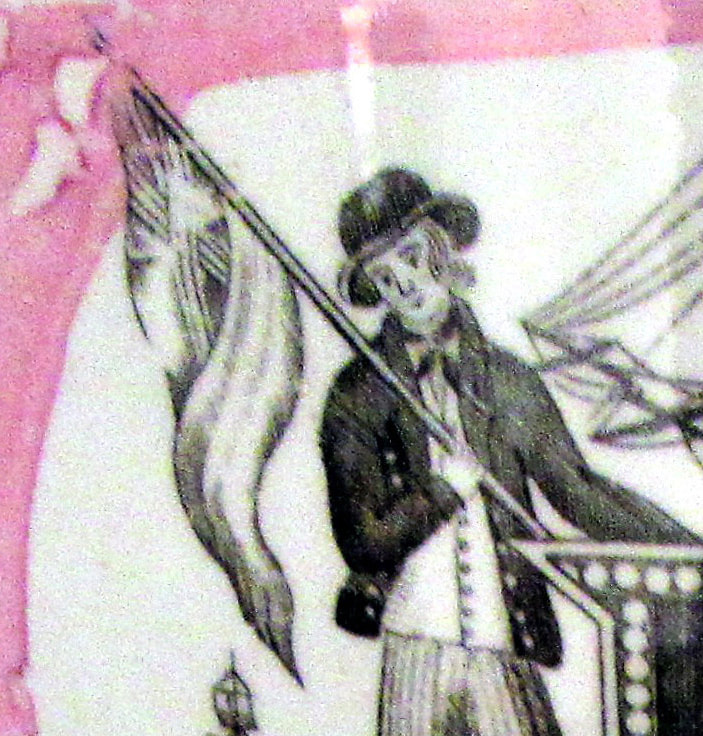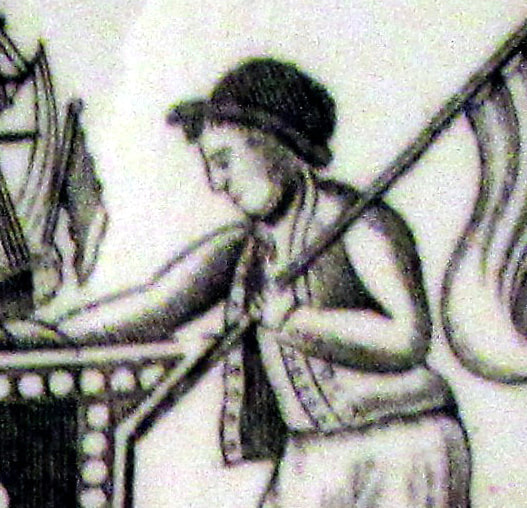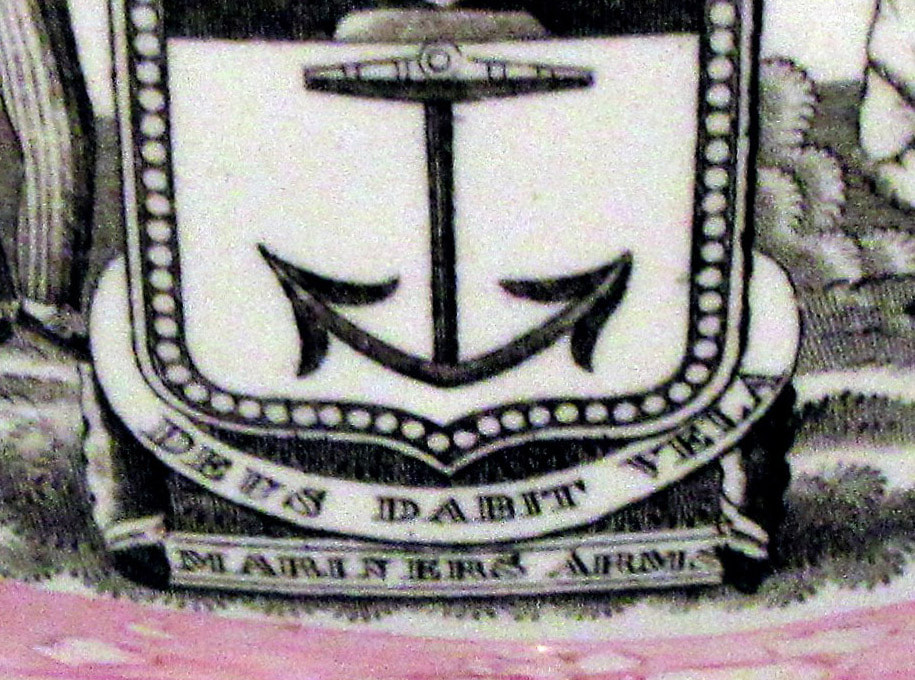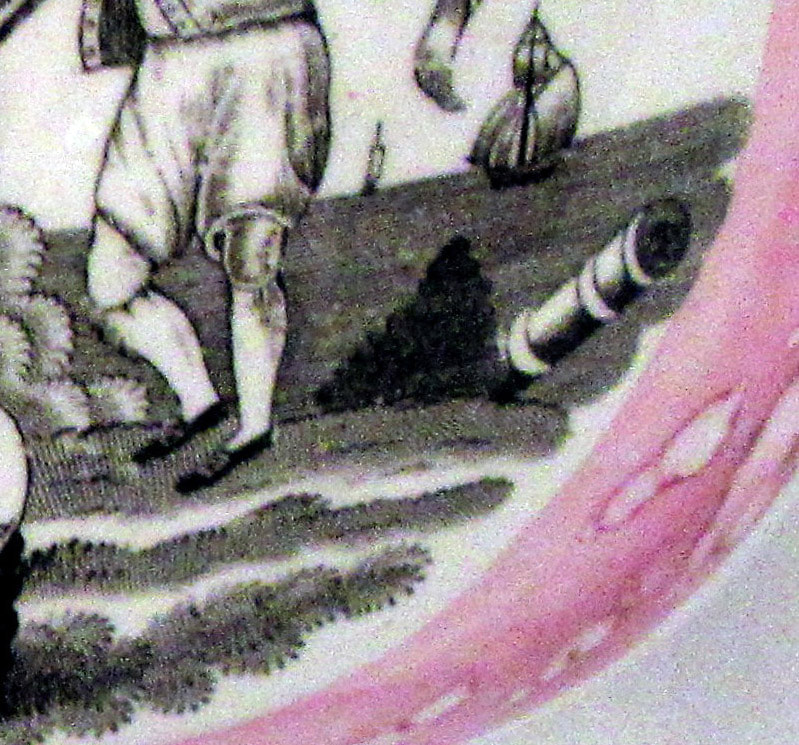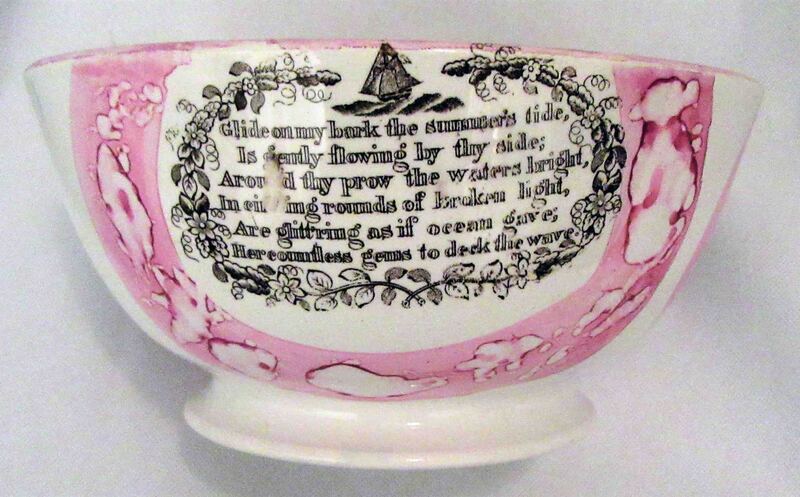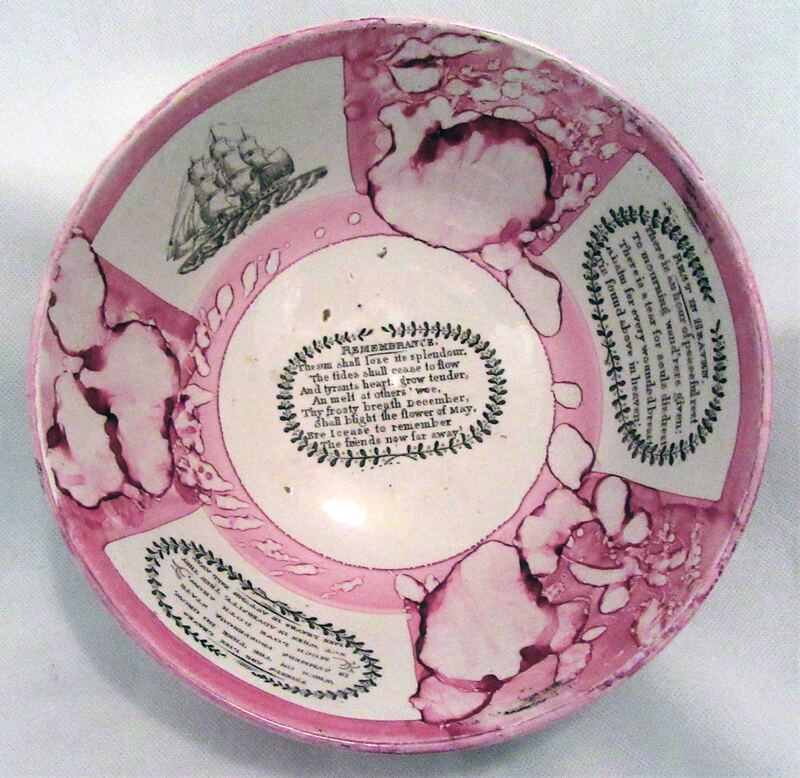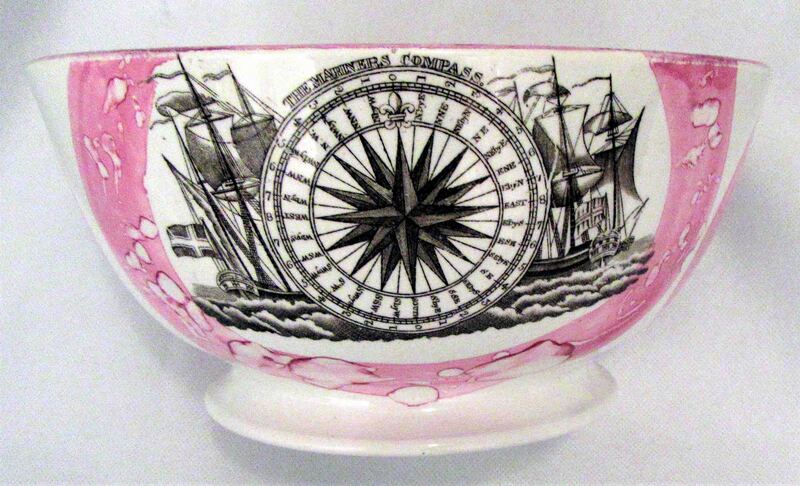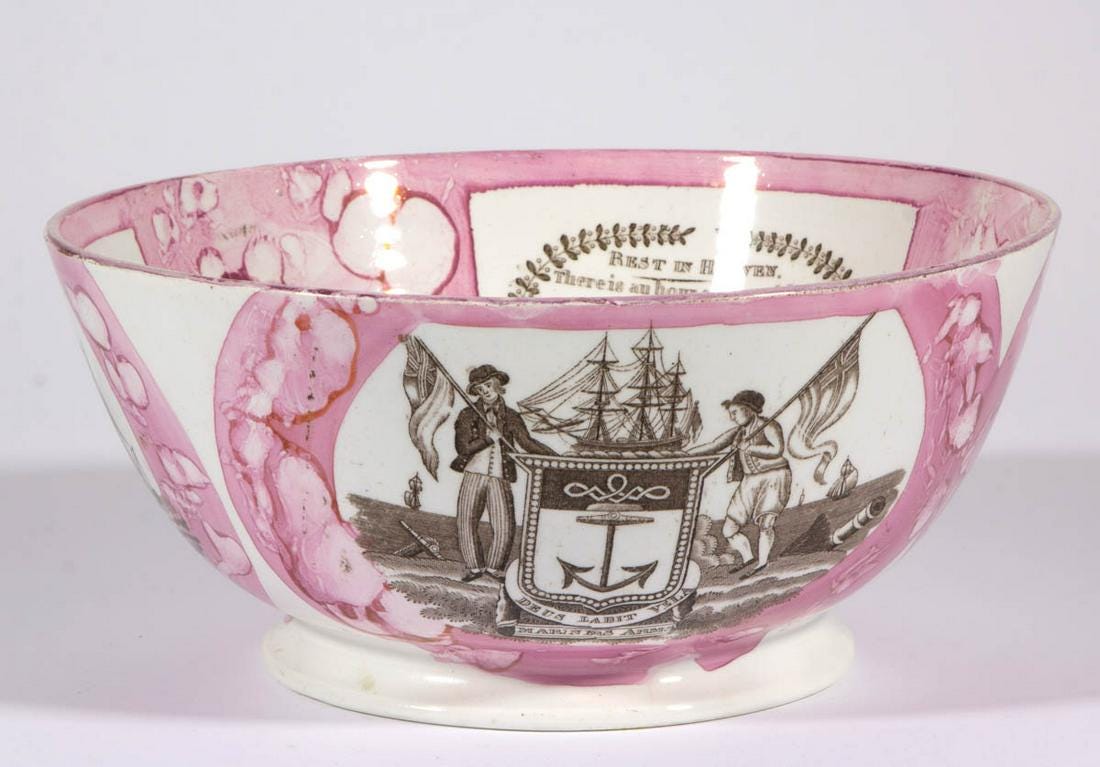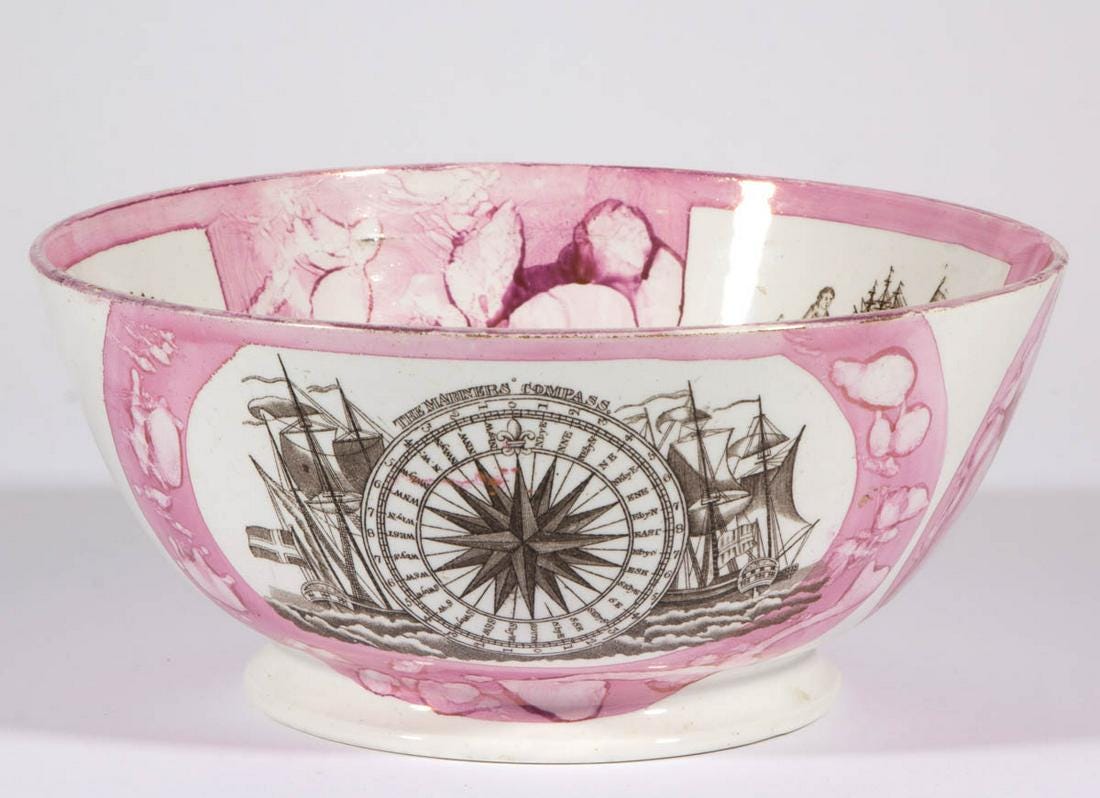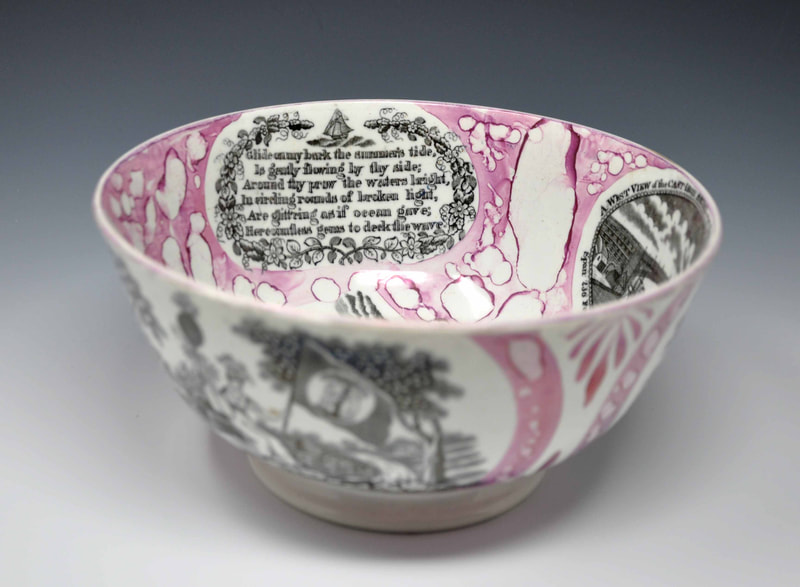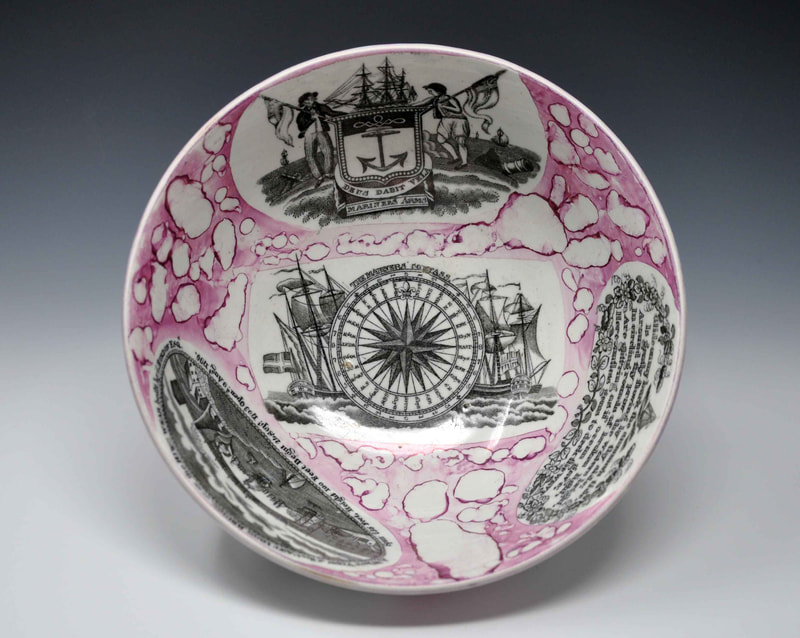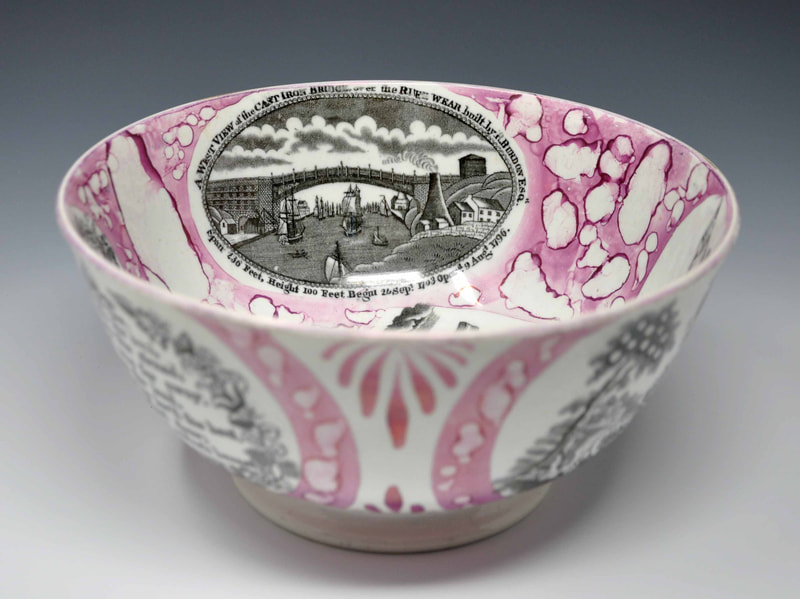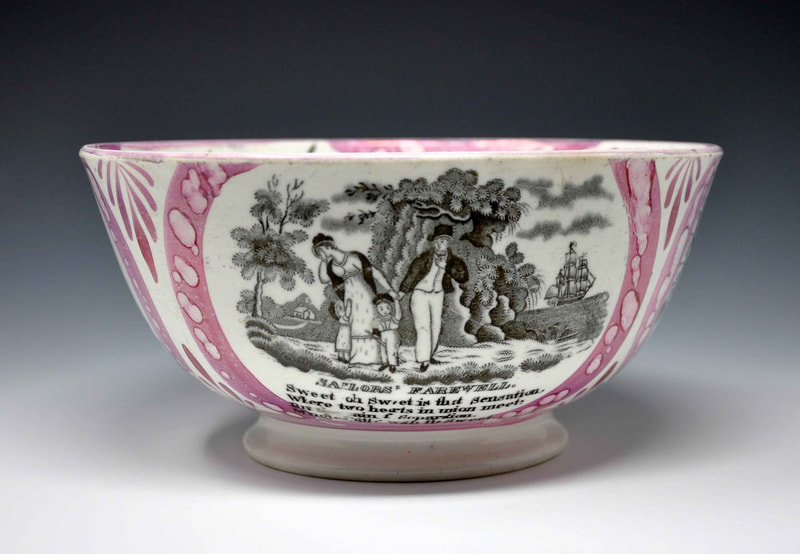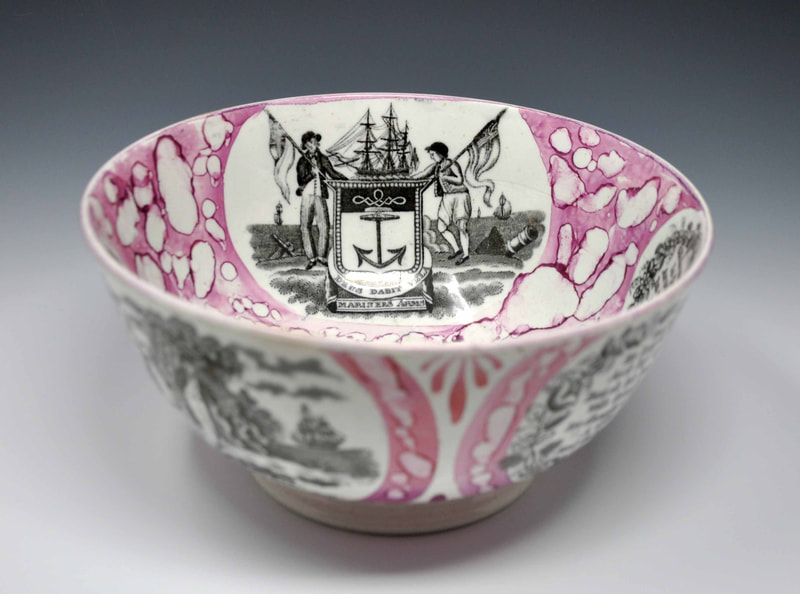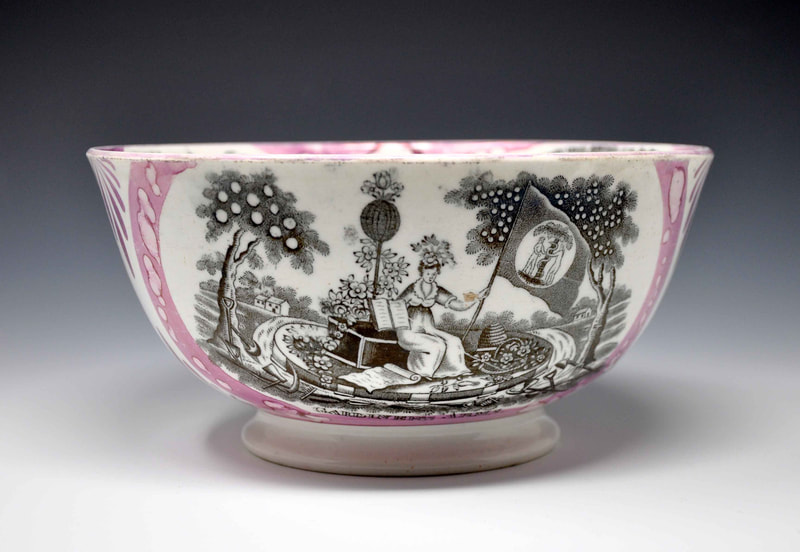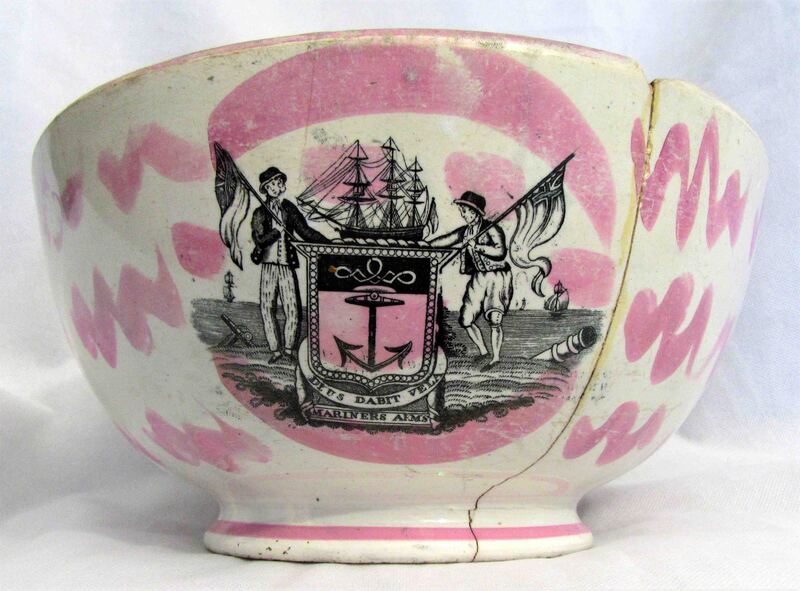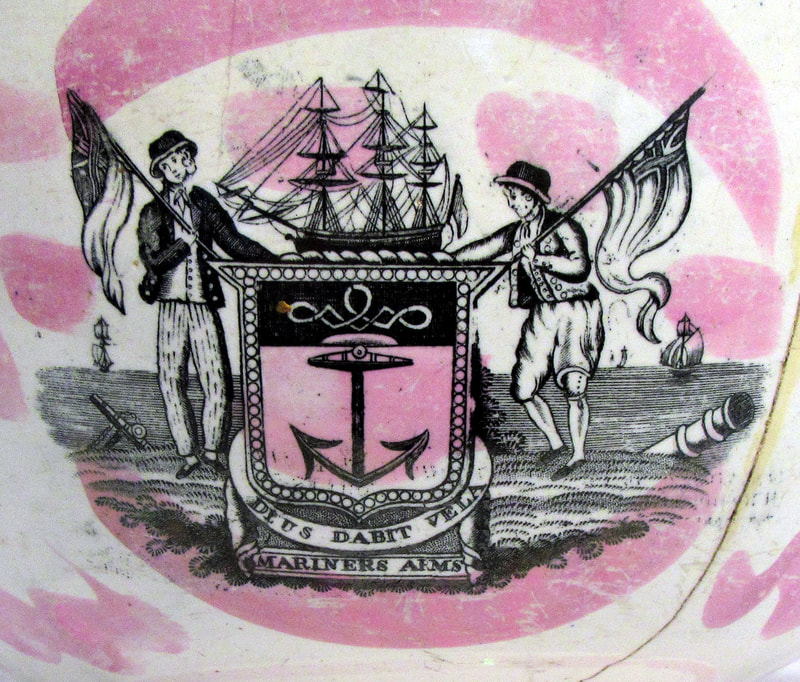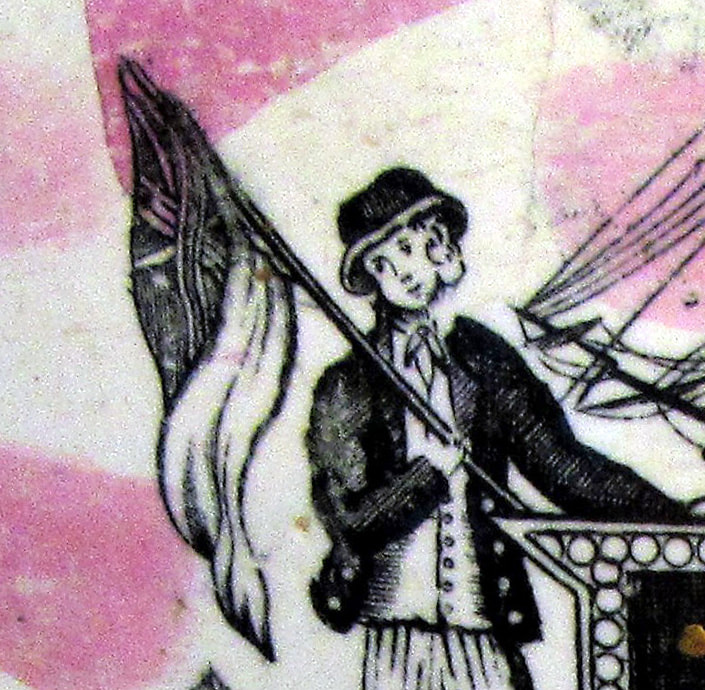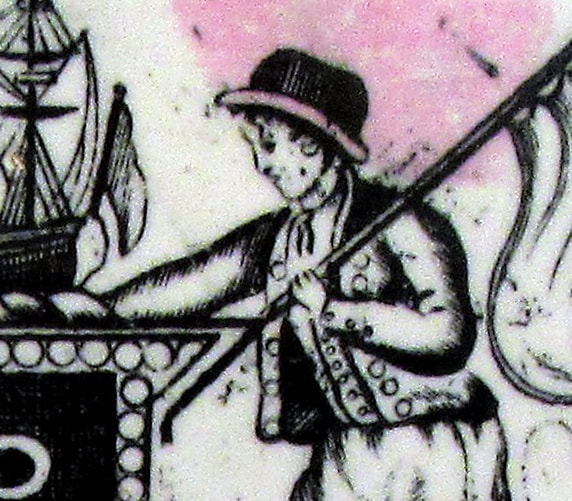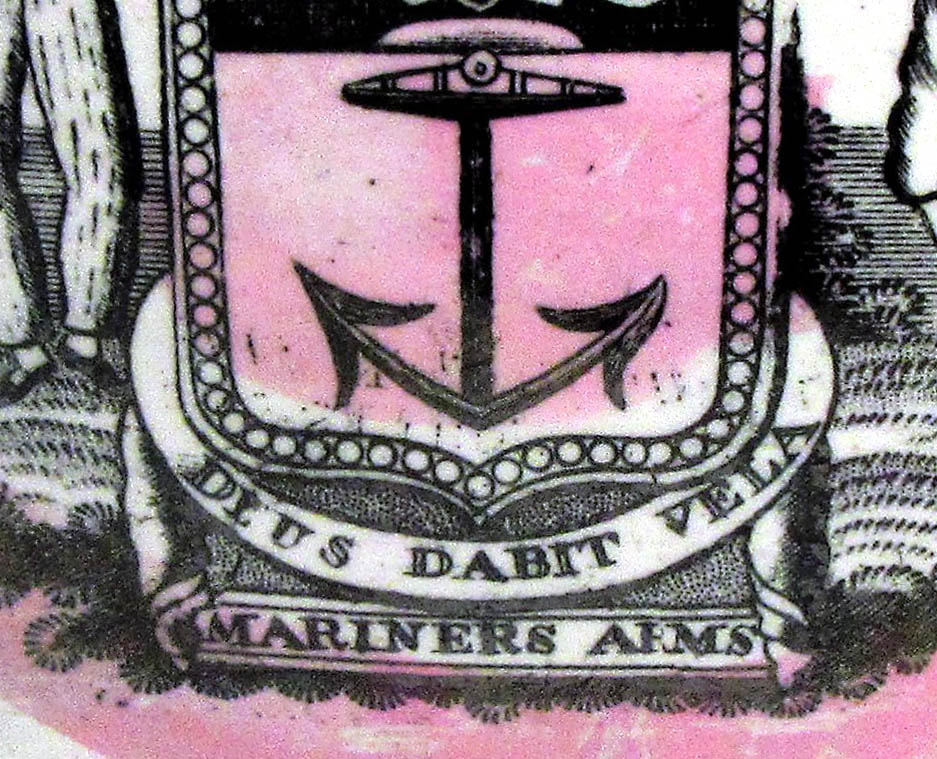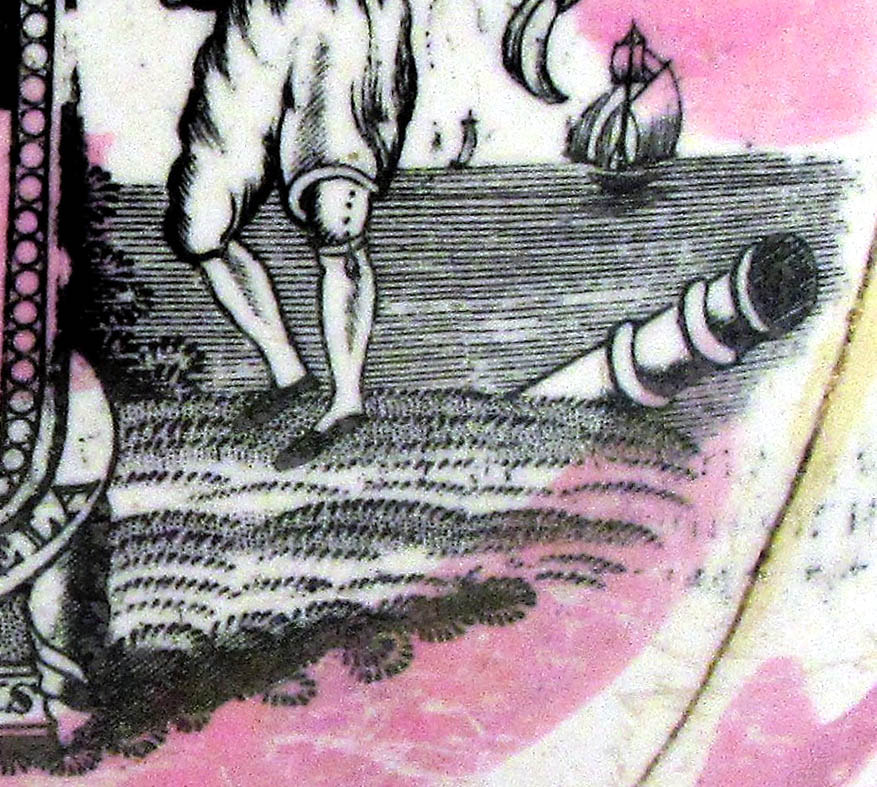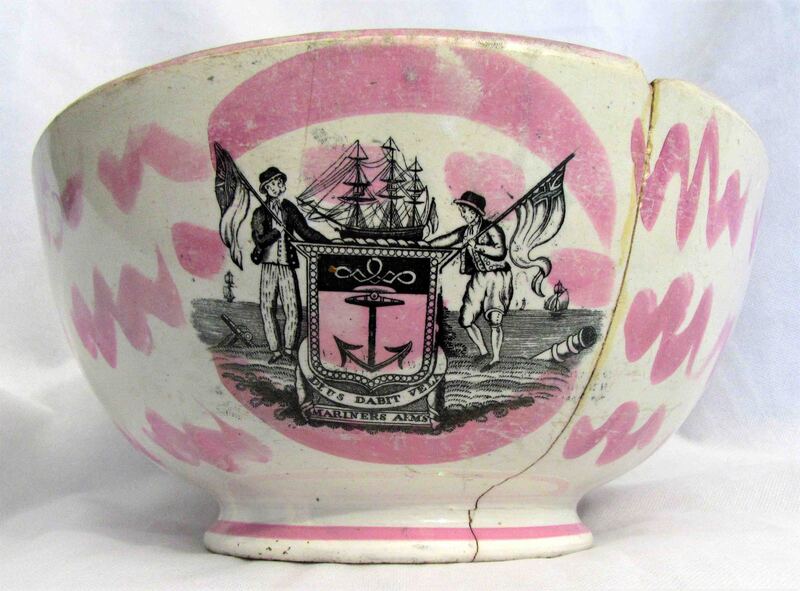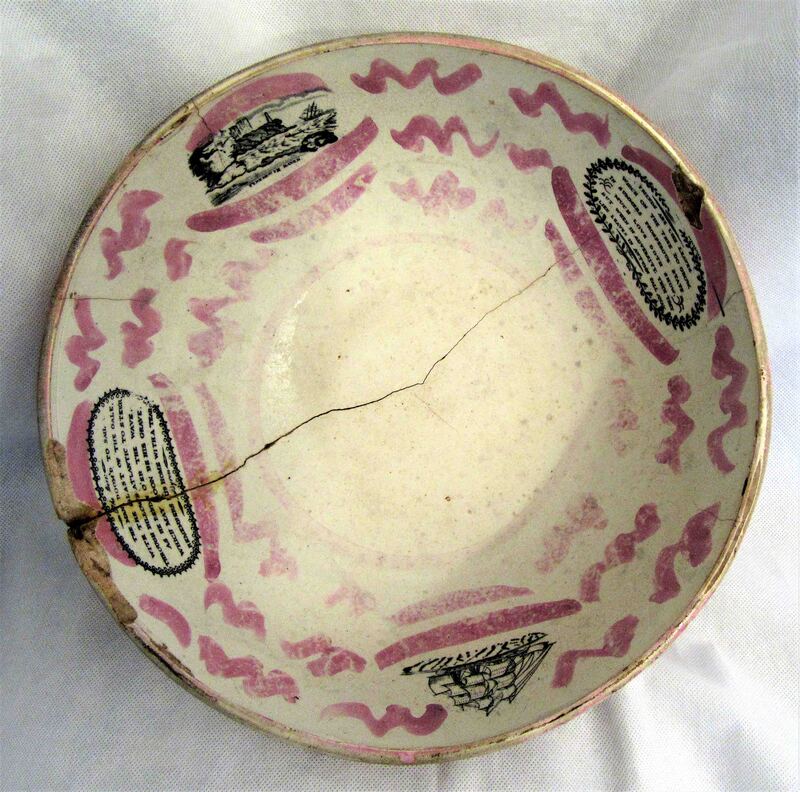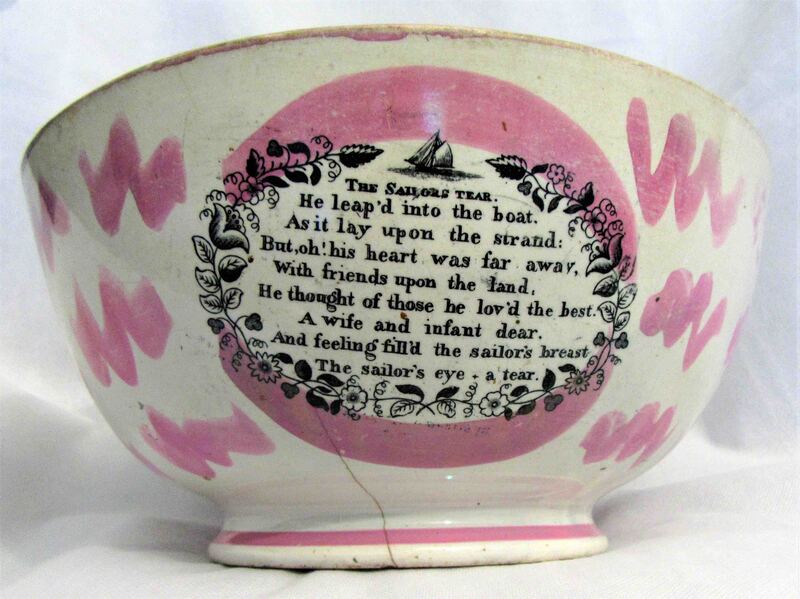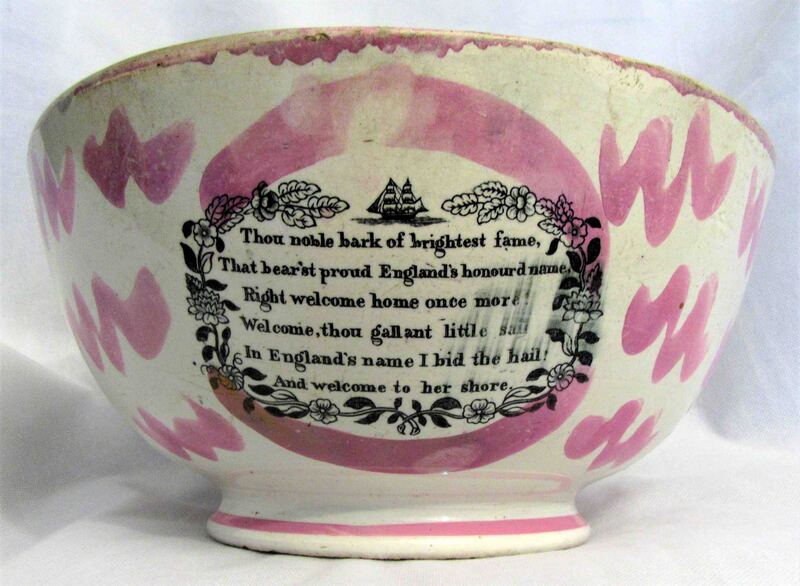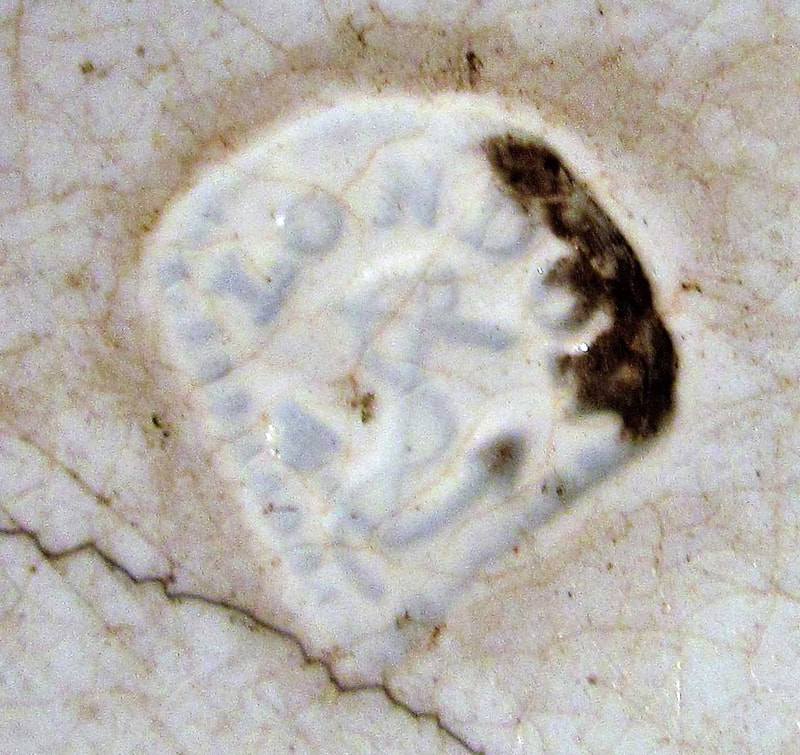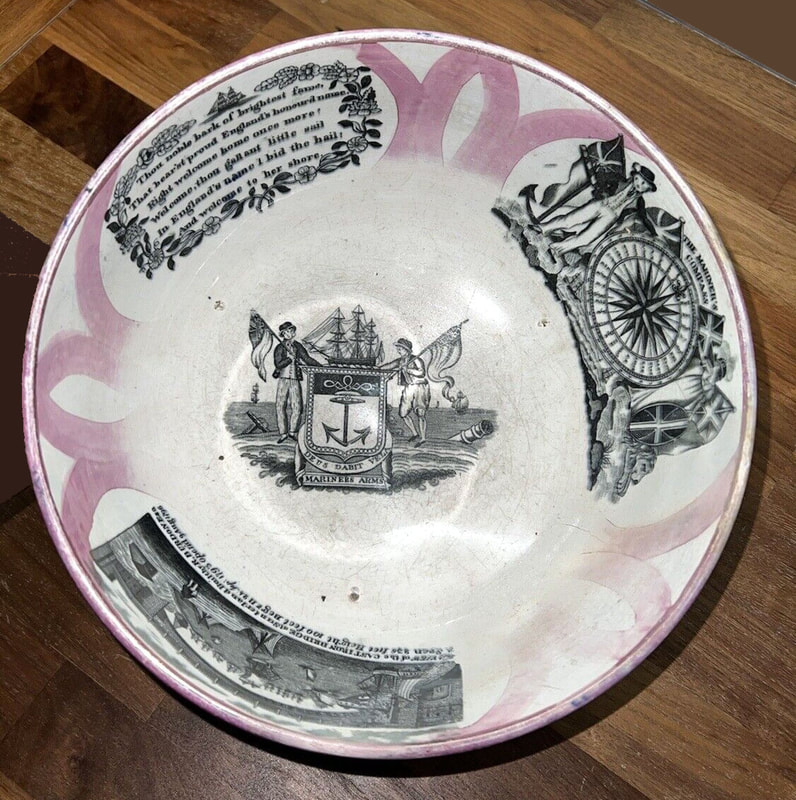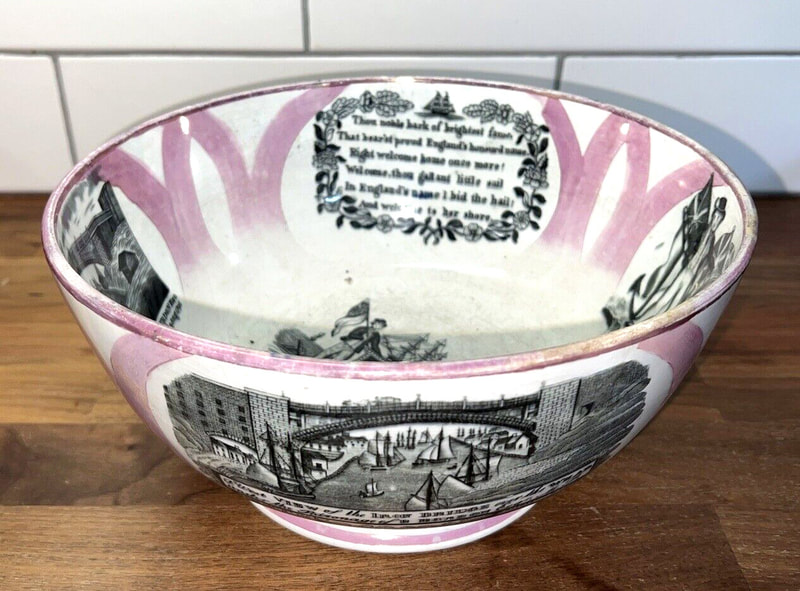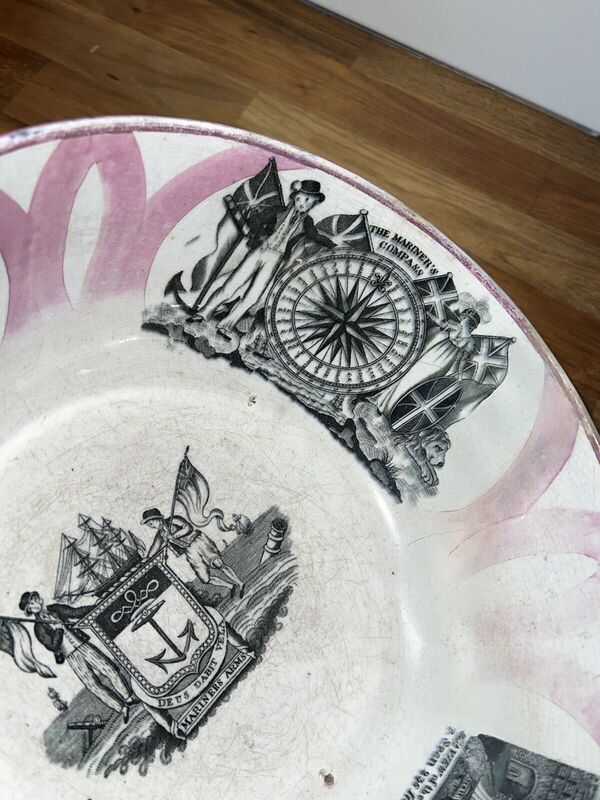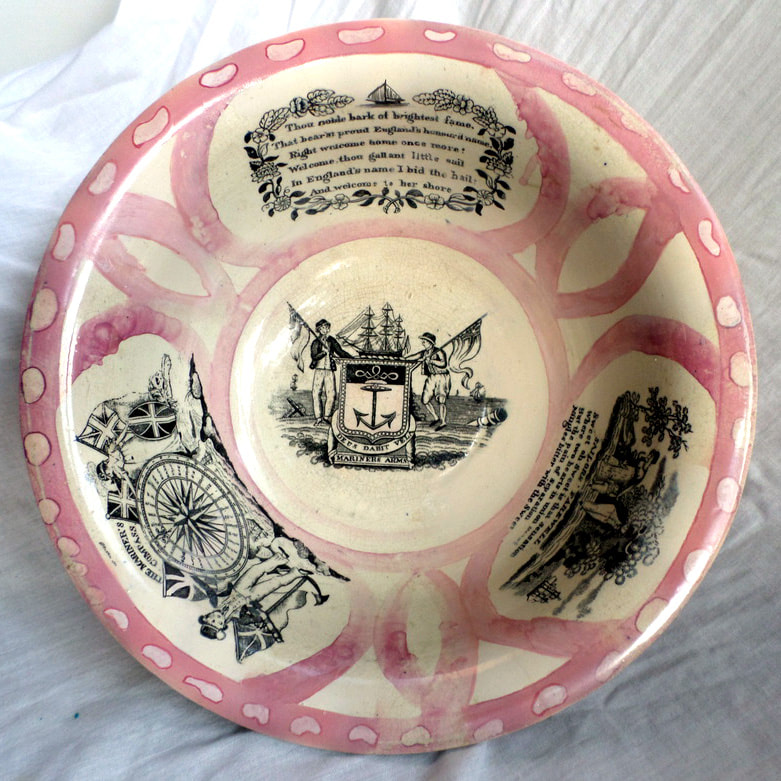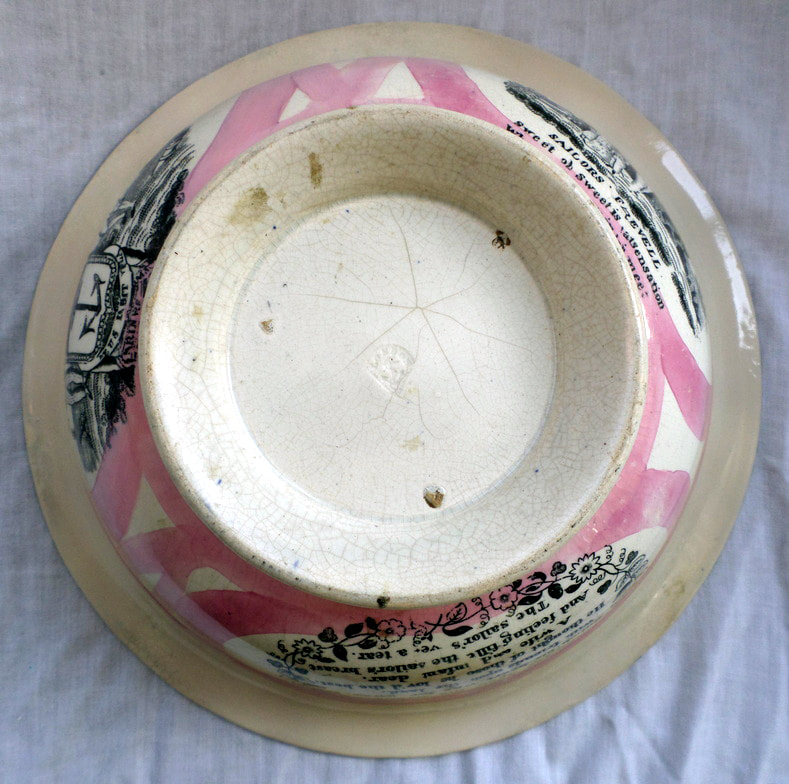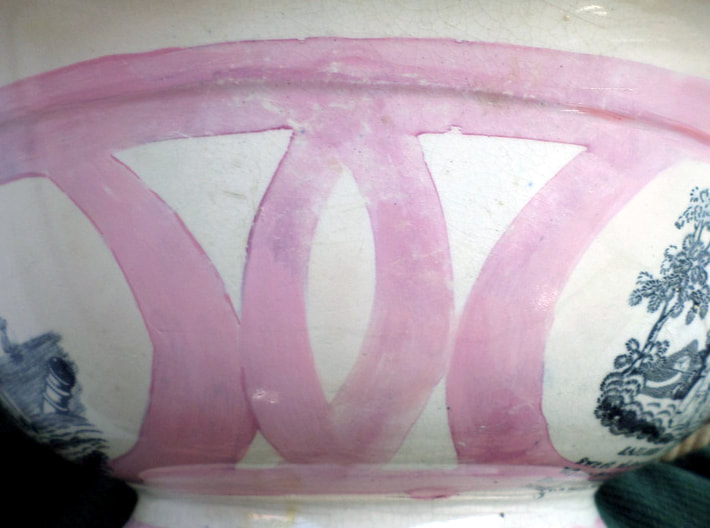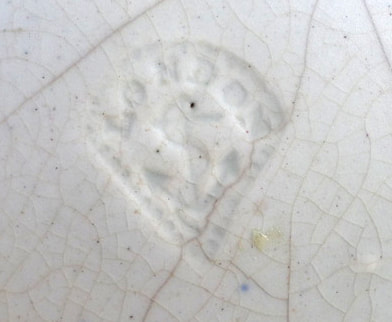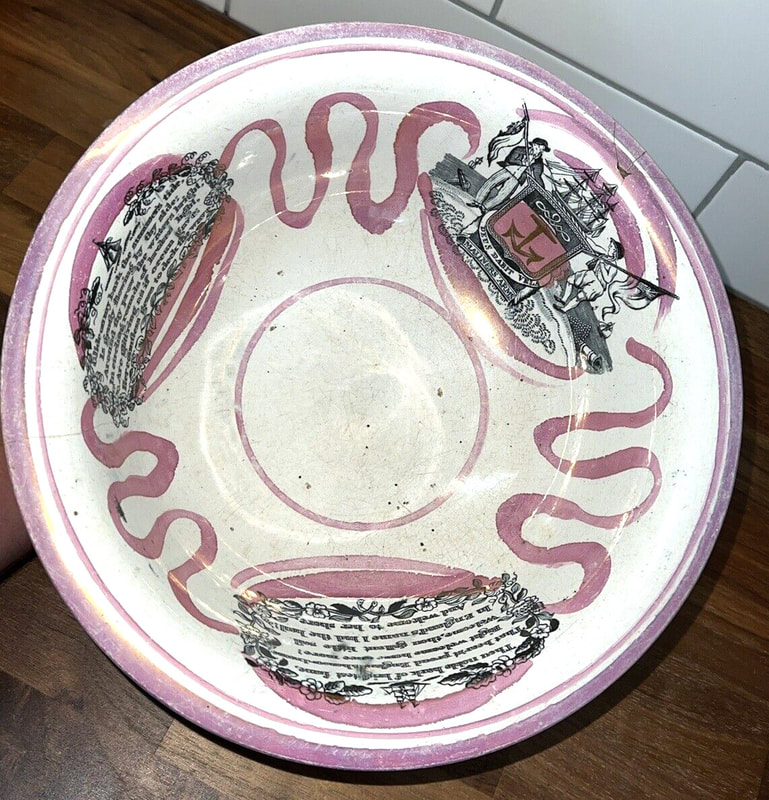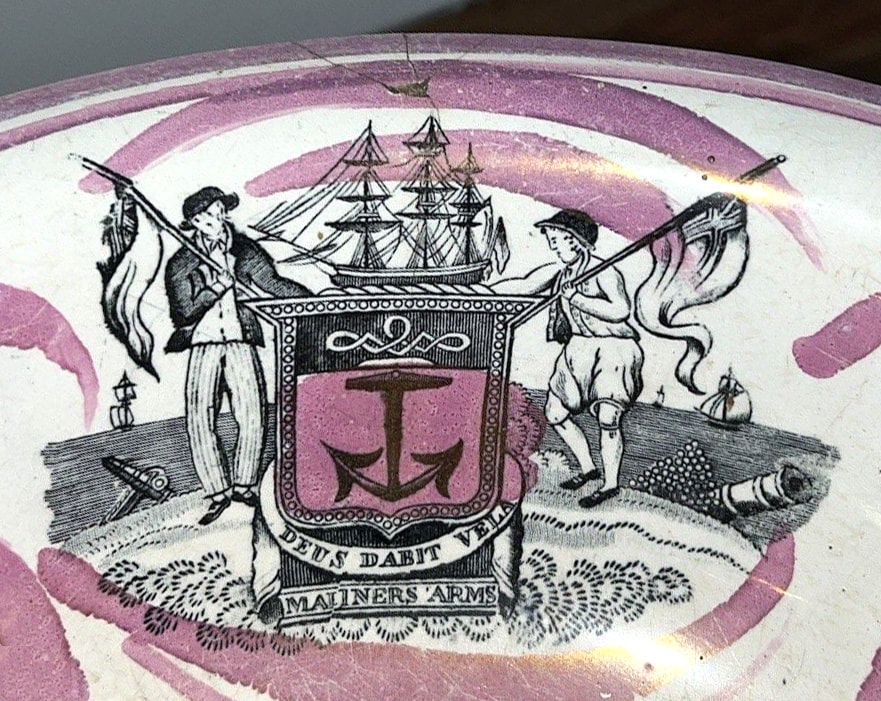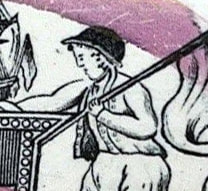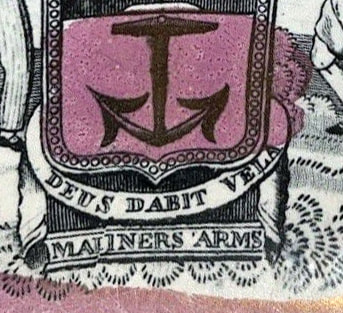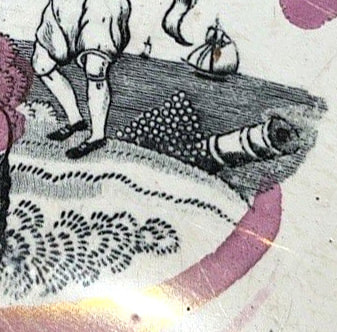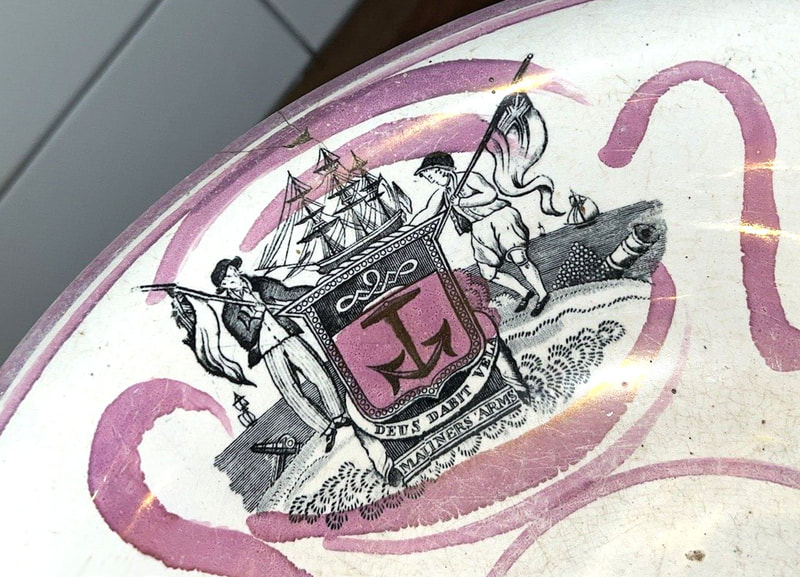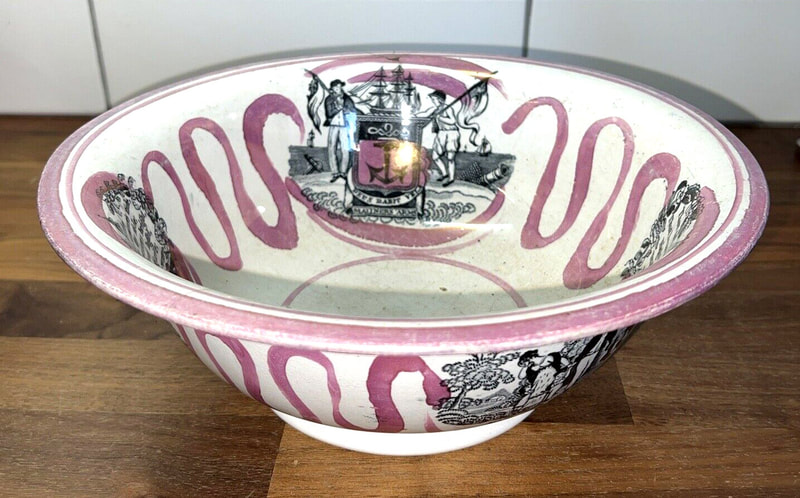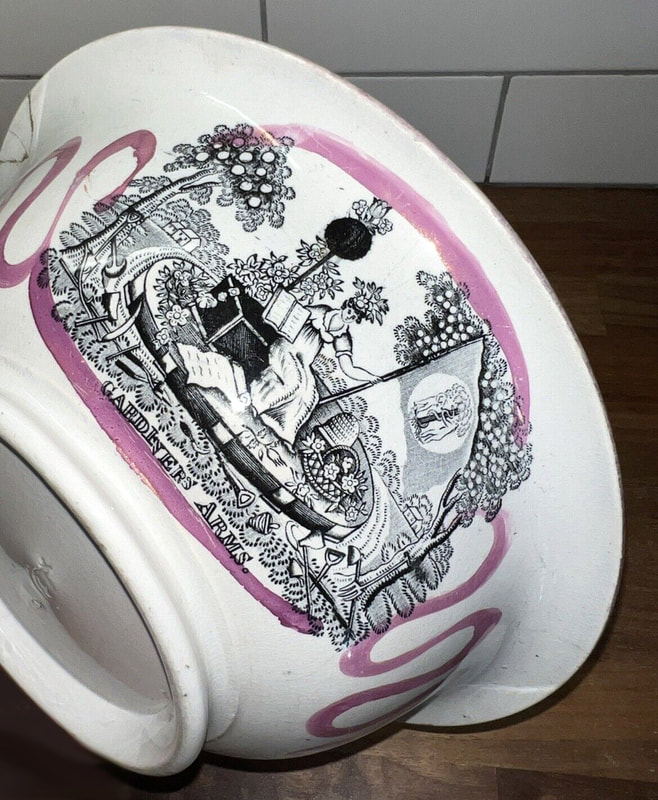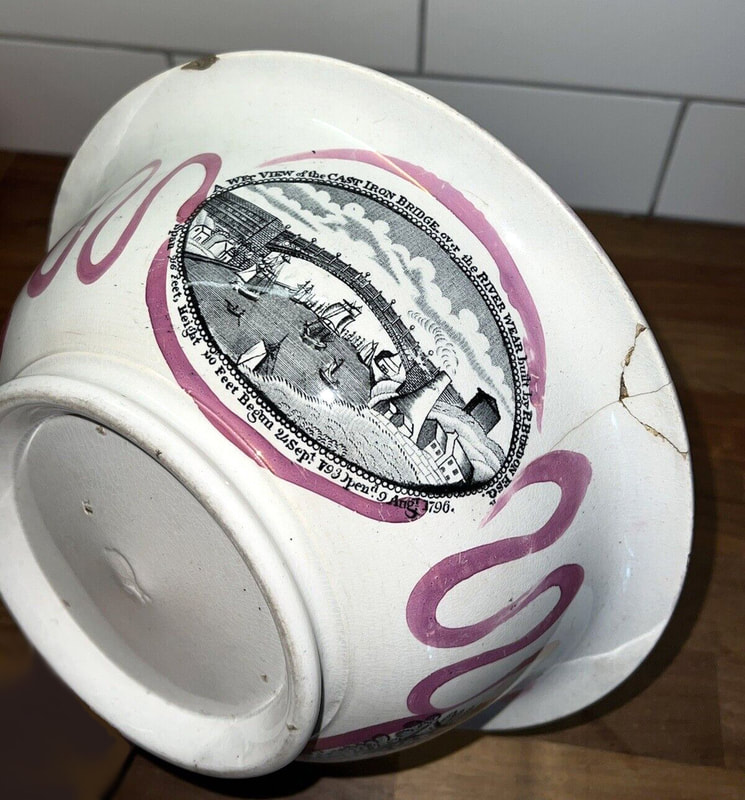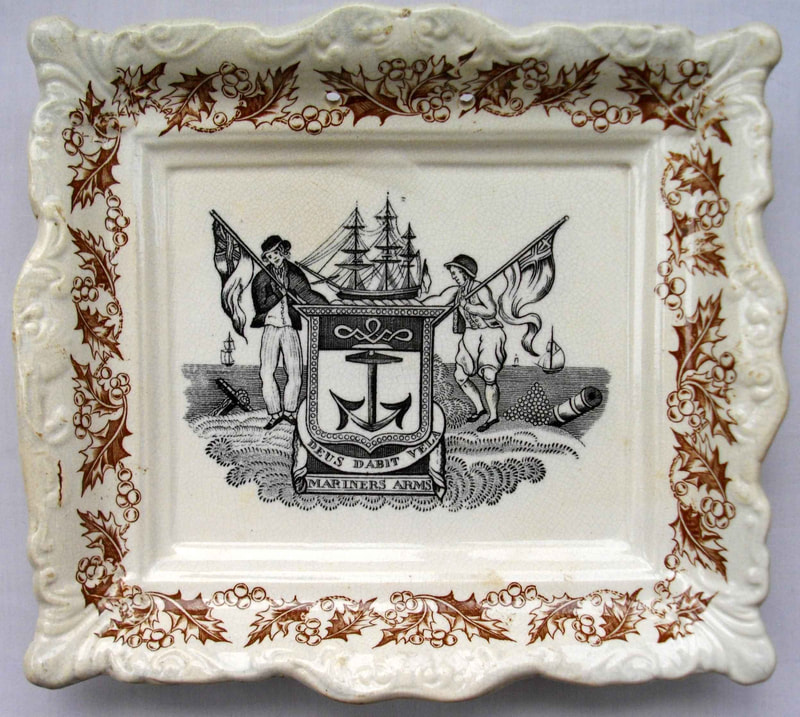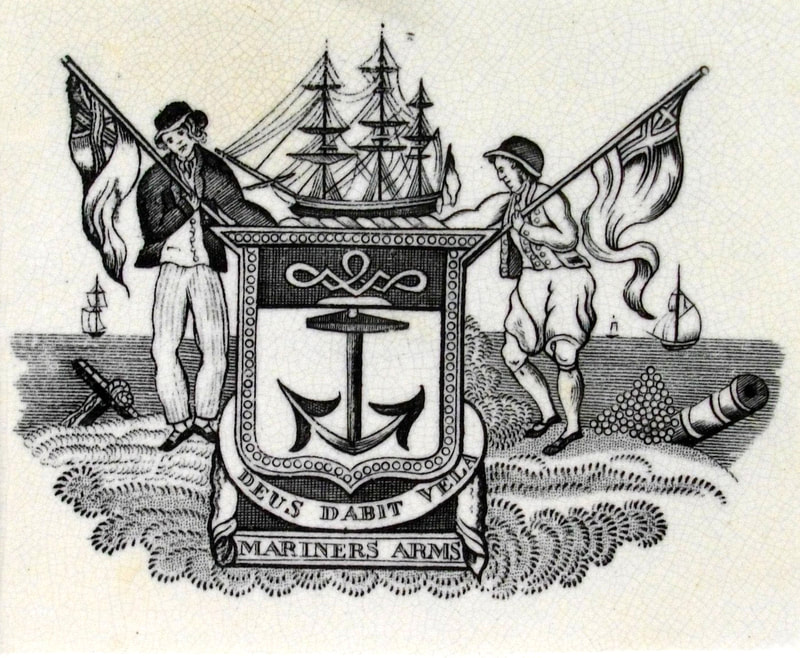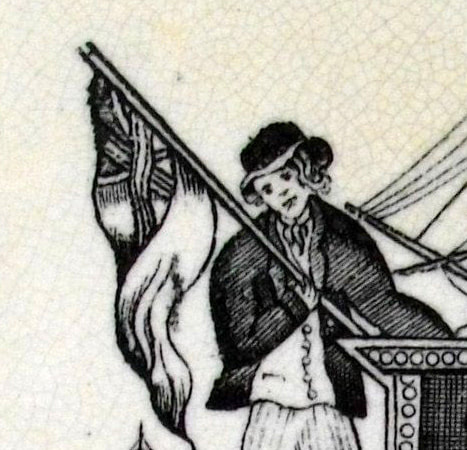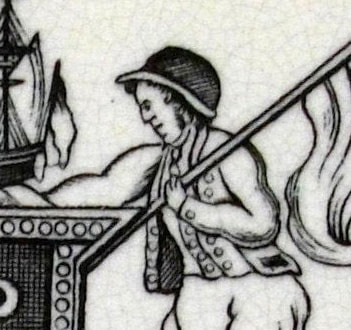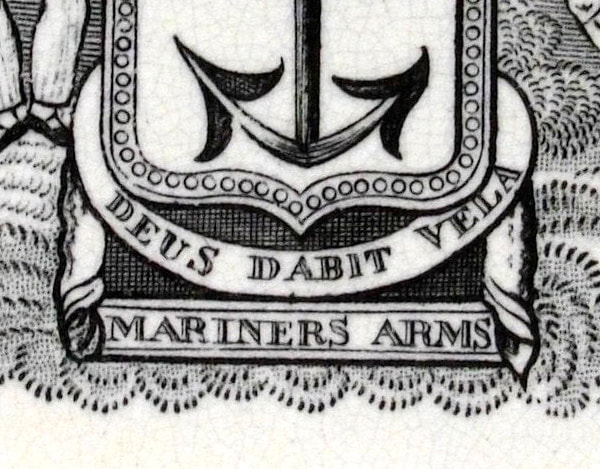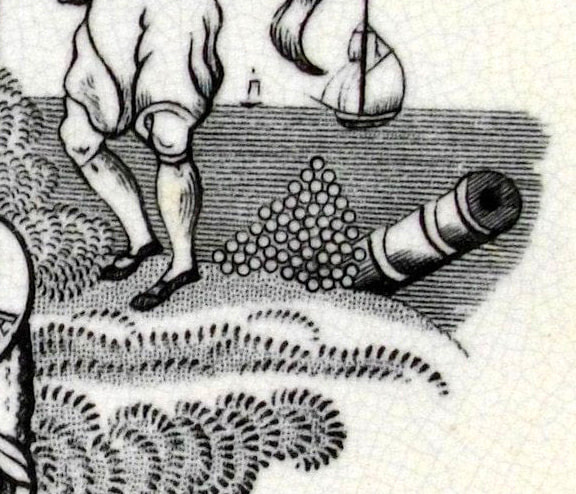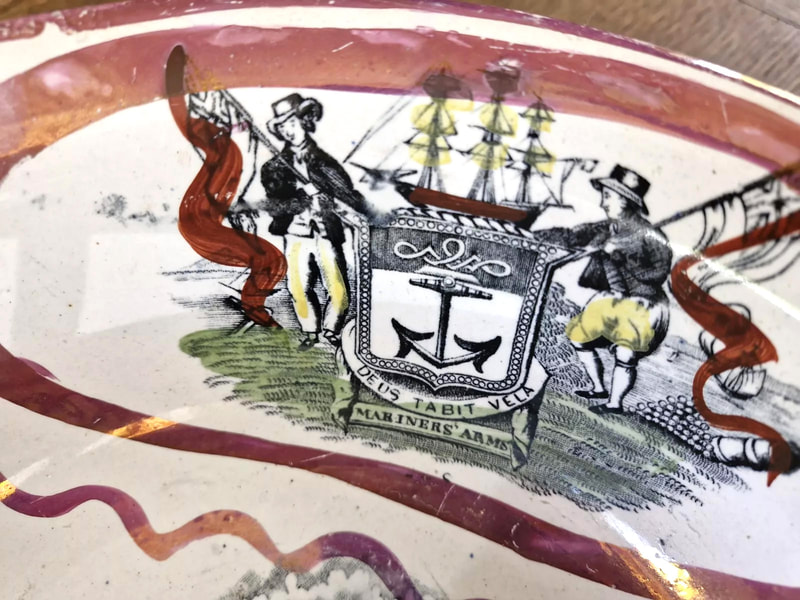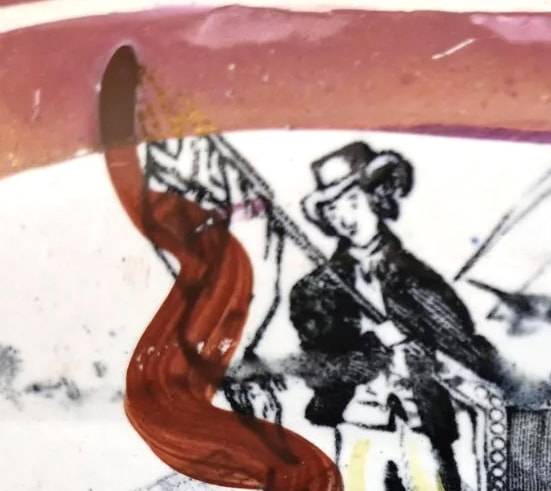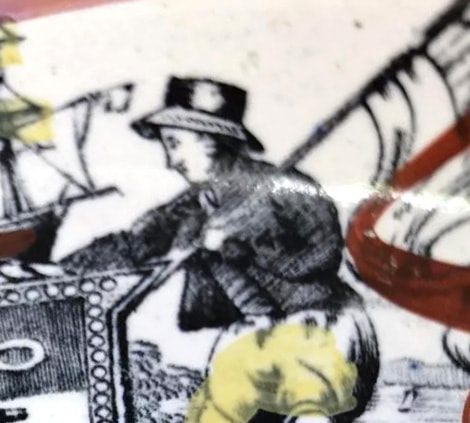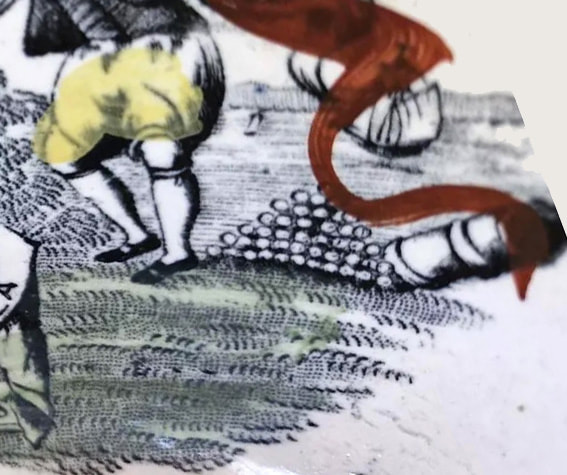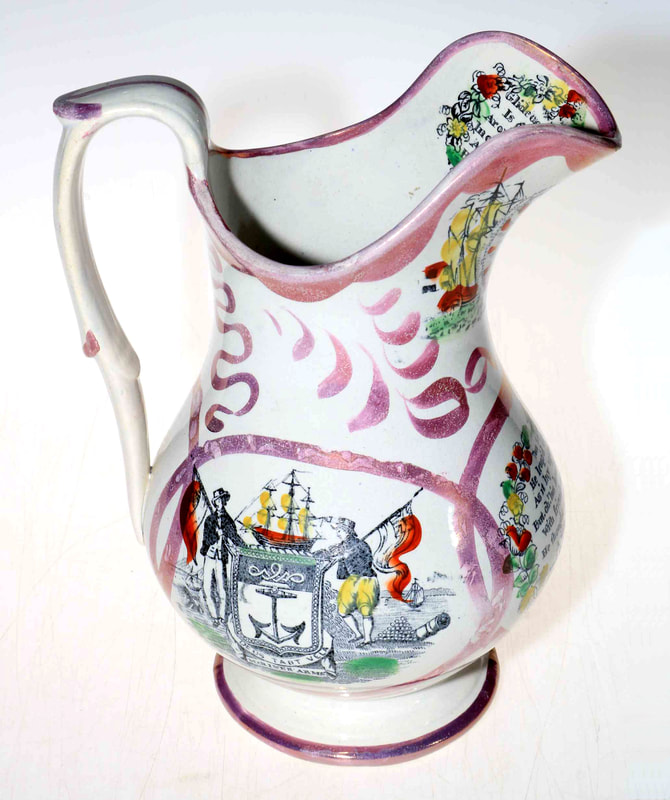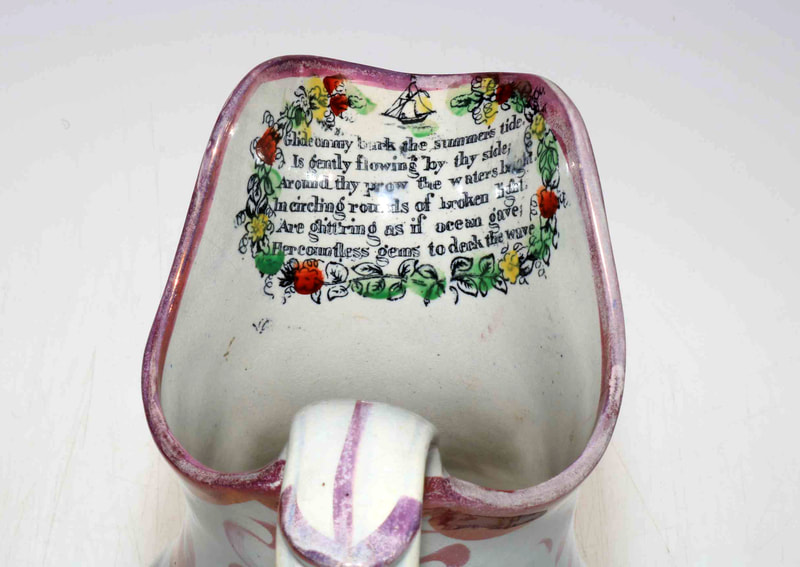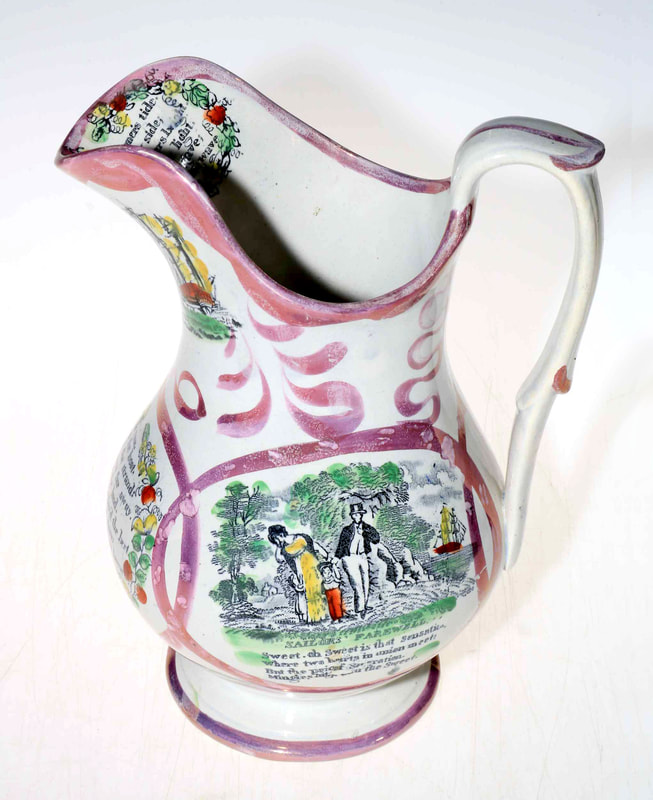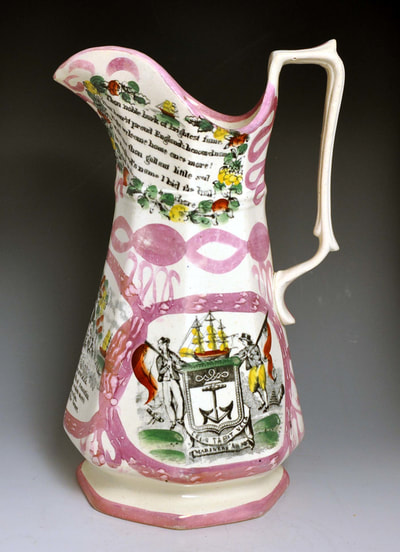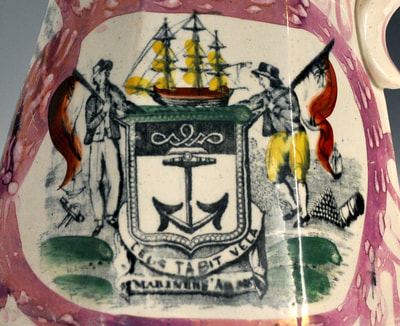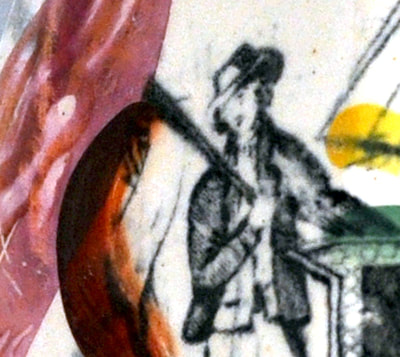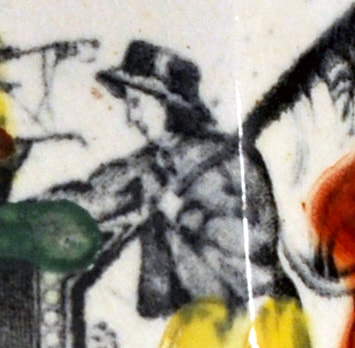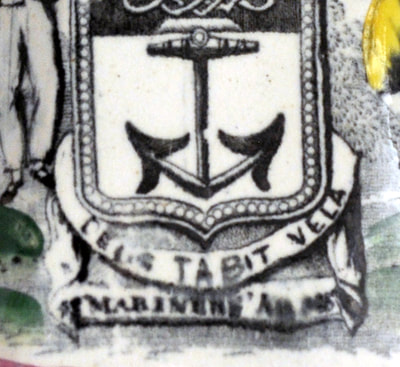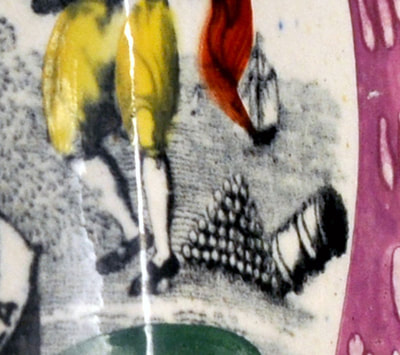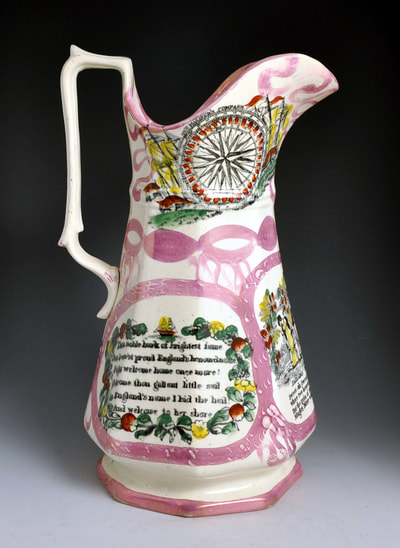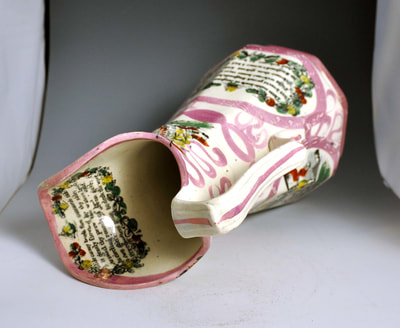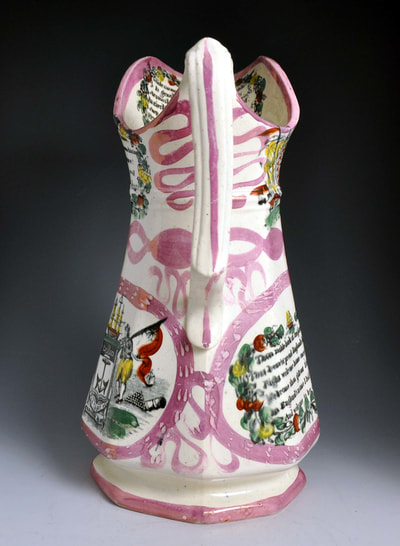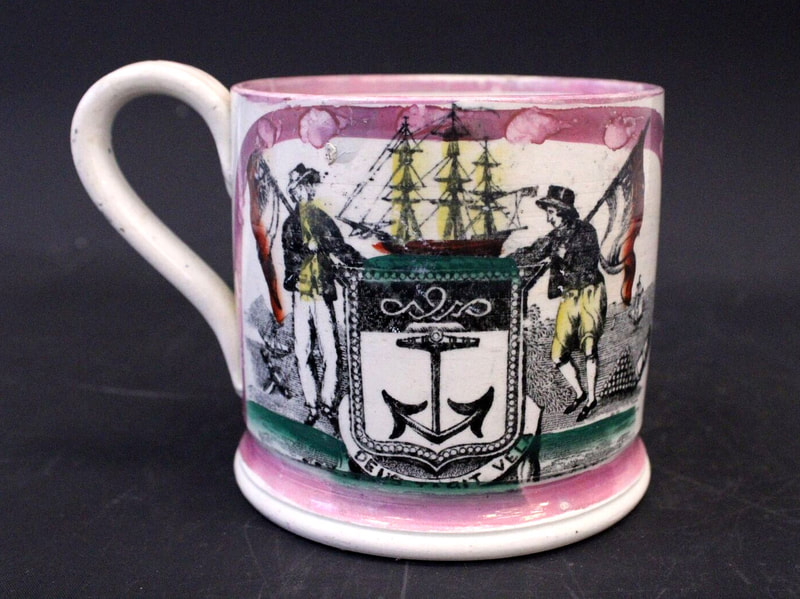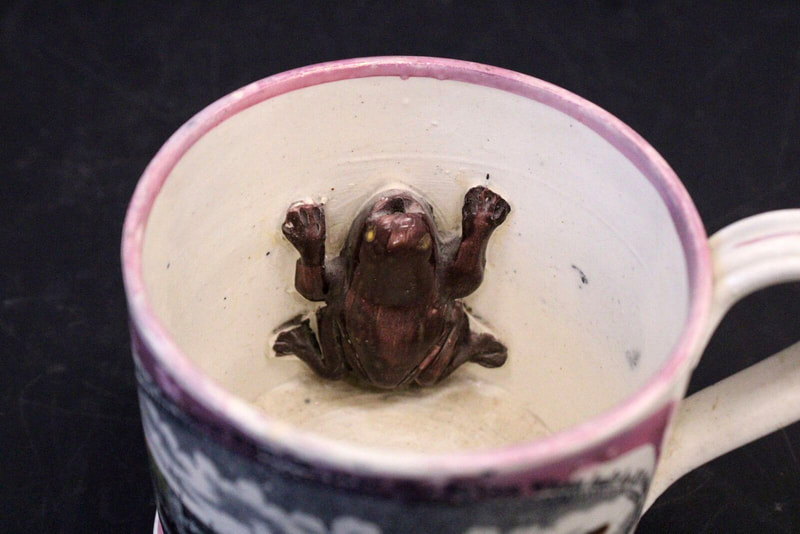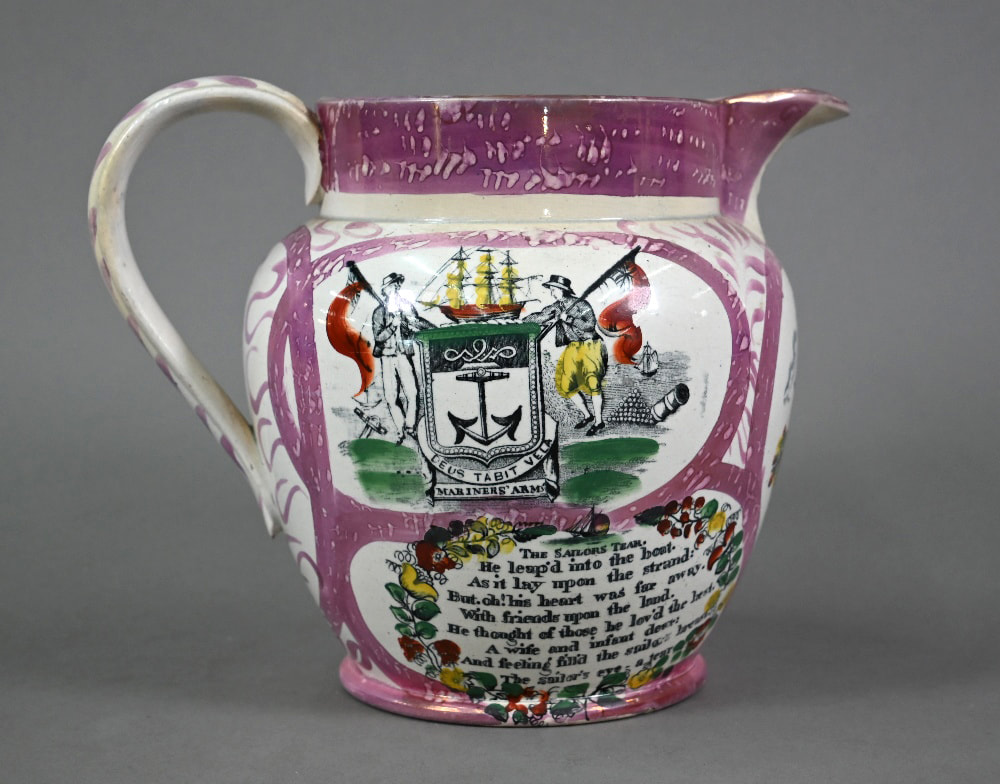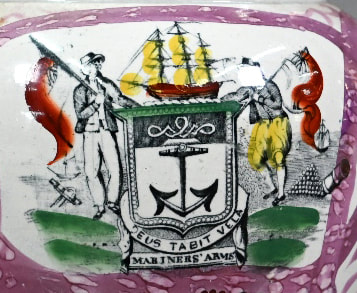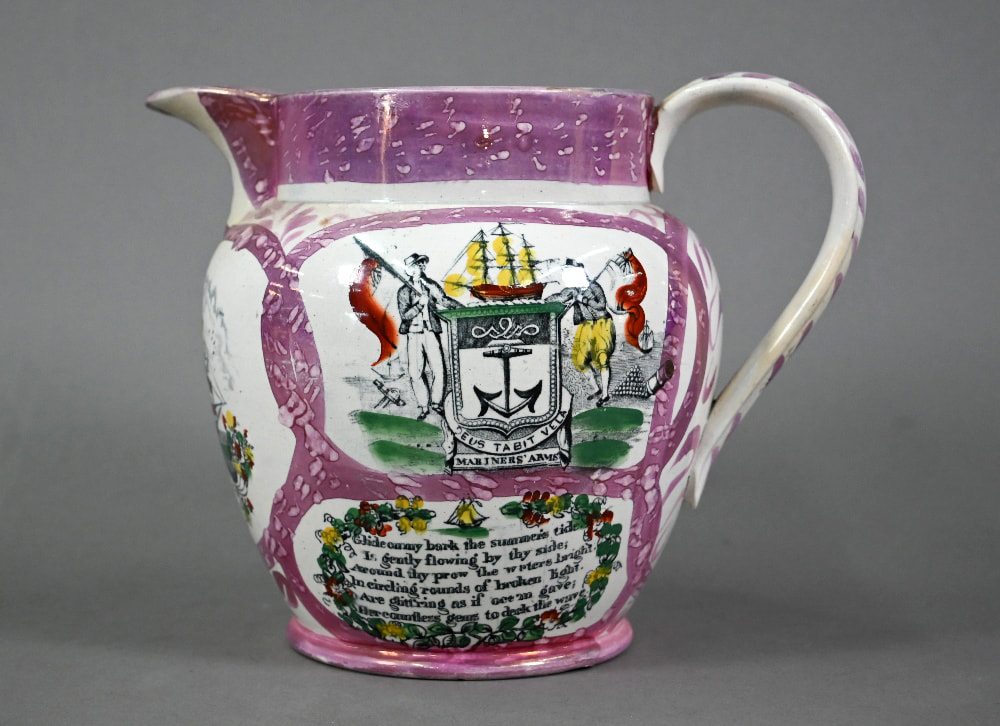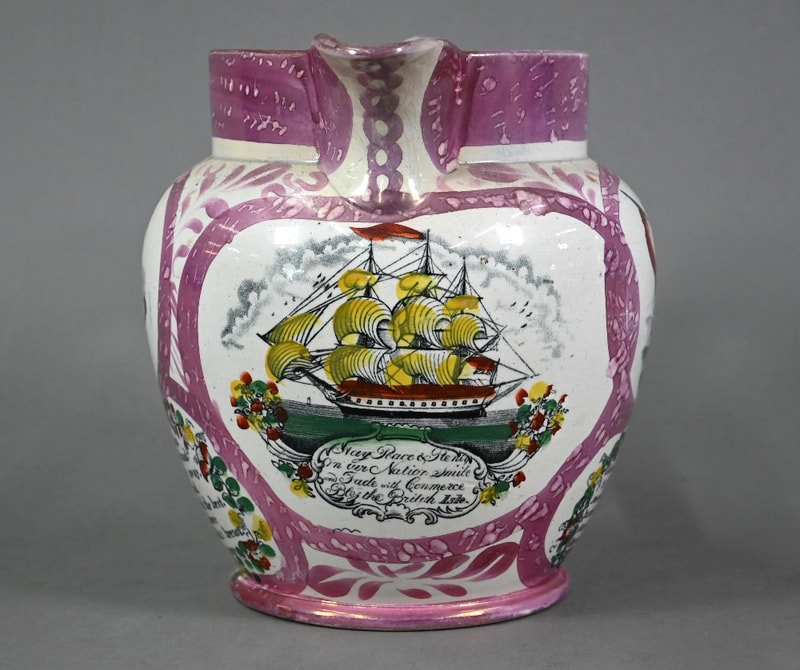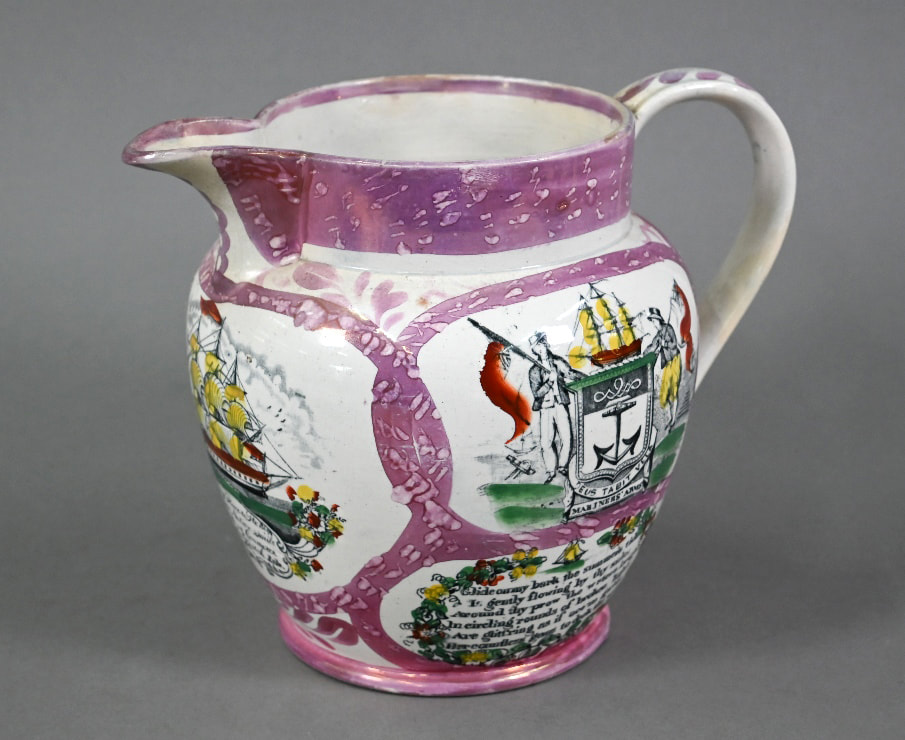Mariners' Arms – Sunderland
John Phillips & Co, and Dixon, Austin & Co – Garrison Pottery 1
Below is a creamware frog mug c1820. Note the zig-zag of foliage to the right of the shield (bottom centre detail). See the Dawson section below for a similar rendering of the subject. The transfer has been decorated with over-enamels.
The mug has a typical Dixon frog. The second larger mug beneath it, from the Sunderland Museum & Winter Gardens, Tyne & Wear Archives & Museums collection, has a flower sprig decoration, typical of early J Phillips & Co Sunderland Pottery items, and is likely pre-1820s.
An example with pink-lustre decoration. The creamware body of the mug suggests it is likely 1820s.
A large Dixon jug with the same transfer and a hand-painted inscription dated 1830.
Dixon, Phillips & Co – Garrison Pottery 2
This bowl has the Dixon Phillips with anchor impress used before 1850.
- Left figure has no buttons on coat on left side (top right detail)
- Left hat brim not shaded, right hat brim shaded
- Apostrophe after the word 'Mariners'
- Pile of cannonballs in front of cannon
Dixon, Phillips & Co – Garrison Pottery 3
This transfer has that same attributes as the one above, and is an almost identical copy. The foliage in the foreground, however, differs. Although unmarked, the lustre decoration and transfers on this jug are typical of the Garrison Pottery c1850.
- Left figure has no buttons on coat on left side (top right detail)
- Left hat brim not shaded, right hat brim shaded
- Apostrophe after the word 'Mariners'
- Pile of cannonballs in front of cannon (last detail)
The second jug above has a painted inscription for 1848. The wash bowl below has an impressed mark for 'DixonCo' over the number '8'.
A wash ewer, that would once have paired with a bowl like the one above.
This version of the transfer was also used on frog mugs, with a large-sized frog. On the jug below, the transfer is overpainted with coloured enamels. These items are likely from the 1840s.
Dixon, Phillips & Co – Garrison Pottery 4
The transfer as it appears on a 'Dixon Co'-impressed washbowl with ewer decorated with Crimean transfers c1855.
- Left figure has two buttons on coat below left arm and none above (top right detail)
- Brims to hats are shaded
- Apostrophe after the word 'Mariners'
- Pile of cannonballs in front of cannon (last detail)
The slop bowl below was also likely made in the 1850s. Note the silhouette of the foliage to the right of the shield.
The bowl below has a weaker impress from the 1860s and the transfer is decorated with coloured enamels.
Below the other sides of the bowl, with another and a jug, all from the 1860s.
Finally, another washbowl with the 'Dixon Co' impress. The enamelling of these late items is very consistent. NB the transfers on the outside of these bowls have no enamel decoration.
Low Ford Pottery, J Dawson & Co
This large mug is has a very similar version of the transfer to the Garrison 1 items above. However, note the buttons on the man's coat in the lower left detail on the left. Also, there is no apostrophe in the word 'MARINERS'.
The mug has a rare ship transfer. See the The Tear page for another similar mug with this ship transfer and a frog inside it. It appears to have the same version of the transfer as the Dawson marked jug below.
A small and rare jug with a printed mark 'J Dawson & Co Low Ford'.
Moore & Co
Newbottle Pottery
- Left figure has two buttons on coat below left arm and two buttons above (top right detail)
- Brims to hats aren't shaded
- No apostrophe after the word 'Mariners'
- Pile of cannonballs in front of cannon (last detail)
Below, a rare tobacco jar with the transfer, and almost identical enamelling to the last jug above.
The lid and damper are decorated with flower transfers.
Seaham Pottery
- Left figure has two buttons on coat below left arm and no buttons above (top right detail)
- Brims to hats aren't shaded
- No apostrophe after the word 'Mariners'
- No pile of cannonballs in front of cannon (last detail)
The black decoration on the handle of the first frog mug is a feature associated with Seaham. The mug beneath it was likely a factory second and was never decorated. It has two scratches to the right of the anchor that appear on later imprints from the plate (see right detail). The large Seaham jug in the Sunderland Museum, dated 1847, has these scratches (see above), but the first frog mug below does not, so was likely made earlier.
Mariners' Arms – Tyneside
Attributed to Redhead, Wilson & Co, Forth Banks, Newcastle Pottery – 1833–1838
The bands of coloured green enamel are typical of the Newcastle Pottery in the 1830s. More typically, these jugs have yellow bands.
Attributed to Redhead, Wilson & Co, Forth Banks, Newcastle Pottery – 1833–1838
Although the transfer appears to be different (compare the hats in the lower left details), the enamelling is identical to the jug above. The pink lustre also has a very similar quality. The green spotted frog is unusual. Beneath it, another highly lustred mug with faint ttransfer imprints from the same copper plate.
Cornfoot, Carr and Co (1832–1838) or
Carr and Patton, North Shields (1838–1846)– early imprints
This transfer was likely used by both Cornfoot, Carr and Co (1832–1838) and Carr and Patton (1838–1846) at North Shields. It is very similar to the 1830s' Garrison Pottery transfer at the top of this page.
Both the partnerships above signed their items with distinctive horizontal lustre marks on the handle (see the jug in next section below). More rarely, the transfer appears on jugs with a blue enamel foot. There is a speckle or nick under the right side of the anchor which is harder to see on what appear to be earlier imprints (see anchor details in the next section below).
Carr and Patton, North Shields – later imprints
|
On the later imprints, the speckle under the right side of the anchor is more pronounced. The near right detail is from an earlier imprint, and the far right detail is from the jug above. The other transfers on the jug are shown below. Also, the signature North Shields lustre marks on the handle. These larger, later jugs tend to be heavily potted. |
|
Below are two 'documentary' jugs with the same version of the transfer. The date, 1840, puts them firmly within the Carr and Patton period.
Attributed to John Carr and Sons, Low Lights Pottery, North Shields – plate 1
In the late 1840s through the 1850s, Carr produced lustre items which are similar to those made by Dixon. These bowls were made c1850.
The bowl below has darker lustre and could easily be mistaken for wares made by Dixon, Phillips & Co's Garrison Pottery in Sunderland.
Attributed to John Carr and Sons, North Shields – plate 2 (Seaham transfer)
This transfer comes from the same copper plate as the Seaham-attributed items above and has the same nicks and scratches. However, the bowl below was likely made after the pottery's closure. We know that transfer plates used at Seaham Pottery turn up at North Shields, c1850. John Hedley Walker, the owner of the Seaham Pottery, moved his operations to Carr's Hill Pottery near Gateshead in 1849. 'Carr's Hill' refers to a village, and not to the North Shields potter. However, this does provide a plausible explanation for why the copper plates might have migrated northwards to Tyneside.
The London impressed mark was used by several Tyneside potteries when making wares for a London retailer. This particular impress is known to have been used by Carr, so the bowl is likely North Shields, c1860. Note the similarity of lustre decoration around the transfer to the Carr-impressed (plate 3) bowl below.
The London impressed mark was used by several Tyneside potteries when making wares for a London retailer. This particular impress is known to have been used by Carr, so the bowl is likely North Shields, c1860. Note the similarity of lustre decoration around the transfer to the Carr-impressed (plate 3) bowl below.
The bowl below is unmarked, and has the Seaham Mariners' Arms transfer with the Carr version of B14, copied from Dixon.
The wash bowl below has similar decoration to the bowl above, and again has a London impressed mark.
Attributed to John Carr and Sons, Low Lights Pottery, North Shields – plate 3
A relatively crude rendering of the subject found on a bowl with the Carr Stag's head impress, said by Ian Sharp to have been used from 1861–1896. This bowl with wavy lustre decoration, typically found on Carr items from the 1860 and 70s.
Attributed to John Carr and Sons, Low Lights Pottery, North Shields – plate 4
See the bridge 26 page for a link between these holly-bordered plaques and a marked Carr bowl.
Attributed to John Carr and Sons, Low Lights Pottery, North Shields – plate 5
This transfer has a very distinctive thick anchor whose ends almost touch the shaft in the centre. Note also that the motto has been mis-transcribed as 'Deus Tabit Vela'. The bowl is unmarked. Below, a similar wash jug.
Another wash ewer with transfers from the same copper plate. It is hard to work out which is the earlier imprint, because the plate was likely reengraved at some point. The coloured enamel decoration over the transfers (clobbering) is very similar to the items above.
A mug with a small frog of a type attributed to North Shields.
A large jug with two rows of transfers.
